How to Anchor a Sailboat
Follow These Guidelines to Anchor Safely and Securely
- Snowboarding
- Scuba Diving & Snorkeling

The Importance of Good Anchoring Technique
Few sailing experiences are as scary as waking in the middle of the night with the wind blowing hard and your boat dragging anchor toward rocks, the shore, or another boat. And one of the most irritating things for most cruising sailors is finding another boat dragging down upon them or getting tangled in their own anchor line.
Good anchoring technique is crucial for safety. Yet all too often even some experienced sailors are in too much of a hurry and skip one of the important steps for anchoring securely. Some new sailors never learn the essentials and just toss the anchor overboard and assume they’ll be fine.
But it is not difficult to anchor correctly and securely in most conditions. Follow these guidelines to help ensure your boat is safely anchored so you can get a good night’s sleep.
1. Prepare in Advance
- Pick your anchorage carefully using an updated chart and paying attention to conditions, including wind direction and speed, likely tidal or other currents, and the forecast. Pay special attention to the chances for a shift in wind direction or speed. If your boat is pulled in the opposite direction during the night because of a reversing tidal current or wind, the anchor may be pulled out.
- The ideal anchorage area should have some protection from the wind and waves and not be against a lee shore in case the anchor drags. The ideal bottom is sand or mud, not rock or heavy seaweed or grass. Most cruising guides and some charts show good anchorages that are protected and have good holding ground. Charts also show bottom characteristics when known.
- Get the anchor ready before making your approach. Whether on a bow roller or lowered by hand from the bow, make sure the anchor rode is free to run. If the anchor rode is not marked at progressive depths with tags or color codes, stretch it out back and forth on deck so that you know how much rode you are letting out when anchoring. To be safe, plan to put out a rode about 7 times the water depth (counting the height of your bow over the water) at high tide.
2. Pick Your Spot Carefully
- After studying the chart and choosing a general protected area, look for a spot with the right depth: from a few feet deeper than the draft of your boat (at low tide) to as deep as 30-40 feet if necessary—if you have at least 200-300 feet of anchor rode.
- Make sure you are well clear of any channel regardless of how the boat swings with wind shifts, and that there are no hazards if your boat were to swing in a full circle around the anchor.
- When other boats are already anchored nearby, follow good anchoring etiquette to stay safe without risking collision or entanglement. The general rule is that the first boat in an anchorage can choose its spot at will and each subsequent boat must stay clear of others already present.
- Calculate how much swinging room you may need if the wind changes, based on how much anchor rode you will pay out according to the water depth. If possible, make sure your swinging circle does not overlap with any other boat’s swinging room.
- In a crowded anchorage where your swinging room may have to overlap another boat’s, choose a spot among similar boats. Most cruising sailboats with a keel will swing in the same direction at the same time and therefore should not collide if not positioned too close together. But a shallow-draft powerboat will swing on the wind differently from a keel sailboat, increasing the risk of collision if their swinging circles overlap.
3. Approach Slowly
- Although you can learn to anchor under sail, most cruising boats lower or furl the sails before making the approach into the anchorage, and anchor under power. Using the engine also gives you more control if a last-minute maneuver is needed.
- Approach your planned spot into the wind, keeping an eye on your depthfinder or chartplotter to ensure you are where you want to be on the chart. If there is a strong current in the area that affects the boat more than the wind, approach into the current instead.
- As you near the spot, slow down to allow the boat to coast to a stop. If you come in fast and have to use the engine in reverse to stop, there’s a good chance the boat may pivot or turn during the reversing, and the boat then will not at first pull directly back on the anchor. There’s seldom any reason to be in a hurry at this point.
- Double-check to make sure you are not too close to another boat and are at the intended depth. If you decide you need to move to either side, circle back around to make your approach again to the new spot upwind or current.
4. Lower, Don’t Drop, the Anchor
- Wait until the person at the helm says the boat has stopped completely and is starting to move backward on the wind or current before lowering the anchor. (Watch your GPS speed if you’re not sure.) If the boat is still moving ahead, you may accidentally set the anchor in the wrong direction by pulling it ahead instead of drifting back to set it.
- It is important to lower the anchor gradually to prevent the anchor rode from falling down on the anchor flukes and possibly fouling the anchor. In that case you may not realize the anchor has not set well, and if the wind comes up later the anchor can easily drag if fouled. Never just toss the anchor over hoping for the best!
- You can tell when the anchor reaches the bottom because of the reduced strain on the rode. Pause a moment to let the boat move back and pull the rode tight. If the boat is floating motionless in the absence of wind and current, tell the person at the helm to put the engine in reverse to start the boat backward. Your goal here is to align the anchor correctly on the bottom, with its shank pulled back in the direction in which the boat will lie at anchor. Otherwise, the anchor chain may foul the shank or flukes and prevent the anchor from setting well.
5. Set the Anchor
- Making sure the anchor is well set (that is, dug in well in the bottom) is the most important part of anchoring. The anchor holds the boat by digging its flukes into the bottom, not by just lying there like a weight on the bottom. If the anchor is not set, the boat may seem well anchored until the wind comes up—when the anchor will then bounce along the bottom as the boat drags toward a hazard.
- As the boat moves backwards due to wind, current, or the engine’s power in reverse, gradually pay out the rode. Always keep a light tension on the line, but don’t yet clinch it tight. (If you tighten the rode too soon, the anchor will be pulled upward and out of the bottom and will not set.)
- Visualize the anchor rode pulling straight back on the anchor shank as the point(s) of the anchor fluke(s) dig in. If your anchor rode is all chain or has a section of chain at the anchor, the pull will be more nearly horizontal along the bottom. This is how anchors are designed to dig in and hold.
- When you have about 3 times as much anchor rode out as the water depth (a scope of 3 to 1), temporarily cleat or cinch the anchor rode at the bow and let it pull tight. Keep a hand on the rode to feel the tension. The boat should stop and the rode feel very tight, indicating the anchor has set. If the anchor has not set, you will feel the tension in the rode come and go or feel its pull changing as the anchor bounces along the bottom.
- If the anchor has set, continue with the next step of paying out scope. If it has not set, you can also continue but must be very careful to ensure the anchor digs in when you have the proper scope. If the anchor has not set yet with about a 3 to 1 scope, many sailors prefer to hoist it now and try again rather than letting out more anchor rode and having to bring it all back up to try again later.
6. Pay Out the Proper Scope
- Continue paying out the rode as the boat moves backward, until you reach the desired scope. Many factors affect the scope needed, including the type of boat, the type of anchor, whether the rode is all chain or a combination of chain and line, the characteristics of the bottom, and the wind predicted.
- As a general rule, most cruisers prefer a scope of 7 to 1 for safe anchoring overnight. For a lunch stop in a calm anchorage, a scope of 5 to 1 or less may be sufficient, assuming someone stays on the boat in case the wind increases dramatically. With higher winds or big waves, a scope as high as 10 to 1 may be appropriate. Remember that the scope should be based on the high tide water depth. If you anchor at low tide in 10 feel of water and the depth 6 hours later is 20 feet, your scope then would be only half of what it was.
- Once you have the proper scope, back down hard on the anchor using the boat's engine to ensure it is well set. The rode should be very tight and not give at all while backing.
- Scope can be adjusted later if conditions change, simply by letting out more rode if desired. This increases your swinging distance, of course, so you should confirm you will remain far enough away from other boats or hazards.
7. Check the Anchor Periodically
- Even when you’re sure the anchor is well set, changing conditions can result in the anchor dragging. Before relaxing completely for the night, make sure you can tell later on if the boat is dragging.
- Your GPS or plotter can reveal changes of position, although small changes may not be noticeable or may be interpreted as just swinging in a different direction. If possible, take sightings on at least two features on shore (choose something that will be visible at night) and note the compass bearings to each. If these bearings change significantly later, you may be dragging. A smartphone or tablet app like My Anchor Watch can also help ensure you know it if your anchor is starting to drag.
- Another technique used by old-timers is to let down a small second anchor or weight from the stern just to the point where it rests on the bottom, and then drape it over the boom and dangle a noise-maker like a bucket or pot tied to the free end. If the boat moves very far, the line will pull the noisemaker over the boom to clang down into the cockpit, hopefully waking you to take action if needed!
- If you suspect you may be dragging, check the anchor rode at the bow. You may feel or see changes in its tension if the anchor is bumping over the bottom. If you have any evidence of dragging, monitor the situation very carefully. In calmer conditions the anchor may reset, but with gusty or heavy winds it will likely not dig in by itself, and you may have to hoist the anchor and move to a new position and start over.
- Finally, in an emergency situation if the anchor is dragging or a gale puts you at risk of dragging—particularly against a reef or lee shore—you can avert disaster by running the engine slowly in forward gear to take some of the strain off the anchor rode.
A common anchoring problem occurs if the anchor's flukes hook under a rock, chain, or other bottom debris and prevent the anchor from being hoisted. Try backing pulling the anchor up from the opposite direction in an attempt to free it. The best solution is to use a trip line or the AnchorRescue retrieval device to prevent the risk of losing your anchor should it become snagged.
Anchoring involves a number of skills, which improve with experience. Many books have been written on the subject, and when cruising in unfamiliar waters or far from home where you may be caught in a tricky situation, it’s a good idea to have a book on anchoring or seamanship on board to consult for appropriate techniques in unusual circumstances.
Other Articles about Anchoring
- How to Use an Anchor Trip Line
- How to Retrieve an Anchor
- Use AnchorRescue to Prevent Losing a Fouled Anchor
- Correct Scope is Essential for Safe and Comfortable Anchoring
- How to Tow a Dinghy Behind a Sailboat
- How to Raise the Mainsail
- How to Tack a Sailboat
- Learn How to Sail a Small Sailboat – 1. The Parts of the Boat
- How to Gybe a Sailboat
- Best Sailing and Boating Apps
- How to Use Roller Furling
- Choosing a Centerboard or Fixed Keel Sailboat
- How to Fish the Grass Flats
- How to Heave To a Sailboat
- The Basics of Navigation
- Choosing an Inboard or Outboard Engine
- Marine Navigation
- How to Use a Mainsheet Traveler
- North Florida's Best Fishing
Anchoring Made Easy: A Newbie’s Guide to Securing Your Sailboat
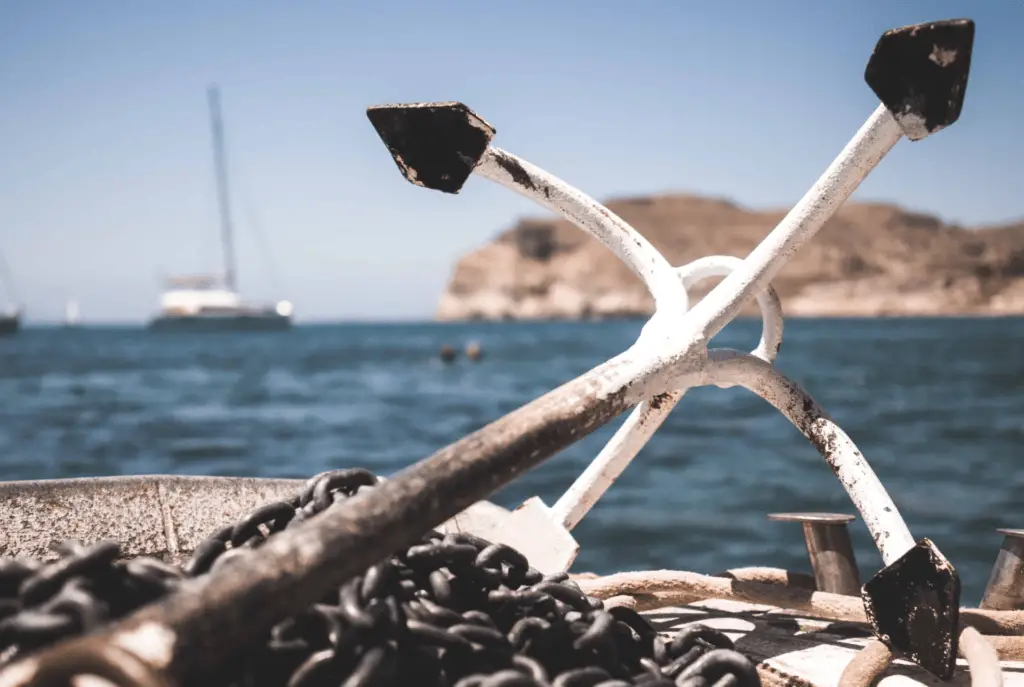
What is anchoring?
Anchoring is a fundamental aspect of boating that involves securing your sailboat in a specific location using an anchor and chain.
When you anchor your sailboat, you are essentially creating a stable and secure position for your boat, regardless of the wind or current.
Table of Contents
Can you anchor a sailboat anywhere?
No, you can’t anchor just anywhere.
- First and foremost, you need to be aware of any regulations or restrictions in the area you plan to anchor.
Some harbors, marinas, or waterways have specific rules regarding anchoring, and it’s important to respect these guidelines.
- In addition, you’ll need to consider the bottom conditions.
Anchoring in rocky or weedy areas can make it difficult for your anchor to dig in and secure your sailboat . Ideally, you’ll want to find a sandy or muddy seabed, as these provide better holding power for anchors .
- Furthermore, you should avoid anchoring in areas with heavy boat traffic.
Not only can this increase the chances of collisions, but it can also make it difficult for you to safely drop and retrieve your anchor.
Choosing the Right Anchor and Chain Size
The size and weight of your anchor will determine its ability to hold your boat securely in place, while the chain provides additional weight and strength to keep the anchor in position.
So, how do you choose the right anchor and chain size for your sailboat?
- First, consider the size and weight of your sailboat .
Larger boats require larger anchors and chains to provide adequate holding power.
As a general rule of thumb, it’s recommended to use an anchor that weighs 1 pound for every 2 feet of boat length.
So, if you have a 30-foot sailboat, a 15-pound anchor would be appropriate.
- Next, think about the type of bottom you’ll be anchoring in.
Different anchor designs work better in different types of seabeds, such as sand, mud, or rocks.
For sandy bottoms, a fluke or plow-style anchor is often recommended, while a grapnel or claw anchor is better suited for rocky bottoms.
Picking the Right Spot to Anchor
Choosing the right spot to anchor your sailboat is essential for a safe and enjoyable experience on the water. Whether you’re planning a short stop or an overnight stay, finding the perfect location can make all the difference.
So, how do you pick the right spot?
- First, consider the depth of the water.
You’ll want to find a spot with enough depth to accommodate the draft of your sailboat, plus some additional clearance to account for tides or changes in water levels.
Consult nautical charts or use a depth sounder to determine the water depth in the area you plan to anchor.
- Next, assess the bottom conditions.
Look for a sandy or muddy seabed, as these provide better holding power for anchors.
Avoid areas with rocky or weedy bottoms, as they can make it difficult for your anchor to dig in and secure your sailboat.
- Consider the surrounding environment as well.
Look for sheltered areas or natural features such as coves or bays that can protect from strong winds or currents . These areas will offer a more comfortable and secure anchorage for your sailboat.
- How Many Anchors Should You Have For Your Boat?
- The Power of Anchors: Why You Should Use Them to Keep Your Boat Safe
- Mooring Made Easy: A Step-by-Step Guide to Picking Up a Mooring for Your Boat
- How To Dock Your Boat Like A Pro: Stern-In, Bow-In, And Alongside
Preparing Your Sailboat for Anchoring
When preparing your sailboat for anchoring, there are several important things you need to do to ensure a smooth and successful docking experience.
Here are four essential tasks to complete before dropping your anchor :
1. Check your equipment: Before setting sail, make sure you have all the necessary anchoring equipment on board.
This includes an anchor, chain, and any additional gear such as a buoy or buoy line. Inspect your equipment to ensure it is in good condition and free of any damage or wear.
2. Secure loose items: Stow away any loose items on your sailboat that could become a hazard during the anchoring process.
This includes things like ropes , fenders, or loose equipment. Secure these items in designated storage areas or tie them down to prevent them from shifting or falling during anchoring.
3. Clear the deck: Remove any obstructions from your deck that could interfere with the anchoring process.
This includes items like cushions, coolers, or other personal belongings.
Clearing the deck will provide you with a clean and clutter-free area to work in when dropping anchor .
4. Prepare your crew: Brief your crew on their roles and responsibilities during the anchoring process.
Make sure everyone knows where to be and what to do when it’s time to anchor.
Assign specific tasks to each crew member, such as handling the anchor or controlling the helm, to ensure a coordinated and efficient docking experience.
The Step-by-Step Guide to Anchoring Your Sailboat
Follow these instructions, and you’ll be able to safely and effectively anchor your boat in no time.
1. Choose your anchor location
Before you start the process, select a suitable location to drop your anchor . Consider factors such as water depth, bottom conditions, and nearby hazards.
Once you’ve chosen the spot, approach it slowly and stop the boat when you’re in the desired location.
2. Prepare your anchor and chain
Make sure your anchor is ready for deployment. Remove any tangles or knots in the chain and ensure it’s securely attached to the anchor.
Double-check that the anchor is properly stored and accessible for deployment.
3. Determine the amount of anchor chain
Decide how much anchor chain you need to deploy based on the depth of the water.
A general rule of thumb is to use a ratio of 5:1 or 7:1 for the length of the anchor chain to the depth of the water. For example, if the water is 10 feet deep, deploy 50 to 70 feet of chain.
4. Drop the anchor
Carefully lower the anchor over the bow of your boat while paying out the chain.
Use a controlled speed and avoid letting the chain drop too quickly, as this could damage your boat or the anchor.
Make sure the anchor hits the bottom before releasing the chain.
5. Set the anchor
Once the anchor is on the bottom, put the boat in reverse at idle speed to ensure the anchor is firmly embedded.
Give it some time to settle and check that the boat is staying in position. Use a landmark on shore or your GPS to monitor any drifting.
6. Secure the anchor
Once you’re confident that the anchor is set, cleat off the chain or secure it to a bow cleat to prevent any accidental movement or slippage.
Double-check that the anchor is holding by slowly reversing the boat to put some pressure on the anchor.
- Congratulations! You’ve successfully anchored your sailboat. Remember to monitor your position and the anchor’s holding power throughout your stay. If you need to reposition or adjust the anchor, follow the same steps in reverse order.
How long can you be at anchor for on a sailboat?
In general, you can stay anchored for a few hours or overnight, but it’s important to check local regulations to ensure compliance.
Some areas have time limits for anchoring or require permits for longer stays.
Additionally, you’ll need to consider the weather forecast. If there are strong winds or rough seas expected, it may not be safe to remain anchored for an extended period.
What side of the vessel you should never anchor?
There is actually one side you should avoid at all costs: the bow , or the front of the boat.
Anchoring on the bow can lead to several problems and safety hazards.
Firstly, it can interfere with the boat’s steering and maneuverability, making it difficult to control the vessel in tight spaces or when approaching docks .
Secondly, anchoring on the bow can cause the boat to swing in unpredictable directions, especially when wind or currents change.
This can increase the risk of collision with other boats, docks, or hazards in the water.
To avoid these issues, always anchor your sailboat off the stern, or the back of the boat. This allows for better control and maneuverability, as well as a more stable anchoring experience.
Additionally, anchoring off the stern keeps the bow free for easy boarding and disembarking, making your sailing experience more convenient and enjoyable.
What happens when a sailboat drag anchor?
When a sailboat drags an anchor, it means that the anchor is no longer holding the boat in place.
This can occur for several reasons, such as changing wind or current conditions, a poorly set anchor, or inadequate anchor line length.
As the boat starts to drift, it can potentially collide with other boats, docks, or even run aground.
In this situation, it’s important to act quickly and calmly.
First, assess the immediate surroundings to determine any potential dangers or obstacles.
Then, try to reset the anchor by moving the boat in the opposite direction of the drift and dropping the anchor again.
If this doesn’t work, you may need to find a new anchorage or consider alternative methods, such as using a second anchor or seeking assistance from nearby boaters.

- Find A School
- Certifications
- North U Sail Trim
- Inside Sailing with Peter Isler
- Docking Made Easy
- Study Quizzes
- Bite-sized Lessons
- Fun Quizzes
- Sailing Challenge

How To: Basic Anchoring and Anchoring Etiquette
By: Zeke Quezada, ASA Cruising Tips , Learn To Sail
Quite a long time ago…decades ago. I sailed over to Catalina Island from my marina near ASA headquarters. I was young. It was my first time embarking across the channel. My crew was a good friend and his cousin who was celebrating his 21st birthday. They drank beers the entire time.
In simple terms, I was a solo sailor. I was also young and irresponsible. Why admit to this? Well, we all were young once and we all made dumb decisions. Own it and learn from it.
Did I understand anchoring? No. Up to that point, I had only ever picked up a mooring ball once in my sailing life. This was way before Youtube videos explained how to drop the hook.
Frankly, ASA bite-sized lesson on Anchoring Basics would have been perfect for me.
ASA 101 Basic Keelboat sailing will prepare you for Basic Anchoring principles. However, let’s refresh some of that knowledge on how to drop and set an anchor on a sailboat.
First, a few basic anchoring tips to start:
- Make sure you know where the anchor is stowed.
- Make sure you know how to get it in the water safely.
- Make sure you know how much rode you need to pay out.
- Make sure you know how to make the rode fast on deck.
Basic Anchoring
Anchors work by digging themselves into the seabed. To do this, they need the rode to pull at an angle closer to horizontal than to vertical.
Anchoring Vocabulary:
- Rode: The rope and/or chain that connects it to the boat
- Scope: The ratio of the length of rode let out to the depth of water.
- Make Fast: To secure, as when typing a line to a cleat.

As you drop the anchor you will need to pay out a significant amount of rode to allow for the rode to pull at an angle that is close to horizontal. This is called the scope. Typically, a 7 to 1 ratio works. This number will get adjusted depending on conditions. (A lesson learned in ASA 103, ASA 104)
To arrive at the right length of rode to let out, you add the height of the boat’s bow above the water to the depth. For example, if the depth is 10 feet and the freeboard at the bow is 4 feet, the length of rode needed for 7:1 scope will be (10 + 4) x 7 = 98 feet.
TIP : “When in doubt let in out” works well in anchoring.
Stand well clear of the anchor rode when letting go of the anchor—anchors are heavy, fall quickly through the water, and the rode can cause, at the least, a nasty rope burn
Anchoring: Step-By -Step
- Approach your chosen spot for anchoring by bringing the boat to a stop, head to wind.
- With the boat stopped, lower the anchor and pay out the rode as the boat blows downwind.
- When enough rode has been let out, make the rode fast.
- The anchor will take hold and the boat will lie head to the wind or current.
- The anchor is set.

Anchoring Etiquette
A few years ago Sail-World.com published a great article on Anchor Etiquette and it is still very relevant.
1. The first boat sets the precedent:
If you arrive in an anchorage and find that all the boats have a stern anchor set, that’s now the rule. If the first one there is a cabin cruiser that yaws all over the place and they have 60 metres of rode out in five feet of water, they have set the precedent. Any subsequent comers will need to give them room.
2. Watch your Wake:
Entering an anchorage or a mooring area is like moving into a new neighborhood. Enter at a slow speed, less than five knots, to avoid making a wake that might upset their sundowner drinks or the bits from the winch they were servicing, or dinner preparations. This also applies to dinghies when traveling close to anchored boats – and in most countries, it’s the law anyway.
3. Give yourself, and other boats room:
Look at the wind in the anchorage and try to work out where the anchors of other boats are lying. Cruise through the anchorage a couple of times to assess the situation. Calling out to find out how much chain the boat has out is an indicator that you are aware of swing patterns and will attempt to place your boat so that it is not in the way of another boat. There’s also some self-preservation here too, as you may want to stay clear of potential party boats, or the boat with that very noisy wind generator. Remember, if he was here first, you are the one who has to move.
4. Watch the ‘Magnet Effect’:
A boat already anchored seems to attract the next boat to anchor right next to it, even though there is an enormous empty bay to anchor in. Try not to do this, and, if you were there first, it is your right to speak to a boat that arrives after you and ask them to move if you feel that they are too close.
5. Buoy your anchor:
In a crowded anchorage, it’s a good idea to buoy your anchor – place a floating marker on your anchor so that you, and others, know where it is. There’s nothing worse than tangled anchors, particularly if you have to make a hasty departure because of deteriorating conditions. (Of course, you have to keep a small watch to make sure your first-time sailor doesn’t arrive and try to pick it up as a mooring ball.)
6. Sound carries far:
Voices, music, engine noise, especially outboard motors, unmuffled go-fast boats, ski boats, jet skis, generators, barking dogs and the dreaded ringing telephone are all examples of the egregious disruption of anchorage serenity. Common sense should prevail in predicting what will not be appreciated and protecting the serenity for the common good.
7. Keep Bow to Cockpit communications civil:
It’s not the anchoring, or the need to re-anchor, which separates the beginners from the experts. It is the amount of yelling and chaos that breaks out between the person handling the anchor and the person maneuvering the boat. Boating is the only sport that requires T-shirts that proclaim ‘Don’t yell at me!’ Either develop a set of hand signals or better still, use some inexpensive walkie-talkies, so that at least your comments on the abilities of your other crew member will be kept on your boat.
8. Think of your neighbors AND the environment:
The smell of burgers on the grill might be a marvelous aroma for most, but really smelly cooking upwind of a boatload of vegetarians may be a cause for some strong sentiments. Don’t go into a crowded anchorage full of pristine water and then not use the holding tank! – It’s really not a good scene for swimmers in the water. And it can ruin your whole day to find yourself swimming with rotten tomatoes or floating banana skins.
9. Be careful with lights at night:
When anchored at night always have an anchor light on (black ball during the day), when looking for an anchorage don’t shine a strong beam directly into another boat’s cockpit, and don’t be the boat that’s lit up like a football field deep into the night when all else in the anchorage are trying to sleep.
Related Posts:

- Learn To Sail
- Mobile Apps
- Online Courses
- Upcoming Courses
- Sailor Resources
- ASA Log Book
- Bite Sized Lessons
- Knots Made Easy
- Catamaran Challenge
- Sailing Vacations
- Sailing Cruises
- Charter Resources
- International Proficiency Certificate
- Find A Charter
- All Articles
- Sailing Tips
- Sailing Terms
- Destinations
- Environmental
- Initiatives
- Instructor Resources
- Become An Instructor
- Become An ASA School
- Member / Instructor Login
- Affiliate Login
No products in the cart.
Sailing Ellidah is supported by our readers. Buying through our links may earn us an affiliate commission at no extra cost to you.
11 Steps To Anchoring Your Sailboat Safely
Knowing how to anchor a sailboat properly is an essential skill every sailor must learn. As a solo sailor, I frequently anchor my 41-foot sailboat alone. With some practice and a good plan, it is pretty simple in most normal situations. However, there are a few things that you need to pay extra attention to and some cases and conditions that require knowledge to get right.
These are the steps to anchor your boat safely:
- Plan and research the location you want to anchor.
- Identify obstacles and hazards in the area.
- Get the anchor ready.
- Locate the spot you want to anchor, preferably a sandy patch.
- Navigate to your place and set the boat up against the wind.
- Aim at your spot and drop the anchor at the bullseye.
- Pay out your scope of chain and rig up your snubber or bridle.
- Tension up the chain and set the anchor.
- Test your ground tackle’s holding.
- If the test fails, pick up the anchor, return to step 4, and repeat the process.
- Optional: Inspect that the anchor is adequately dug into the seabed.
Let’s break down the steps and go into detail.
11 steps to anchor your sailboat safely
Anchoring is a hot topic amongst cruisers, and there are several ways to do it properly. The steps in this guide are guidelines and should give you the theoretical knowledge to understand the process even if the conditions differ. This method is doable alone but is easier with a pair of extra hands. The basics are the same, no matter how many hands you have on deck, though.
How you anchor depends on the weather conditions and if you can see the seabed you want to put the anchor in. It is easiest if you can see what type of bottom you have. If the visibility is terrible, you’re basically throwing spaghetti at the wall to see what sticks.
I have spent many years in the North Sea on commercial anchor handling vessels, installing massive anchors for oil platforms and FPSOs in various conditions. We anchor our sailboats using the same principles but on a smaller scale. My professional experience means that I know a thing or two about anchoring. Years of anchoring Ellidah single-handed, in addition to the above, means I have made some mistakes and learned from them.
1. Plan and research the location you want to anchor
The first step in safe anchoring is planning and research. Gain some knowledge of the place you plan to anchor. Ensure that anchoring is allowed; some areas are protected and illegal to anchor in.
Figure out the level of protection from the weather, water depth, and seabed conditions. Also, make an escape plan in case of emergency – conditions change quickly, and your escape plan may save you and your boat someday.
In the scenario for this guide, we are alone on board and will drop the anchor at 10 meters depth on a small sand patch in an area with a lot of seaweed in moderate wind.
2. Identify obstacles and hazards in the area
The next thing you want to be aware of is if there are any rocks, reefs, shallows, buoys, and other dangers in the area. Your charts often give detailed information about what to expect in the anchorage.
If you use Navionics on your device, the Active Captain community will have valuable information about the anchorage and what to be cautious about. The information is written by other sailors and is invaluable to help you get an overview of the anchorage.
Another app I highly recommend is Navily. Navily informs about anchorage locations, conditions, and protection levels. I actually wrote an in-depth review of these apps that I highly recommend you read!
3. Get the anchor ready
When you have done your planning and research, it is time to get the anchor ready to drop. Put on your autopilot or lock the rudder on a clear course. Head up to the bow and prepare your anchor to be dropped.
I prefer to lower the anchor into the water and hang it below the surface. If you leave it in the air, it might bounce into your bow, and we want to avoid that.
We also don’t want the anchor hanging deep enough to catch on to something before we have found our anchoring spot and navigated the boat into position.
Return to the cockpit when the anchor is ready and take back manual control.
4. Locate the spot you want to anchor
Take the boat for a swipe around the area and look for a sandy area to place the anchor. When you find a good spot, take note of the depth and decide your scope.
Consider your distance from the surroundings, and ensure you have enough room to swing around without hitting anything or bumping into another boat. Please give yourself a little bit of extra space. No one likes it when someone anchors too close to them.
Pro Tip: When we say scope, we refer to the amount of chain you put out in relation to the water depth. I always recommend at least five times the water depth – 5:1 or more, but if you are in a tight anchorage that is well-protected and the seabed holding is good, you may get away with less. I never go lower than 3:1 and always put out a minimum of 30 meters of chain.
5. Navigate to your spot and set the boat up against the wind
Position the boat so you can approach your location with the bow against the wind.
Here comes the tricky part: Depending on how much wind you have and how big of an area you have to drop the anchor in, you need to consider how far the boat will drift in the time it takes you to leave the helm and get up on the bow to start lowering the anchor.
You may want to drive ahead of the spot and position the bow with a slight offset to either side. Now, say you are 10 meters ahead and slightly to starboard of the spot. Stop the boat and turn the bow slightly to the port.
Lock the rudder, head back up to the bow, and get ready to drop the anchor. The wind will catch the starboard side of the bow and push it over to port, and by the time you are prepared at the bow, you should be approaching your spot.
6. Aim at your spot and drop the anchor at the bullseye
As soon as you are positioned at the bow, start paying out the chain, but leave the anchor just above the seabed until it is right above your sandy patch. Once the anchor is in position, land it on the seabed and continue paying out the chain as the boat drifts along.
If you miss the spot, lift the anchor to just below the surface again and reposition yourself.
Don’t stress this step. It is perfectly normal to make several attempts. People on other boats will probably pay attention to you and sometimes even shout, but ignore them for now. You are anchoring and can only do one thing at a time.
Get ready for a new attempt and repeat steps 4 and 5 until you hit the bullseye.
If the entire seabed area is nice and sandy, you can skip step 7 and drop the anchor in any decent position.
7. Pay out your scope of chain and rig up your snubber or bridle
Now that the anchor is placed perfectly in your sandy patch continue to pay out the chain as the wind pushes the boat back. Count the chain length and continue to pay out until you reach your scope of 50 meters for this example.
You may have to stop and wait for the boat to drift if there is little wind or even head back to the helm to reverse the boat. We don’t want to make a pile of chain in one spot, but lay it out nicely.
Once the entire scope of the chain is out, it is time to rig up a snubber.
Pro Tip: A snubber is a rope or bridle you attach to the chain and secure to the boats’ cleats. We use snubbers and bridles to take the load off the windlass. Ideally, we want the boat to hang off strong cleats instead of the windlass.
8. Tension up the chain and set the anchor
Now that your snubber or bridle is rigged up, head back to the helm and put the engine in reverse. Take your time and wait for the chain to get stretched out.
You will feel when the boat comes to a stop, and now is time to make a note of your exact location while you keep the engine at low revs in reverse to keep the tension on the chain.
There are two easy ways to take note of your position:
- Find a spot ashore and another place between yourself and the shore spot that lines up to each other.
- Add a marker to your chart plotter or start a snake trail. I like this method.
Increase the reverse revs on the engine slowly and ensure that the boat stays in the exact location. We want to ensure the anchor isn’t dragging through the seabed. Continue to increase the revs up to the rpm you usually use for motoring at marching speed.
For a Volvo Penta or Yanmar engine, you typically end up at 1800-2200rpm.
9. Test your ground tackle’s holding
Term: ground tackle.
When we say ground tackle, we refer to everything holding the boat to the ground. In this case, it is the snubber, snubber shackle, chain, chain shackle, and anchor. You can learn more in The Sailors Guide to Nautical Terms by clicking this box.
Now, we’re going to test that our ground tackle is holding. Keep the revs up and monitor your two aligned spots or markers on the chart plotter for 30-60 seconds. If you haven’t moved during this period, your anchor has dug into the seabed and is holding.
Slowly ease off the throttle until the engine is back in idle. The boat will start to move forward as the weight of the chain pulls the catenary down. Once the boat stops, the wind will push the bow to the side and swing you over until the chain is stretched up again. Be patient and let the vessel settle.
Well done, you should now be safely anchored! Unless your anchor dragged, which is pretty normal.
10. If the test fails, go back to step 4 and repeat the process
If the anchor breaks loose during the process, you will see that your two aligned spots will start to unalign, or you will drift away from the marker on the chart.
Sometimes, you’ll feel a slight bump in the boat as the anchor loses grip and notice you aren’t holding the same position.
Pro Tip: A good trick is to head up to the bow and put your hand on the snubber or bridle while keeping the reverse tension. You will feel a vibration if the anchor drags through the seabed and hear scratching if the anchor rubs against rocks.
If the test fails and the anchor is dragging, you must take the anchor and chain back up and start over from step 5.
However, if you have made several attempts in the same spot without any luck, you may have to find another location and start again at step 4.
When you get more experience, you will realize that some anchorages can be harder to anchor properly in than others. It is part of the game to have some failed attempts, and I have spent hours and countless attempts on more occasions than I can count.
Do NOT give up until your boat is properly and safely anchored! It is a recipe for disaster, and how people lose their boats. A 50-knot squall may come out of nowhere and surprise you, even on a lovely sunny day. Yes, I speak from experience!
11. Optional: Inspect that the anchor is adequately dug into the seabed
You are usually pretty safe after testing the ground tackle by reversing, but there is one last thing I like to do to be 100% sure that the boat is safely anchored. Now, I cruise in the tropics, where the water is usually clear and delicious, so this step may not apply to you.
Jump in the water with a mask and snorkel, follow the chain to where the anchor is, and ensure it has adequately dug into the seabed. I quite enjoy this exercise, and it gives me great confidence. After countless dives, I know pretty well how my anchor behaves in different seabed conditions.
Optional 2: Have an anchor drink
If you ever sail with a Norwegian, you will probably come by the term “Ankerdram,” which means Anchor Drink. You celebrate a successful anchoring by having a nice beverage of your choice. Since I am Norwegian, I like to practice this tradition with a cold beer!
Final Words
The key to proper and successful anchoring is to do it thoroughly and correctly. If you don’t do it properly, you risk the boat drifting out to sea with or without you onboard. Or even worse, into another vessel or onto the ground!
I was anchored in Ibiza when a charter boat started dragging and crashed into Ellidah without anyone onboard. We handled the situation and saved the charter boat, but the skipper was clueless about anchoring and told me that he usually just dropped the anchor and a bit of chain on top of it, and that was that.
Another time, me and a friend were anchored in the Holandese Keys in San Blas on a gorgeous sunny day. A Backpackerboat was anchored poorly next to us and started to drag rather quickly when a sudden 50-knot squall came through violently. We had a massive choral reef behind us, which the backpacker boat was only inches from hitting.
Don’t be like those guys . Anchor correctly EVERY time!
Take some time to practice and perfect your anchoring skills. Eventually, you will master how to properly anchor a boat like it is the most natural thing in the world. Sometimes, it may take as little as 10 minutes from your start until you have your anchor drink in your hand!
If you want to learn more sailing basics, check out my ultimate beginner’s guide here !
Sharing is caring!
Skipper, Electrician and ROV Pilot
Robin is the founder and owner of Sailing Ellidah and has been living on his sailboat since 2019. He is currently on a journey to sail around the world and is passionate about writing his story and helpful content to inspire others who share his interest in sailing.
Leave a Reply Cancel reply
Your email address will not be published. Required fields are marked *

Anchoring 101: Techniques and Tips for Secure Anchorage
- No Comments
Anchoring is an integral part of the boating experience. Whether it’s a short break to enjoy the surroundings, an overnight stay, or an emergency stop, understanding how to securely anchor your boat is essential for every sailor. A reliable anchorage provides peace of mind, stability, and safety. This article aims to impart a solid understanding of anchoring techniques, covering a range of topics from anchor types and selection criteria to anchoring methods, maintenance, and safety considerations. By the end of this guide, you should be better equipped to make the right anchoring decisions and enjoy a safe and secure boating experience.
Understanding Anchors and Rode

An anchor is more than just a heavy object you drop overboard. It is a carefully engineered device designed to hold a vessel in place even in adverse conditions. There are several types of anchors, each with its unique features and suitable conditions:
- Fluke Anchors (Danforth): Characterized by its flat, fluke-style design, the Danforth is highly effective in sandy or muddy bottoms. Its lightweight and compact design make it a popular choice for smaller boats.
- Plow Anchors (CQR, Delta): These anchors are designed to dig into the seabed and are quite effective in a variety of bottom conditions, including mud, sand, and rock.
- Mushroom Anchors: These are best suited for softer seabeds such as silt or mud. Their design, which resembles a mushroom, allows them to bury into the seabed and provide excellent holding power.
- Grapnel Anchors: Mostly used by smaller boats and kayaks, these anchors are great for rocky or coral bottoms. Their design is not ideal for strong holding, but their lightweight and compact size make them easy to handle.
- Bruce or Claw Anchors: They offer good holding power in most seabeds and are highly resistant to wind and tide changes.

The term “rode” refers to the line connecting the anchor to your boat, and it could be all chain, all rope, or a combination of both .
The choice of rode depends on several factors:
- Boat Size: Larger boats usually require chain rode due to its durability and added weight, which helps in keeping the anchor set.
- Anchoring Conditions: In rocky conditions, a chain rode is preferred because it’s less likely to get cut. In softer seabeds, a rope rode can suffice.
- Depth and Holding Ground: The rule of thumb for rode length is a 5:1 or 7:1 scope, meaning for every foot of water depth, you should have 5 to 7 feet of rode out.
- Storage: Rope is lighter and takes up less space, a factor that can be crucial in smaller boats.
Understanding the differences between these anchors and the factors affecting your rode choice will help you make informed decisions on what’s best for your specific needs.
Choosing the Right Anchor

Selecting the right anchor involves a consideration of several factors. Not all anchors are created equal, and what works well in one situation might be inadequate in another. Here’s what to consider when choosing your anchor:
- Boat Size: Larger boats require anchors with greater holding power. Use your boat’s length and weight as a guide, but consider its windage as well. High-sided boats catch the wind and will need a more robust anchor.
- Bottom Conditions: Different anchors perform best in specific seabed types. For example, a fluke anchor performs well in sandy or muddy bottoms, while a plow anchor is versatile enough to handle various conditions, including rock, sand, and mud.
- Typical Weather and Sea Conditions: If you sail in areas known for their rough weather and high winds, you will need an anchor that can withstand these conditions.
- Storage Space: Some anchors require more storage space than others. Plow anchors, for example, do not stow as compactly as fluke anchors.
- Budget: While it shouldn’t be your deciding factor, the cost of the anchor and its rode is a valid consideration.
Examples of suitable anchor types for different scenarios:
- For a small day-sailer sailing in sandy bottoms, a lightweight fluke anchor might be the best fit.
- A medium-sized cruiser navigating various sea beds could benefit from a plow anchor for its versatility.
- If you’re sailing a large yacht in high windage areas, a heavy plow or claw anchor would be advisable to ensure your vessel remains secure.
Remember, many seasoned sailors carry more than one type of anchor to be prepared for various scenarios. Your choice of anchor can significantly influence your boating experience, affecting your safety and peace of mind. Therefore, it’s essential to make an informed choice based on the unique needs of your vessel and sailing conditions.
Selecting an Anchorage Spot

Finding the right anchorage spot is as crucial as having the right anchor. Below are some factors to consider when choosing where to anchor:
- Depth: You’ll need sufficient depth to allow for tide changes. However, the deeper the water, the more rode you’ll need to let out for a good scope.
- Sea Bed: Sand and mud usually offer good holding grounds for anchors. Rocky or grassy bottoms, on the other hand, can present more challenges.
- Weather: Before you drop the anchor, check the weather forecast. If the wind or current is expected to shift significantly, you’ll need to ensure the spot you’ve chosen is still protected under the new conditions.
- Tide: Take note of the tide and its expected changes. You’ll need to account for how it will affect the depth and your boat’s position.
- Surrounding Hazards: Be aware of any nearby hazards. These might include shallow areas, underwater cables, or busy channels.
- Swing Room: Make sure you have enough space to swing with the wind and tide without hitting anything.
- Distance from Other Boats: Ensure you leave enough space between you and other boats. Remember, different boats can swing differently on the anchor.
Tips for safe anchoring:
- Always lower the anchor slowly and gently to avoid it hitting the bottom with a force that might cause it to bounce and not set correctly.
- When you believe the anchor has set, do a “pull test” by pulling on the anchor rode with the engine in reverse at low RPM.
- Once anchored, take note of reference points in relation to your boat. These can help you know if your anchor is dragging.
- Always set an anchor watch – an alarm that lets you know if your boat drifts outside a certain radius.
Remember, the safety and comfort of your anchorage spot are paramount. You need a place where your anchor will hold, and your boat will be safe from weather and any other potential hazards.
Anchoring Techniques
Anchoring a boat is a skill that improves with practice. Below are the basic steps to deploying an anchor and a brief overview of different techniques for varying conditions.

Steps to Deploy the Anchor:
- Select the Spot: Choose your anchoring location considering the factors discussed above (depth, sea bed, weather, tide, etc.)
- Prepare the Anchor: Ensure the anchor rode is free of tangles and ready to be deployed.
- Approach Slowly: Motor up to your chosen spot slowly and into the wind or current, whichever is stronger.
- Lower the Anchor: Once you’re at the spot, lower the anchor smoothly and gently into the water. Never throw the anchor over as it can lead to tangles.
- Reverse and Set: Once the anchor reaches the bottom, reverse slowly while letting out more rode. When you’ve let out enough scope (usually a ratio of at least 5:1), put the engine in reverse and slowly increase the power to set the anchor.
- Check and Adjust: Check if the anchor is holding by looking at fixed points on the land. If it’s not, you’ll need to reposition and try again. Once the anchor is set, adjust the scope if necessary, considering changes in tide and weather.
Different Anchoring Techniques:
Different conditions and situations call for different anchoring techniques:
- Bow Anchoring: This is the most common form of anchoring where the anchor is deployed from the bow of the boat. This technique is typically used because the bow is designed to cut through waves and is generally the most seaworthy end of the boat.
- Stern Anchoring: This technique is used when you want the stern of the boat facing the shore. This is typically in calm conditions and when the shoreline has a beach.
- Bahamian Moor: This technique involves using two anchors set in opposite directions. This is particularly useful in narrow channels where the tide changes direction.
- Two Anchors Off The Bow: In heavy weather or when the anchorage has a rocky bottom, setting two anchors off the bow can provide extra security.
- Mediterranean Mooring: Common in the crowded harbors of the Mediterranean, this method involves dropping the anchor and then backing toward the dock or quay.
Each anchoring technique has its own strengths and should be chosen based on the conditions and your specific needs. Always ensure your anchor is securely set and remember to keep a watch to detect any dragging.
Setting the Anchor
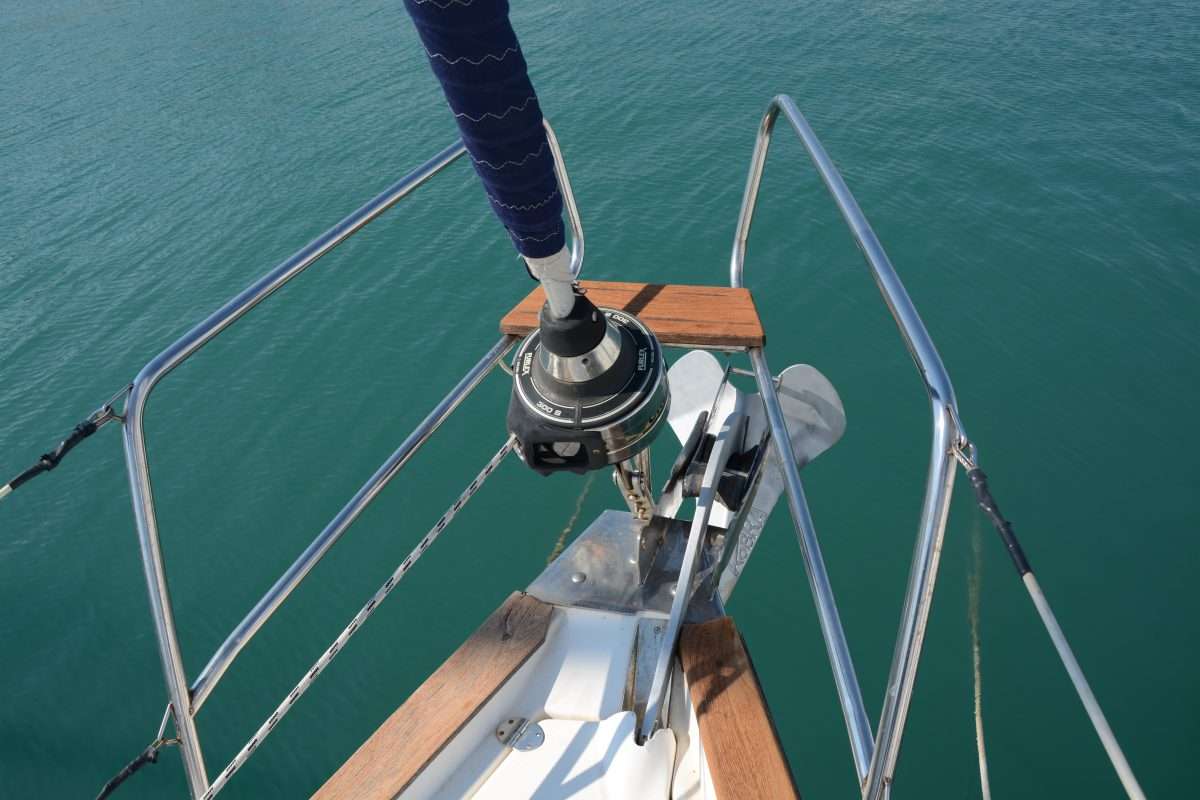
Setting the anchor refers to the process of ensuring the anchor is securely lodged in the seabed, providing a firm hold for your boat. It’s a crucial part of the anchoring process because an improperly set anchor can lead to the boat dragging, potentially causing collisions or running aground.
Here’s how to ensure the anchor is set properly:
Steps to Set the Anchor:
- Slowly Pay Out the Rode: Once the anchor is dropped at your chosen spot, slowly pay out the anchor rode as your boat drifts back with the wind or current. This allows the anchor to descend straight down and lay out properly along the seabed.
- Determine the Right Scope: The ‘scope’ is the ratio of the length of rode you let out to the depth of the water. Typically, a scope of 5:1 is recommended in calm weather, meaning for every foot of water depth, you let out five feet of rode. However, in windy conditions or choppy seas, a higher scope of 7:1 or even 10:1 may be necessary for a more secure hold.
- Set the Anchor: To set the anchor, apply a gradual reverse force to the rode using the boat’s engine. This helps to dig the flukes of the anchor into the seabed.
- Check the Set: To make sure the anchor is properly set, look for fixed points on shore (like a notable tree or rock) and check that your position relative to these points doesn’t change over time. You can also use your boat’s GPS to monitor for any significant movement. If you notice your boat moving, it’s a sign that the anchor isn’t properly set, and you may need to reposition and try again.
- Set an Anchor Watch: Even after the anchor is set, it’s important to continue monitoring for any signs of dragging, especially if the weather conditions change. An anchor watch isn’t just about physically watching; it can also involve setting an alarm on your GPS to alert you if the boat moves out of a defined area.
Remember, setting the anchor isn’t a ‘drop and forget’ process. It requires careful attention to ensure that your boat stays safe and secure.
Monitoring Your Anchorage

Monitoring your anchorage is crucial for ensuring that your boat stays secure. Even the best-placed anchors can sometimes dislodge due to changes in weather, tide, or sea bed conditions. Regular checks can provide early warning of any problems, allowing you to take corrective action if needed.
Here are some tools and techniques you can use to monitor your anchorage:
1. GPS (Global Positioning System): Most modern boats are equipped with GPS, which can be a great tool for anchor watch. You can set an anchor alarm on your GPS to alert you if your boat moves outside a predefined area. This feature is especially useful for overnight anchorages or in conditions of poor visibility.
2. Mobile Applications (For Android and Iphone)
3. Visual Landmarks: Choosing two or three fixed landmarks (such as distinctive trees, buildings, or other features on the shore) and regularly checking your alignment with them can give you a good indication of whether your boat is drifting.
4. Bearing Checks: A more precise version of using visual landmarks is to take bearings of fixed points with a compass. By regularly comparing these bearings, you can detect even small changes in your boat’s position.
5. Rode Tension: Feel the anchor rode (the line or chain connecting the boat to the anchor). If it’s taut, it could be a sign that your anchor is holding firm. However, if the rode becomes slack, it might mean that your anchor is dragging.
6. Depth Sounder: If your boat is equipped with a depth sounder, this can help you monitor whether the water depth changes significantly, indicating a potential drag.
7. Underwater Camera: Some boaters use an underwater camera to visually check the anchor. However, this method might not be practical for all boaters and conditions.
Monitoring your anchorage should be part of your regular routine whenever you’re at anchor. Remember, the key to a secure anchorage is vigilance!
Retrieving the Anchor
After a peaceful time at anchor, it’s time to weigh anchor and set sail again. Here are the steps to retrieve your anchor safely:
1. Preparation: Before you start the retrieval process, ensure your deck is clear of any trip hazards. It’s also a good idea to put on gloves to protect your hands from any rough or dirty anchor rode.
2. Move towards the Anchor: Start your boat and slowly motor towards the anchor while pulling in the rode. The idea is to get directly above the anchor. Using your boat’s engine will ease the load on your windlass or whoever is pulling in the rode.
3. Retrieval: Once you’re above the anchor, continue to haul the rode until the anchor is clear of the sea bed. Be sure to keep a steady speed; going too fast can cause the anchor to swing and potentially damage your boat.
4. Rinsing and Inspection: As you retrieve the anchor, rinse off any mud or debris. This is also a good time to inspect your anchor and rode for any signs of damage.
5. Secure the Anchor: Once the anchor is onboard, secure it properly before moving off.
Troubleshooting Tips for When the Anchor is Stuck:
Despite your best efforts, sometimes the anchor can get stuck. Here’s what to do if that happens:
1. Gentle Motoring: The first thing to try is to slowly motor your boat in the opposite direction to the one you used when setting the anchor. This could be enough to free it.
2. Change the Pull Direction: If that doesn’t work, try changing the direction of your pull. Move your boat around the anchor, giving a gentle pull from various directions.
3. Use a Trip Line: If you have a trip line installed (a line attached to the crown of the anchor and buoyed on the surface), you can pull on this line to free the anchor.
4. Wait it Out: If the anchor is still stuck, waiting for a change in tide or wind direction can often free it. Be sure to monitor your situation closely if you decide to wait.
Remember, safety should always be your priority. If you’re unable to retrieve your anchor, it’s better to cut your losses (and your rode) than to risk damage to your boat or harm to yourself or your crew. Always carry a spare anchor in case you need to leave one behind.
Anchor Maintenance and Storage
Keeping your anchor and rode in good shape is crucial to ensuring they perform well when you need them. Here’s how to maintain and store them properly:
Regular Maintenance Checks
- Inspect for Damage: Regularly check your anchor for any signs of damage. This includes looking for bent flukes, a warped shank, or any signs of corrosion, particularly if you have a steel anchor.
- Check Your Rode: Inspect your rode, whether it’s chain or rope. Look for signs of wear and tear, such as chafed or frayed spots in a rope rode or rust and weak links in a chain rode.
- Cleaning: After each use, rinse your anchor and rode with fresh water to remove any salt, sand, or mud. This is particularly important for metal anchors and chain rodes, which can corrode if left dirty.
- Lubrication: Lubricate moving parts such as the swivel or shackle to ensure they move freely. Use a marine-grade lubricant for this.
Common Issues:
- Corrosion: This is a common issue, particularly with steel anchors or chain rodes. If you notice rust, remove it with a wire brush and then apply a rust-proof coating.
- Wear and Tear: Over time, your rode can weaken due to constant exposure to saltwater and sunlight, as well as friction from the sea bed or the anchor winch.
- Mechanical Failure: Moving parts can seize or break. Regular inspection and lubrication can help prevent this.
Storing Your Anchor and Rode
- Anchor: Most boats have an anchor locker in the bow where the anchor is stowed. If you have a secondary anchor, it should be stowed in a location where it can be quickly deployed if needed.
- Rode: Your rode should be neatly coiled or flaked in the anchor locker to prevent it from tangling. If you have a rope rode, consider using a rope bag.
- Dry Storage: Before long-term storage, ensure your anchor and rode are completely dry to prevent rust or mildew.
- Accessibility: Wherever you store your anchor and rode, they should always be easily accessible in case of an emergency.
Remember, an anchor is a significant investment and, more importantly, a key safety equipment on your boat. Proper maintenance and storage are well worth the effort to ensure it functions properly when you need it.
Safety Considerations

Anchoring, while often routine, can present its own set of risks and safety considerations. Here’s a look at safety equipment related to anchoring and how to handle anchoring emergencies:
Safety Equipment:
- Gloves: Wearing gloves can protect your hands from rope burns and pinch points when handling the anchor and rode.
- Anchor Ball: An anchor ball is a large, round, black shape hoisted to indicate that a vessel is at anchor. This alerts other vessels to your status.
- Rode Marker: These can be useful for indicating how much rode you have out and can help you maintain a safe scope.
- Anchor Light: An anchor light (usually a white light visible 360 degrees around the boat) is required from sunset to sunrise to signal your status to other vessels.
- Sound Signals: In fog or poor visibility, sound signals such as a fog horn can alert other vessels to your presence.
Anchoring Emergencies:
- Dragging Anchor: If your anchor is dragging, it means it’s not properly set. You’ll need to retrieve it and try to set it again.
- Entangled Rode: If your rode becomes entangled with another boat’s or an underwater obstruction, try to free it carefully. In extreme cases, you might need to cut the rode.
- Unable to Retrieve Anchor: If you can’t retrieve your anchor, it may be caught on something underwater. Try changing your boat’s position to dislodge it. If it’s still stuck, you might need to cut the rode as a last resort.
- Unexpected Weather Changes: If weather conditions deteriorate unexpectedly, you might need to reposition your boat or set additional anchors.
- Collision Risk: If another boat is drifting or motoring towards you while you’re anchored, sound your horn and flash your lights to get their attention. Prepare fenders to minimize impact damage.
- Emergency Anchoring: In an emergency, such as engine failure, you may need to deploy your anchor quickly to stop your boat from drifting onto a dangerous lee shore or into other boats.
Always remember, safety should be your number one priority when anchoring. Regular maintenance of your equipment, vigilance while at anchor, and knowledge of what to do in emergencies can help ensure a safe and enjoyable experience.
Additional Resources
To further your understanding and skills in anchoring, here are some additional resources you may find helpful:
- “Chapman Piloting & Seamanship” by Elbert S. Maloney: A comprehensive guide on all aspects of boating, including anchoring.
- “The Complete Anchoring Handbook” by Alain Poiraud, Achim Ginsberg-Klemmt, and Erika Ginsberg-Klemmt: This book provides in-depth information about everything related to anchoring.
- YouTube Channels: Channels like “Sailing Uma,” “Sailing SV Delos,” and “BoatUS” have various educational videos on anchoring techniques.
- US Power Squadrons’ Anchoring Course: A complete course on anchoring, including choosing the right anchor, how to anchor, and troubleshooting.
- RYA Day Skipper Course: The Royal Yachting Association’s Day Skipper course covers practical skills like anchoring.
- BoatUS Foundation : Offers a range of online courses and articles about boating, including anchoring.
- Discover Boating: This website has a helpful section on anchoring basics.
- RYA Knowledge Base: The Royal Yachting Association provides a wealth of articles and resources about all aspects of sailing, including anchoring.
What is the best type of anchor for my boat?
The best type of anchor depends on various factors such as your boat size, the seabed conditions where you typically sail, and typical weather conditions. It's a good idea to carry more than one type of anchor to be prepared for different situations.
How do I know if my anchor is set properly?
Once your anchor is dropped, slowly back away to let out the rode. When enough rode is out, gently put the engine in reverse. If the boat starts to move, the anchor is not set. If the boat stays in place, your anchor is set.
How can I retrieve a stuck anchor?
Try changing your boat's position or gently moving in a circle around the anchor point. If it's seriously stuck, you may need to use an anchor retrieval system or even a professional diver.
How much anchor rode should I let out?
The amount of rode you let out, known as the scope, should be between 5 to 7 times the depth of the water, depending on the conditions. More scope may be needed in stormy conditions.
What should I do if my anchor drags in the middle of the night?
If your anchor drags, you'll need to reset it. If it continues to drag, you may need to find a new anchorage spot or use a different type of anchor.
Leave a Review Cancel reply
You must be logged in to post a comment.
You may also like
Sailing spots.

Sailing Itinerary Corfu, Greece: Corfu – Ionian Islands

Explore Corsica from a Charter Yacht
Yachting basics.

Shark Deterrent Devices: A Comprehensive Overview

Nautical Night Lights
Sailing routes.

Seychelles Sailing Route for Winter Time

Sailing Route in Croatia, from Pula along the East Coast of Istria and the Islands of Cres, Krk, Losinj.
Yacht events, sailing news.

Sharks in the Pacific: The Unprecedented Sinking of the Russian Ocean Way – TION

Riding the Winds of Innovation: Michelin’s Game-Changing Sailing Wing Sets Sail on Commercial Vessels
Faces in yachting.

Joshua Slocum: The Lone Mariner’s Odyssey

Laura Dekker: The Youngest Circumnavigator – A Voyage of Resilience and Dreams
Boat reviews.

- TOP Charter Deals (updated)
- Advertising and Promotion
- Privacy Policy
- Cookie Policy
Please note that some links on our site are affiliate links. This means we may earn a commission at no extra cost to you if you click on them and make a purchase. We recommend products because we believe they add value, not because of the commission we receive. Your support helps keep our site running. If you have questions, please reach out to us.
Privacy Overview
Change location, find awesome listings near you.

Learn how to anchor a sailboat with our step-by-step guide
Alex Morgan
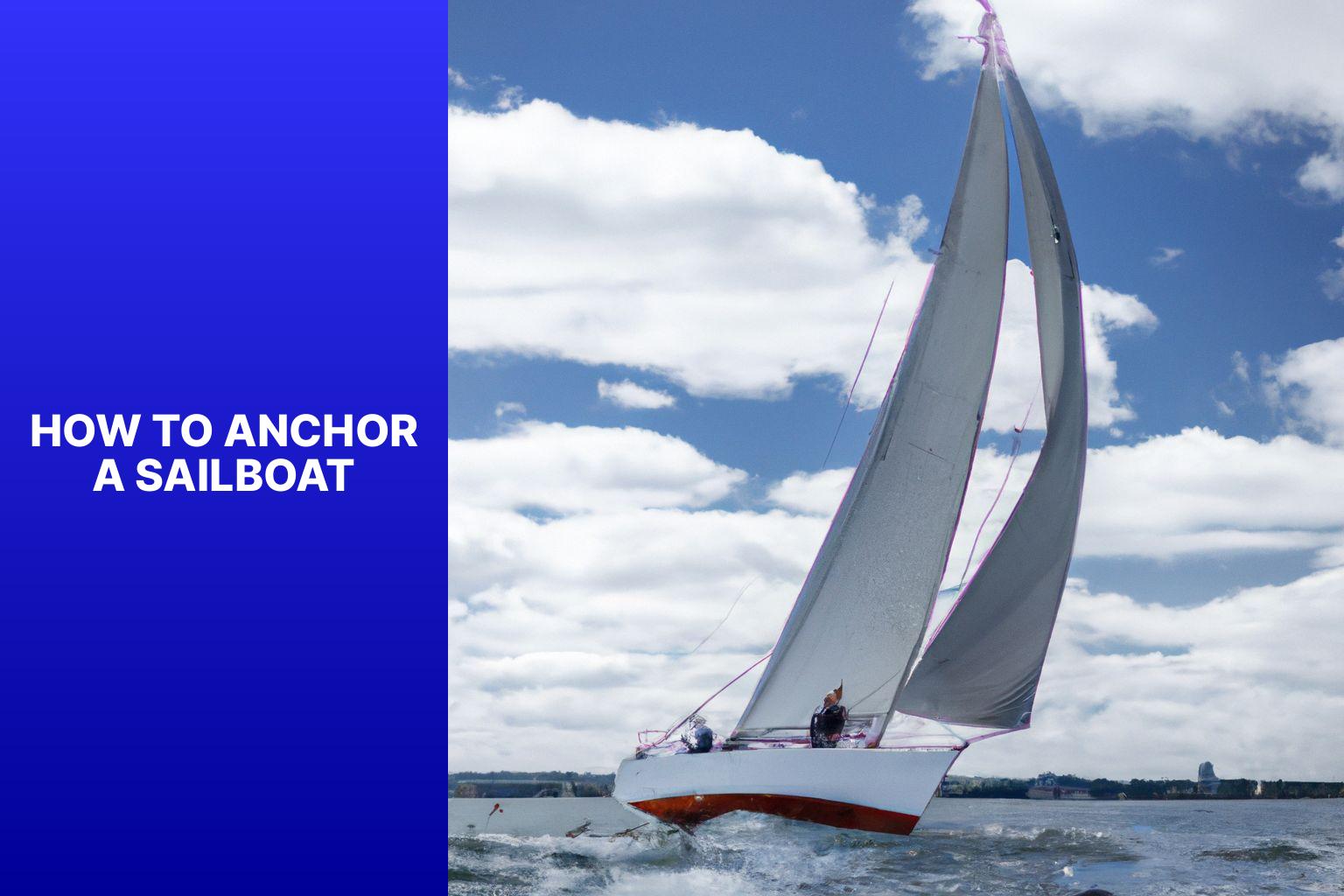
Anchoring a sailboat is a crucial skill that every sailor should master. Proper anchoring ensures the safety and stability of the boat, allowing you to relax and enjoy your time on the water. In this article, we will explore the importance of anchoring a sailboat and provide you with a step-by-step guide on how to do it effectively.
Understanding the Basics of Anchoring is essential before we dive into the details. We will discuss why anchoring is important for a sailboat and the role of an anchor in keeping the boat in place. we will explore the different types of anchors available and how they work, giving you a better understanding of which anchor to choose for your specific needs.
Before you anchor your sailboat, there are several important preparations to consider. Assessing the anchorage area, checking weather and tidal conditions, and gathering the necessary equipment are all crucial steps in ensuring a successful anchoring experience. We will guide you through each of these steps, providing you with valuable insights and tips.
Then, we will provide you with a step-by-step guide on anchoring a sailboat. From approaching the anchorage area to lowering the anchor, setting it, and securing the anchor chain or rode, we will break down each step and provide you with clear instructions.
Once the anchor is set, it is important to monitor and adjust its position as needed. We will discuss how to keep an eye on the anchor, deal with changes in wind and current, and ensure that your sailboat remains in a stable position.
Retrieving the anchor is also an important aspect of anchoring. We will guide you through the preparations for retrieving, pulling up the anchor, and clearing and stowing it properly.
We will provide you with some safety tips to keep in mind while anchoring your sailboat. Safety should always be a top priority, and we will cover essential guidelines to ensure a secure anchoring experience.
By the end of this article, you will have a comprehensive understanding of how to anchor a sailboat effectively and confidently. So, let’s dive in and master the art of anchoring!
Key takeaway:
- Anchoring is crucial for sailboats: Proper anchoring ensures the safety and stability of a sailboat, preventing it from drifting away or colliding with other objects.
- Understanding the basics is essential: Knowing the importance of anchoring, the different types of anchors, and how they work is fundamental for any sailor.
- Preparation is key: Assessing the anchorage, checking weather conditions, and gathering the necessary equipment are vital steps to ensure a successful anchoring process.
Understanding the Basics of Anchoring
Understanding the basics of anchoring is crucial for sailboat owners. Here are some important points to keep in mind:
1. Choose the right anchor for your boat. Options include fluke, plow, and mushroom anchors. Select one that matches your sailboat’s size and weight.
2. Before dropping the anchor , make sure you are in a suitable location with enough depth and a good holding ground. Avoid areas with strong currents or rocky bottoms.
3. Drop the anchor slowly and steadily , allowing it to reach the seabed. Once on the bottom, let out enough anchor rode to hold securely.
4. Attach a buoy or marker to the anchor rode for easier retrieval later.
5. Set the anchor by gently reversing the boat’s engine. This helps it dig into the seabed and create a strong hold.
6. Regularly monitor the anchor to ensure it stays secure. Keep an eye on the depth sounder and check for any signs of dragging.
7. When it’s time to move , raise and secure the anchor before setting sail.
Understanding the Basics of Anchoring ensures the safety and stability of sailboats while at anchor.
1. Why is Anchoring Important for a Sailboat?
Anchoring is crucial for a sailboat for several reasons, including why it is important for a sailboat.
It provides stability and prevents the sailboat from drifting in open waters.
Anchoring ensures safety during rough weather conditions or strong currents, reducing the risk of accidents or collisions.
It also allows sailors to explore different destinations conveniently and cost-effectively .
Anchoring is important for conservation purposes as it minimizes the impact on marine environments and reduces fuel consumption.
When anchoring a sailboat, it is essential to verify the grip of the anchor by applying reverse pressure to ensure a secure hold.
2. What is an Anchor and How Does it Work?
An anchor is a tool that secures a sailboat in one place, preventing it from drifting away due to wind or current.
Anchors work by using their weight to grip onto the seabed, providing a strong hold .
Different types of anchors, such as the plow anchor , fluke anchor , and mushroom anchor , are available depending on specific conditions and the boat’s size.
To deploy the anchor, the sailor approaches the anchorage area and lowers it into the water.
After reaching the seabed, the anchor is set by applying backward pressure to ensure it digs into the bottom .
The anchor chain or rode is then secured to prevent drifting.
To retrieve the anchor, the sailor clears the area and uses a winch or does it manually .
The anchor is cleared of debris and stowed away properly.
Understanding the functionality of an anchor is vital for sailors to ensure their boat’s safety and stability while mooring.
Employing the appropriate anchor and following proper anchoring procedures allows sailors to confidently navigate water conditions.
3. Different Types of Anchors
Different types of anchors provide various features and advantages for different sailing conditions and seabed types. It is important to understand these anchor types in order to select the most appropriate option for your sailboat, ensuring safe and secure anchoring.
Preparing to Anchor
Preparing to drop anchor is a crucial step in safely securing a sailboat. In this section, we’ll lay the foundation for a successful anchoring experience. We’ll dive into assessing the anchorage, navigating weather and tidal conditions, and gathering all the necessary equipment. So, get ready to navigate the waters with confidence as we explore the essential steps for anchoring your sailboat like a pro !
1. Assessing the Anchorage
Assessing the anchorage before anchoring a sailboat is crucial. It involves evaluating the location, depth, bottom conditions, and potential hazards. Here is a table outlining the factors to consider during the assessment:
Assessing the anchorage is crucial for the safety and stability of the sailboat while anchored. By considering factors such as water depth , bottom type , swing room , protection from wind and waves , and proximity to hazards , sailors can make an informed decision about an anchorage’s suitability. Conducting a thorough assessment is essential to avoid accidents or damage to the boat. Choosing the right anchorage can greatly enhance the sailing experience and provide peace of mind on the water.
2. Checking Weather and Tidal Conditions
When anchoring a sailboat, it is crucial to check the weather and tidal conditions for a safe anchorage. Here are some important considerations:
1. Assess the weather forecast: Always check for strong winds, storms, or adverse weather conditions that could affect anchorage safety.
2. Monitor tidal information: Take note of tidal range, currents, and their direction to choose a suitable anchorage.
3. Consider the bottom type: Different seabed types offer varying anchor holding. Check charts or local knowledge to determine the bottom type.
4. Look for protection from waves and swell: Seek an anchorage that provides adequate protection from wave action.
5. Take into account underwater obstacles: Be aware of underwater structures that could pose a risk to the anchor or the boat.
6. Consider other boats and traffic: Ensure enough space for your boat to swing with changes in wind and tide without colliding with other vessels.
By checking weather and tidal conditions and considering the factors mentioned above, you can select a secure and suitable anchorage for your sailboat, ensuring a safe and enjoyable experience on the water.
3. Gathering Necessary Equipment
Gathering Necessary Equipment
When preparing to anchor a sailboat, it is important to gather all the necessary equipment for a successful and safe anchorage. In order to do so, you will need the following items: an appropriate anchor, anchor chain or rode, anchor winch or windlass, anchor buoy, anchor bridle, anchor marker buoy, GPS or chartplotter, fenders and dock lines, and a boat hook.
The choice of anchor should be based on the size of the sailboat as well as the conditions of the seabed. It is important to connect the anchor to the boat using anchor chain or rode for stability, ensuring that it reaches the seabed properly. An anchor winch or windlass will make it easy and efficient to lower and raise the anchor. Attaching an anchor buoy to the anchor chain or rode will not only mark its position but also prevent it from getting stuck. Connecting the anchor chain or rode to the boat with an anchor bridle will provide a secure and stable anchor point.
To prevent other boats from anchoring too close, placing an anchor marker buoy near the anchor will visually indicate its position. GPS or chartplotter can be used as navigation devices to find a suitable area for anchorage and keep track of the boat’s position relative to the anchor. Once the sailboat is anchored, it is important to secure it and protect the hull by using fenders and dock lines . A boat hook will be useful for retrieving the anchor buoy or assisting with other tasks during anchoring.
By gathering all of these necessary equipment items, you can ensure that you are well-prepared and properly equipped for a successful anchoring experience.
Step-by-Step Guide on Anchoring a Sailboat
Drop anchor and secure your sailboat with ease as we dive into the step-by-step guide of anchoring. From approaching the anchorage area to securing the anchor chain or rode, we’ll cover the essential aspects of this essential boating skill. Learn how to master each stage, ensuring a safe and reliable anchoring process for smooth sailing adventures. So, let’s embark on this nautical journey and discover the secrets of anchoring a sailboat like a seasoned sailor.
1. Approaching the Anchorage Area
Approaching the anchorage area, also known as the designated spot for dropping anchor, is a task that requires careful navigation and preparation. To ensure a smooth and successful approach, it is important to follow these steps:
1. Take a moment to acknowledge your surroundings and identify the anchorage area. This will help you plan your approach.
2. Select a safe and suitable approach path, considering any obstructions or shallow areas that may pose a risk to your sailboat.
3. Before proceeding, check for any other boats that may already be anchored in the area. This will help you avoid any potential collisions or overcrowding.
4. Reduce your speed as you approach the anchorage area. This will give you better control over your sailboat during the process.
5. Keep a lookout for other boats or any hazards that may be nearby. This will help you navigate safely and avoid any potentially dangerous situations.
6. If necessary, communicate with other sailors in the area to coordinate your entry into the anchorage. This will help ensure a smooth and organized process.
7. Be sure to follow any local rules or regulations that may apply to anchoring in the area. This will help maintain a harmonious environment for all sailors.
8. Before dropping anchor, prepare your anchor and any necessary equipment. This will help streamline the deployment process.
9. When choosing a suitable spot within the anchorage area, take into consideration the wind direction and the presence of nearby boats. This will help ensure a safe and secure location for your sailboat.
10. Make sure there is enough room for your sailboat to swing and that the water depth is appropriate. This will prevent any potential damage to your boat or other boats in the area.
11. Approach the selected spot slowly and carefully, ensuring that you maintain control over your sailboat at all times.
12. Position your sailboat in a controlled manner while preparing to drop the anchor. This will help ensure a smooth and precise descent.
13. Before lowering the anchor, double-check your position and alignment with the selected spot. This will help avoid any misplacements.
14. Signal your crew or passengers to be ready to secure the anchor once it is dropped. This will help expedite the process.
15. Lower the anchor smoothly and slowly to avoid excessive drag or tangling. This will help ensure a proper set.
16. Monitor the depth gauge and observe any signs of proper anchor settling. This will help you assess the effectiveness of the anchor deployment.
17. As the sailboat drifts back slowly, release the anchor rode once it reaches the seabed. This will allow the anchor to take hold and secure your sailboat.
18. Gradually increase tension on the anchor rode as the anchor takes hold and the sailboat settles. This will help stabilize your sailboat in the anchorage area.
19. Secure and cleat off the anchor rode to keep the anchor in place. This will provide additional security and stability to your sailboat.
By following these steps, you can approach the anchorage area in a safe and organized manner, ensuring a smooth and successful anchoring experience.
2. Setting a Suitable Scope
The act of establishing a suitable scope is significant when it comes to securing a sailboat in place. Various factors, including water depth, weather conditions, and seabed type, should be taken into consideration.
For calm conditions, it is generally advised to adhere to a 5:1 scope ratio, which means using 5 feet of anchor line for every 1 foot of depth. In rough conditions, a higher scope ratio of 7:1 or more might be necessary to ensure greater holding power. To provide extra security during strong winds or adverse weather conditions, it may be beneficial to increase the scope to 10:1 or higher.
The type of seabed plays a role in the anchor’s ability to hold, with soft or muddy bottoms requiring a longer scope for optimal penetration and holding capabilities. By setting the appropriate scope, sailors can prevent the anchor from dragging and guarantee the safety of the sailboat. This allows the anchor to embed itself into the seabed and deliver the required holding power.
Determining the suitable scope can be done by evaluating water depth, weather conditions, and seabed type. The correct scope has a profound impact on sailboat stability and security, offering peace of mind to sailors while at anchor.
3. Lowering the Anchor
When lowering the anchor for a sailboat, follow these steps:
- Securely attach the anchor to the anchor line.
- Position the sailboat in the desired anchorage area, considering wind direction and water depth.
- Slowly release the anchor by loosening the anchor line for the purpose of lowering the anchor.
- Continuously monitor the depth gauge or sounder to determine the precise location to stop lowering the anchor.
- Once the desired depth is reached, secure the anchor line to a cleat or windlass on the sailboat.
- Ensure the anchor is well-set by applying tension gradually to the anchor line while in the process of lowering the anchor.
- Check the sailboat’s movement and any indication of dragging to confirm if the anchor is holding after lowering the anchor.
- Adjust the anchor line tension or relocate the sailboat if necessary to improve anchorage after the process of lowering the anchor.
4. Setting the Anchor
Setting the anchor is crucial in anchoring a sailboat. To anchor your sailboat effectively and ensure safety and stability, follow these steps:
1. Approach the anchorage area slowly and carefully.
2. Choose a suitable scope, which is the ratio of anchor rode length to water depth. A common scope is 7:1 , meaning seven times the depth.
3. Lower the anchor steadily and smoothly , ensuring it doesn’t drag or get stuck.
4. Once the anchor reaches the seabed, let the boat drift back with the wind or current while keeping the rode tensioned .
5. Set the anchor firmly into the seabed by slowly reversing the boat’s engine.
6. Secure the anchor chain or rode to prevent tangling or obstacles .
7. Monitor the anchor position for security . Pay attention to changes in wind or current, as they can affect holding power.
8. When retrieving the anchor, prepare properly. Slowly pull up the anchor using the boat’s windlass or manual winch. Clear any debris from the anchor and stow it securely.
By following these steps, you can effectively set the anchor for your sailboat.
5. Backing Down to Set the Anchor
When it comes to setting the anchor for a sailboat, the process of backing down is absolutely crucial in order to ensure that the anchor is properly set and securely in place. To help guide you through this important process , here is a step-by-step breakdown of how to back down and set the anchor:
1. Begin by positioning the boat upwind or up current from the desired location for the anchor.
2. Slowly engage reverse gear, applying gentle power astern to gradually begin the process of backing down.
3. While doing so, it’s important to keep a vigilant lookout for the anchor line as it pays out.
4. As you continue to back down, gradually increase the power in reverse to create tension on the anchor line.
5. Keep a close eye on the anchor line to ensure that it remains taut, without any signs of dragging along the seabed.
6. Once the anchor line has been fully extended and the boat has significantly backed down, shift into neutral gear.
7. At this point, allow the boat to naturally drift back with the wind or current while maintaining tension on the anchor line.
8. Throughout this process, it’s essential to monitor the position of the anchor to ensure that the boat remains stable and secure.
The importance of backing down to set the anchor is exemplified by a true story. In this incident, a sailor dropped the anchor in a strong current but failed to properly back down. As a result, the anchor ended up dragging along the seabed, causing the boat to drift into a potentially dangerous situation. This serves as a powerful reminder that backing down is essential in order for the anchor to effectively dig into the seabed and securely hold the boat in place.
6. Securing the Anchor Chain or Rode
Securing the anchor chain or rode is of utmost importance for anchoring a sailboat and preventing drift. It is essential to follow these steps to secure the anchor chain or rode:
- Attach the anchor chain or rode to the boat’s anchor locker or cleat using a suitable attachment point.
- To achieve the proper scope , which is the ratio of anchor line length to water depth, release additional chain or rode. It is recommended to aim for a scope of 5:1 or higher for better holding power.
- To absorb sudden shocks on the anchor chain or rode and reduce strain on the boat and anchor, use a snubber .
- Regularly monitor the slack in the anchor chain or rode to ensure proper tension and make necessary adjustments.
- Consider using a kellet or sentinel , which is a weight attached to the anchor chain or rode, to maintain the correct angle and tension.
- To prevent accidental release, secure the bitter end of the anchor chain or rode using a suitable knot or a chain stopper.
- Use a buoy or float to mark the anchor’s position, making retrieval easier.
By effectively securing the anchor chain or rode, the sailboat remains securely anchored, providing stability and peace of mind on the water.
Monitoring and Adjusting the Anchor
When it comes to anchoring a sailboat, one crucial aspect is monitoring and adjusting the anchor. We’ll explore two key sub-sections in this realm: keeping a close eye on the anchor position and effectively handling changes in wind and current . So, let’s dive in to discover the vital techniques and strategies to ensure a secure and successful anchoring experience for your sailboat.
1. Keeping an Eye on the Anchor Position
When anchoring a sailboat, it is crucial to keeping an eye on the anchor position for security. Follow these steps:
1. Choose a fixed reference point on land or a nearby object to continuously monitor the anchor position.
2. Regularly check the alignment of the boat with the reference point to determine if the anchor is holding or if the boat is dragging.
3. Use GPS or chart plotter systems, if available, to accurately track the boat’s position and keep an eye on any changes.
4. Pay attention to wind direction and strength, as they can impact the boat’s movement and the anchor’s holding power.
5. Observe other boats in the area to keep an eye on any dragging or anchor-related issues.
6. Adjust the anchor or reposition the boat if necessary, based on carefully keeping an eye on the anchor position and changing conditions.
7. Keep communication tools, such as VHF radio or cell phone, easily accessible in case of emergencies or the need to call for assistance.
Pro-tip: Continuously keeping an eye on the anchor position ensures the safety of the boat and crew, providing peace of mind during anchoring.
2. Dealing with Changes in Wind and Current
– Regularly Monitor Wind and Current Conditions: It is important to regularly monitor wind and current conditions when your sailboat is anchored. This will help you to be aware of any changes that may occur, which can affect your boat’s position and stability. By keeping an eye on these conditions, you can adjust your strategy accordingly.
– Maintain a Secure Anchor: One of the most crucial aspects of anchoring is ensuring that your anchor is securely set and properly dug into the seabed. A well-set anchor provides the necessary stability and resistance against changes in wind and current. If you notice any dragging or slipping of the anchor, it is imperative to take immediate action.
– Use Additional Anchoring Techniques: When faced with challenging wind and current conditions, it may be necessary to employ additional anchoring techniques to enhance stability. One such technique is using a second anchor known as a “kedge” anchor. Another option is deploying a stern anchor, which can provide extra resistance.
– Adjust Scope: To optimize the performance of your anchor, it is important to adjust the scope, which refers to the ratio between the length of the anchor rode and the water depth. Increasing the scope can provide more holding power, while reducing it can aid in stabilization.
– Consider Swinging Room: It is essential to allow sufficient swinging room for your sailboat to rotate around its anchor without any obstacles. In areas where there are significant changes in wind and current, it is necessary to adjust your anchoring position to avoid any potential collisions.
Retrieving the Anchor
Preparing to retrieve an anchor from the deep blue is no ordinary task. In this section, we’ll explore the art of anchoring a sailboat, focusing specifically on retrieving the anchor . Brace yourself as we uncover the essential preparations , the strength required for pulling up the anchor, and the critical process of clearing and stowing it away. Get ready to set sail with confidence as we impart the knowledge and techniques needed to master the art of anchor retrieval.
1. Preparations for Retrieving
Here are the preparations for retrieving the anchor:
- Assess environmental conditions: Before retrieving the anchor, assess the current weather and tidal conditions to ensure a safe retrieval. Check for changes in wind speed or direction that may affect the process.
- Clear the area: Remove any obstacles or debris around the anchor to ensure a smooth retrieval. This will prevent the anchor from getting caught or tangled.
- Prepare necessary equipment: Have gloves , a boat hook , and a winch or windlass ready for the retrieval. These tools will help you safely and efficiently pull up the anchor.
- Communicate with the crew: Coordinate with crew members and assign specific roles for the retrieval process. Clear communication is essential to ensure everyone is ready and knows their responsibilities.
- Determine the anchor position: Use GPS or landmarks to locate the anchor’s position before starting the retrieval process. This will help you maintain control and prevent damage to the boat or anchor chain.
Remember, prioritize safety when retrieving an anchor. Assess conditions, prepare equipment, and communicate effectively with your crew for a successful retrieval.
2. Pulling Up the Anchor
When pulling up the anchor on a sailboat, follow these steps:
1. Prepare the boat: Inform all crew members of the anchor retrieval and secure any loose items on deck.
2. Position the boat: Move closer to the anchor while maintaining a safe distance to prevent the anchor chain from tangling.
3. Communicate: Assign one crew member to the helm and another to the anchor windlass controls.
4. Turn on the windlass: Activate the windlass motor and select the appropriate gear for anchor retrieval.
5. Start pulling: Use the windlass controls to initiate the anchor retrieval. Maintain a steady pace and be attentive to any unusual sounds or vibrations.
6. Monitor the anchor chain: Keep a close watch on the anchor chain as it emerges from the water, ensuring it is not twisted or tangled.
7. Clean and secure: After fully retrieving the anchor, rinse off any mud or debris and store it in the designated area.
In a similar tone, let me share a true story. During a sunny afternoon, as we pulled up the anchor, our crew spotted a curious seal popping its head above the water to get a closer look at our boat. It appeared to be bidding us farewell, creating a magical moment that reminded us of the beauty and wildlife we encounter while sailing.
3. Clearing the Anchor and Stowing
To effectively clear the anchor and stow it on a sailboat, here are the step-by-step instructions:
1. Raise the anchor: Utilize either the windlass or manually pull up the anchor using the anchor line or chain. Remove any debris or seaweed from the anchor as it emerges.
2. Rinse and clean the anchor: Once aboard the boat, rinse the anchor with fresh water to eliminate salt or dirt. This action serves to prevent corrosion and maintain the anchor’s optimal condition.
3. Secure the anchor: Safely fasten the anchor in place on the boat using anchor chocks or a bracket. This precautionary measure ensures that there is no movement which could potentially lead to damage or injuries while sailing.
4. Stow the anchor chain or rope: Neatly coil the anchor chain or rope and securely store it in a designated locker or storage area. Keep it separate from other equipment to prevent tangling or any possible damage.
5. Check for damage: Thoroughly inspect the anchor for any signs of wear or damage. If any issues are identified, promptly repair or replace the anchor to guarantee its proper functionality in the future.
Interesting Fact: The weight of an anchor can significantly vary depending on the size of the boat and the conditions in which it is used. For instance, a smaller sailboat might require a 10-20 pound anchor, whereas a larger yacht might necessitate a several hundred pound anchor to ensure sufficient holding power.
Safety Tips for Anchoring a Sailboat
When anchoring a sailboat, prioritize safety. Follow these tips for a safe anchoring experience:
1. Choose the right anchor: Select an anchor suitable for your sailboat’s size and type. Consider the anchor’s weight and holding power to withstand various weather conditions.
2. Check the anchor and chain: Inspect the anchor and chain for signs of damage or rust. Ensure the chain is securely attached to the anchor and in good condition.
3. Find a suitable anchoring spot: Look for a spot with good holding ground, away from obstructions and high traffic areas. Check the depth and bottom conditions for stability.
4. Approach the anchoring spot slowly: Approach the spot at a slow speed and remain vigilant for other vessels or obstacles in the area.
5. Lower the anchor gradually: Lower the anchor slowly and steadily while keeping the boat in reverse. This helps the anchor dig properly into the seabed.
6. Set the anchor: Once the anchor is dropped, allow the boat to reverse while keeping tension on the anchor chain to firmly set it into the bottom. Confirm the anchor’s security by checking landmarks against the boat’s position.
7. Monitor anchor holding: Regularly check the boat’s position and ensure the anchor is securely holding. Be aware of any changes in wind or current that may affect the anchor’s position.
8. Have an emergency plan: Always have a plan in case the anchor starts to drag. Be prepared to re-anchor, seek shelter, or take necessary actions for the safety of the boat and crew.
In 1588, during the Spanish Armada, a Spanish galleon successfully anchored in Ireland to escape the English fleet. The anchor, known as the “Barbante” anchor, was recovered from the sea in 1981 and is now displayed in the Old Head of Kinsale Museum in Ireland. It serves as a reminder of the importance of proper anchoring and its role in historical maritime events.
Remember, following these safety tips for anchoring a sailboat ensures a smooth and secure experience on the water.
Some Facts About How To Anchor A Sailboat:
- ✅ Picking a good anchorage is crucial before dropping anchor. (Source: lifeofsailing.com)
- ✅ Planning and research are crucial before anchoring, including understanding weather conditions, water depth, and seabed conditions. (Source: sailingellidah.com)
- ✅ The anchor should be dropped at the desired spot, paying out the chain as the boat drifts along. (Source: sailingellidah.com)
- ✅ The holding of the anchor should be tested by monitoring the boat’s position for a period of time. (Source: sailingellidah.com)
- ✅ Good anchoring etiquette should be followed when anchoring near other boats to avoid collisions or entanglements. (Source: liveabout.com)
Frequently Asked Questions
Faqs on how to anchor a sailboat:, 1. what factors should i consider when picking a good anchorage spot.
When picking a good anchorage spot, it is crucial to consider factors such as wind direction, tidal currents, and the forecast. Look for a spot with protection from wind and waves and a sand or mud bottom. Ensure the spot is a few feet deeper than the draft of your boat during low tide.
2. How much chain should I let out when anchoring?
As a safety measure, it is recommended to let out at least 6 times the water depth, also known as the scope. The scope ensures that the anchor is properly set and holds the boat securely.
3. What steps should I follow when anchoring a sailboat?
The steps to anchor a sailboat are as follows: – Position the boat where you want to anchor and drop the anchor slowly. – Let the boat drift back gradually as you pay out chain, setting the scope as you go. – Secure the anchor chain on deck once sufficient chain has been let out. – Wait for the anchor to dig in and take its initial set. – Slowly move astern until the anchor chain straightens out. – Pay careful attention to the chain while moving the boat to check for dragging. – Use a snubber and let out more chain if everything seems alright.
4. How do I verify if my anchor is dragging?
To verify if your anchor is dragging, you can check the tension in the anchor rode. If there is little or no tension, it indicates that the anchor may be dragging. It’s important to periodically check for changing conditions that may cause the anchor to drag.
5. What precautions should I take to properly set the anchor?
To ensure the anchor sets properly and to avoid drifting into rocks or other boats, it’s important to: – Double-check the anchor before going to sleep to ensure it is properly set. – Take precautions to ensure the anchor is well dug into the seabed and holding securely. – Check periodically for changing conditions that may impact the anchor’s holding ability.
6. What are some additional tips for anchoring a sailboat?
Some additional tips for anchoring a sailboat include: – Use the right type of anchor for different seabeds and be familiar with their functioning. – Match the anchor size to the size of your boat to avoid dragging. – Lower the anchor slowly to prevent fouling and potential dragging. – Check periodically for changing conditions that may cause the anchor to drag. – Use methods such as GPS or a noise maker tied to a secondary anchor to detect dragging.
About the author
Leave a Reply Cancel reply
Your email address will not be published. Required fields are marked *
Save my name, email, and website in this browser for the next time I comment.
Latest posts

The history of sailing – from ancient times to modern adventures
History of Sailing Sailing is a time-honored tradition that has evolved over millennia, from its humble beginnings as a means of transportation to a beloved modern-day recreational activity. The history of sailing is a fascinating journey that spans cultures and centuries, rich in innovation and adventure. In this article, we’ll explore the remarkable evolution of…

Sailing Solo: Adventures and Challenges of Single-Handed Sailing
Solo Sailing Sailing has always been a pursuit of freedom, adventure, and self-discovery. While sailing with a crew is a fantastic experience, there’s a unique allure to sailing solo – just you, the wind, and the open sea. Single-handed sailing, as it’s often called, is a journey of self-reliance, resilience, and the ultimate test of…

Sustainable Sailing: Eco-Friendly Practices on the boat
Eco Friendly Sailing Sailing is an exhilarating and timeless way to explore the beauty of the open water, but it’s important to remember that our oceans and environment need our protection. Sustainable sailing, which involves eco-friendly practices and mindful decision-making, allows sailors to enjoy their adventures while minimizing their impact on the environment. In this…

7 Best Sailboat Anchors

Last Updated by
Daniel Wade
June 15, 2022
As long as it's the right one, your sailboat anchor is the best insurance you'll ever buy.
The right sailboat anchor will depend on the type and size of your sailboat, your planned area of sailing, and the weather conditions that you expect to encounter. So there are no shortcuts but to choose the best sailboat anchors based on these factors.
Anchoring, at its core, is all about securely fastening your sailboat using the best sailboat anchor so that it doesn't float away when the winds or tides start shifting.
And whether you're planning for a day's fishing trip to your nearest lake or going for an offshore voyage, an anchor is unquestionably essential in ensuring the safety of both you and your sailboat.
A good anchor not only gives you the much-needed peace of mind but gives you the ability to securely anchor your sailboat on a nice bay, grab a quick lunch, or explore the nearby reefs.
More importantly, you'll appreciate the importance of choosing the best sailboat anchor for your boat when you have to ride out a storm.
There are lots of excellent sailboat anchors that are a great fit for your boat. The most important is to understand what makes a high-quality anchor so that you can make an informed choice when buying the best sailboat anchor for you and your vessel. This will depend on things like the size and type of your sailboat, where you want to sail to, and the projected weather and the type of bottom of where you'll be sailing at.
Needless to say, there are a lot of sailboat anchors out there that it can be very confusing. In this article, we'll discuss how to choose the best sailboat anchor for your boat. More importantly, we've done thorough research and review the best sailboat anchors just to make the process of choosing the best sailboat anchor for you as easy as possible.
Table of contents
How to Choose the Best Sailboat Anchor
Choosing the best sailboat anchor on various things such as the type and size of your boat, the type of bottom where you're planning to anchor your boat on, the weather conditions, and many more. For example, anchoring a 24-feet sailing boat on a muddy bottom will not be the same when using the same anchor when anchoring a 49-feet sailboat on a rocky bottom. More importantly, choosing the best sailboat is all about finding the right balance in terms of the size of your boat, the type of the bottom where you're sailing at, the climate conditions, and the amount of time that you're planning to be anchored.
Here is what you need to consider.
The Size of Your Boat
The size of your boat will determine the type of anchor that's appropriate based on its weight and resistance. For example, a claw anchor can be great for boats measuring between 16 feet and 50 feet. In essence, having a bigger boat will require an anchor that is bigger and has more holding power. On the other hand, a smaller anchor with less holding power will be ideal for a smaller boat.
Your Anchoring Time
The holding power of your anchor can be affected by the amount of time you are planning to anchor your boat. If you're planning to anchor your boat for longer periods, it would make a lot of sense to have an anchor with high holding power. Differently, you can go with an anchor with less holding power if you're planning to anchor your boat for a few hours.
The Bottom Type
The shape and sharpness of an anchor will determine how good an anchor can hold your boat in different types of bottoms. For example, claw anchors can struggle in rocks and corals but work perfectly in sand and mud. On the contrary, grapnel types of anchors can work great in rocks but don't work in sand or mud. It all depends on the bottom type of the area you're planning to sail at.
Anchor Material
The type of material used in manufacturing the anchor is of great importance in terms of its functionality, reliability, and durability. Most anchors are galvanized to prevent them from rust and also for a better price. However, stainless steel anchors offer better anchors in terms of quality and aesthetics.
Without further ado, let's jump straight in.
1. Lewmar Galvanized Delta Sailing Anchor
(Best for Larger Boats)
Although several modern types of sailboat anchors have taken the anchor industry by storm, some traditional anchor designs still hold their ground today and the Lewmar Galvanized Delta Sailing Anchor is one of them. It's designed with a single, sharply pointed wedge fluke that has a similar shape to a plow and really gets into the ground. It digs down and holds so secure for larger boats measuring over 21 feet.
This is a superb sailboat anchor that performs exceptionally well on most bottom types save for rocks. You'll love the fact that it holds extremely well in softer bottoms such as sand and mud. This anchor is made from high-grade manganese steel and is galvanized with a protective layer of zinc to prevent it from rusting. It's also more light than most anchors so stowing and transportation shouldn't be a problem.
Having been a hallmark anchor for many years, this anchor guarantees reliability and will hold excellently even in stormy conditions. Launching it is also easy thanks to its ballasted tip and streamlined shank and will set the first time thanks to its self-righting design.
- Perfect for larger boats
- Very durable
- Approved by several National Lifeboat Associations
- Comes with a perpetual guarantee against breakage
- Easy to launch
- Very secure
- Quite expensive
- Requires tripping line to release it from the seabed
- Not great for rocky bottom
2. Rocna Vulcan Galvanized Anchor
(Best for Changing Weather Conditions)
As the best-selling sailboat anchor currently available in the market, it's easy to see why the Rocna Vulcan Galvanized Anchor is the most highly rated anchor by multiple independent reviewers. Built for strength and versatility, this anchor works great with a wide range of boats, which is a very unique feature. Coming in sizes ranging from 9 to 606 pounds, this anchor is so versatile and gives you the option of choosing the right size for your sailboat.
This remains the most dependable anchor in the market, especially in the roughest of conditions. It holds all types of the seabed so fast and has a roll bar that's crucial in ensuring that your boat's weight is not only distributed appropriately but the boat sets at the right angle. Its Vulcan design and sharp tip allow it to snug fit on the bow and to get right into the seabed respectively.
This is an anchor that draws the best features from traditional sailboat anchors such as spade and bagel anchors to become one of the best modern sailboat anchors out there.
- Perfect for stormy conditions
- Great for all types of seabed
- Very versatile and available in a wide range of sizes
- Perfect for all types of boats
- It has an easy storage design
- It's designed by a well-known brand
- Very expensive
- Its shank is only perfect for bigger flukes
3. Manson Galvanized Supreme Sailing Anchor
(The Fastest Setting and Highest Holding Anchor)
If you're looking to purchase the best sailboat anchor from a well-established brand, look no further than the Manson Galvanized Supreme Sailing Anchor. This anchor has been in the market for the better part of the last two decades and still holds its ground as one of the best sailboat anchors out there. The fact that it is perfect for all types of seabed makes it a great option for sailors who are on a budget.
This sailboat anchor has an indisputable reputation all over the world as the fastest setting and highest holding anchor. This is because it's uniquely designed for extreme holding conditions thanks to its standard bow rollers and a dual operation shank that's designed with the utmost versatility in mind. Whether you're looking to anchor in mud, sand, or rocky areas, this anchor will never disappoint you.
- It has an extremely high holding power
- It's the fastest setting anchor in the market
- It's perfect for all types of seabed including rocky areas
- Its safety is guaranteed as it has passed multiple tests
- It's very durable
- Designed for extreme weather conditions
- It's heavy, which can bring difficulties in stowing and transportation
- Very expensive
4. Danforth S-600 Standard Sailing Anchor
(Best for Smaller Boats)
At this point, you shouldn't have any doubt that some of the more traditional types of anchors still have a place in the anchor industry today. The Danforth S-600 Standard Sailing Anchor is a traditional fluke anchor that's extremely perfect for smaller boats but can also be used as a secondary anchor for larger boats. Having been developed in the US back in the 1940s, this type of anchor is similar to the modern CQR anchor and doesn't compromise on quality and reliability even in rough weather conditions.
It's lighter than most anchors, so stowing or transporting it shouldn't be a problem. In terms of its holding power, it has an excellent power-to-weight ratio and can hold quite fast in sand and mud. The fact that it is a fluke type of anchor makes it not perfect for coral, rock, or gravel bottoms.
- Perfect for smaller boats
- It's good for sandy and muddy substrates
- Lightweight and compact
- Has a holding power of about 600 pounds
- Constructed with high-strength galvanized steel
- Quite affordable
- Not ideal for rock, coral, or gravel substrates
- Can only be used as a secondary anchor on larger boats (over 27 feet)
- It has moving parts
5. Lewmar Claw Anchor
(Best for All Types of Seabed)
If you're looking for the best sailboat anchor that will serve you perfectly in all types of substrates, the Lewmar Claw Anchor can be an ideal choice. Previously known as the Bruce or Claw type anchor, this anchor has a three-pronged design that enables it to easily set in any bottom. It doesn't matter whether you want to anchor in an area with mud, sand, rock, coral, gravel, or grassy bottom, this anchor will hold its ground.
It can be a great option if you're on a tight budget and want to buy an anchor that doesn't have a complete design while going about its duty quietly. It's so versatile thanks to the fact that it's available in sizes ranging from 4.4 pounds to 44 pounds. What's more; it's made from high-grade steel and it's very durable. If anything, it draws inspiration from the anchors used in securing oil rigs in the North Sea.
- Excellent for all types of substrates
- It's very versatile
- It's durable
- It's very affordable
- Its odd shape makes it difficult to stow
6. Mantus Galvanized Sailing Anchor
(Perfect for Dense Grassy Bottoms)
The level of functionality that the Mantus Galvanized Sailing Anchor brings to the table is unmatched. This is an anchor that offers unparalleled holding power as it can dig a lot deeper than most anchors out there.
It's strongly built but can come apart to make it a lot easy to store and transport. Its sharp-headed nose gives it maximum penetration power, though it may not hold quite well in low viscosity sea beds. This anchor is highly dependable yet very expensive so it might not be an ideal option if you're on a budget. So if functionality is your top priority when going to an area with dense grassy bottoms, it can be your ideal option.
- Very functional and dependable
- Perfect for dense grassy bottoms
- Easy to store and transport
- Made from high-quality steel
- Comes with a lifetime warranty against breakage
- It has moving parts
- It's very expensive
7. Norestar Stainless Steel Delta/Wing Boat Sailing Anchor
(Highest Quality Anchor)
One of the most important things when in the market for a good sailboat anchor is quality. Well, the Norestar doesn't disappoint on this front as it's manufactured using the highest quality stainless steel. This stainless steel is strengthened with micron thick PVD coating that gives it a highly urbane appearance.
Its design is also one of the most popular anchoring systems in the maritime industry today. This is because it offers impeccable security and gives you the peace of mind knowing that your boat is safe at all times.
- It is self-launching
- Made from the highest quality stainless steel
- It sets easily
- Perfect for most bottoms
- It's lightweight and has no moving parts
- Not ideal for bottoms with hard sand
- Quite expensive
There you have it; these are the best sailboat anchors in the market. An anchor is one of the most crucial parts of safe sailing. Whether you're looking to moor at the harbor or to explore far-reaching areas in the water, a good anchor is your number safety and insurance while on the water.
Related Articles
I've personally had thousands of questions about sailing and sailboats over the years. As I learn and experience sailing, and the community, I share the answers that work and make sense to me, here on Life of Sailing.
by this author
Sailboat Upgrades

Most Recent

What Does "Sailing By The Lee" Mean?
October 3, 2023

The Best Sailing Schools And Programs: Reviews & Ratings
September 26, 2023
Important Legal Info
Lifeofsailing.com is a participant in the Amazon Services LLC Associates Program, an affiliate advertising program designed to provide a means for sites to earn advertising fees by advertising and linking to Amazon. This site also participates in other affiliate programs and is compensated for referring traffic and business to these companies.
Similar Posts

How To Choose The Right Sailing Instructor
August 16, 2023

Cost To Sail Around The World
May 16, 2023

Small Sailboat Sizes: A Complete Guide
October 30, 2022
Popular Posts

Best Liveaboard Catamaran Sailboats
December 28, 2023

Can a Novice Sail Around the World?
Elizabeth O'Malley

4 Best Electric Outboard Motors

How Long Did It Take The Vikings To Sail To England?

10 Best Sailboat Brands (And Why)
December 20, 2023

7 Best Places To Liveaboard A Sailboat
Get the best sailing content.
Top Rated Posts
Lifeofsailing.com is a participant in the Amazon Services LLC Associates Program, an affiliate advertising program designed to provide a means for sites to earn advertising fees by advertising and linking to Amazon. This site also participates in other affiliate programs and is compensated for referring traffic and business to these companies. (866) 342-SAIL
© 2024 Life of Sailing Email: [email protected] Address: 11816 Inwood Rd #3024 Dallas, TX 75244 Disclaimer Privacy Policy

How To Anchor A Sailboat – (All Types)
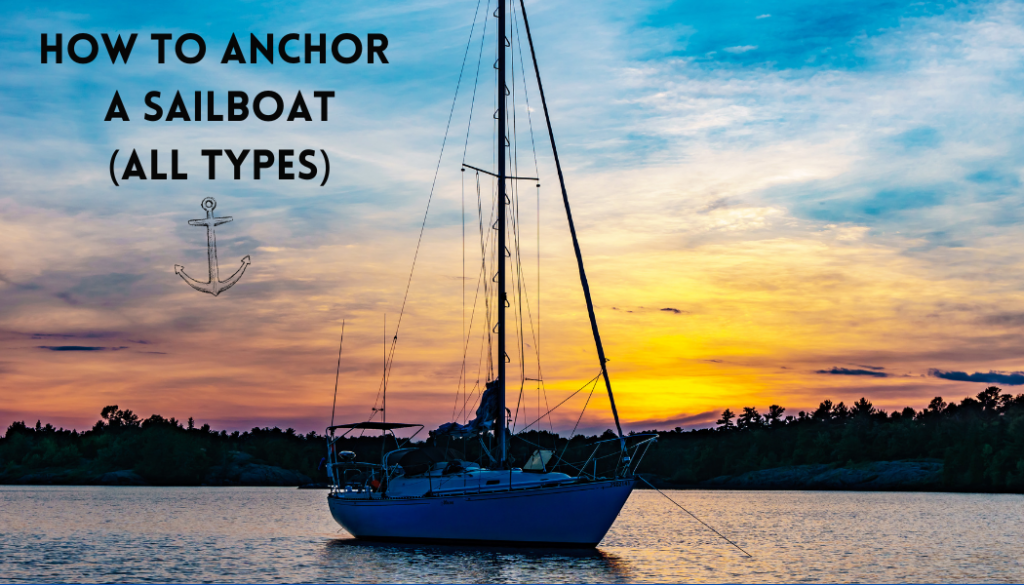
Anchoring a sailboat, whether in the serene embrace of a secluded cove or the challenging conditions of open waters, is both an art and a science. Sailors must navigate an array of factors—from the type and size of their vessel to the nature of the seabed and the temperament of the waters. This comprehensive guide delves into the intricate world of anchoring sailboats of all types and sizes. We’ll explore the varied types of anchors and their specific uses, highlighting why there’s no one-size-fits-all solution when it comes to securing your vessel. Whether you’re a seasoned sailor or new to the helm, understanding the nuances of anchoring in different water conditions, such as rough or deep waters, is essential for safe and enjoyable sailing.
Different Types of Sailboats and Anchoring Needs
The anchoring requirements of a sailboat vary widely depending on its type and size. Smaller boats like dinghies require lightweight, easy-to-handle anchors, while larger vessels like cruising yachts necessitate robust anchoring systems due to their higher windage and weight.
- Dinghies and Day Sailors : These small boats need compact, lightweight anchors that are easy to store and deploy. Their low weight and windage make them less demanding regarding anchoring power.
- Cruising Yachts : Larger and heavier, these boats require anchors with significant holding power. The choice of anchor must account for a wider range of wind and tide conditions.
- Racing Boats : Often similar in size to cruising yachts but with different design considerations, racing boats may require specialized anchoring equipment that combines strength with minimal weight.
- Multihull Boats (Catamarans, Trimarans) : Their wide beam and different weight distribution call for larger anchors or specialized systems to ensure stability and security.
Choosing the right anchor for your sailboat involves understanding these differences and balancing factors like weight, holding power, and ease of use.

Exploring Different Anchor Types and Their Uses
The world of anchoring is diverse, with each anchor type designed for specific conditions and seabed types. Understanding the strengths and ideal uses of various anchors can greatly enhance a sailor’s ability to move securely moor in different environments. From traditional designs to modern innovations, the choice of anchor depends on factors such as the boat’s size, the nature of the seabed, and prevailing weather conditions.
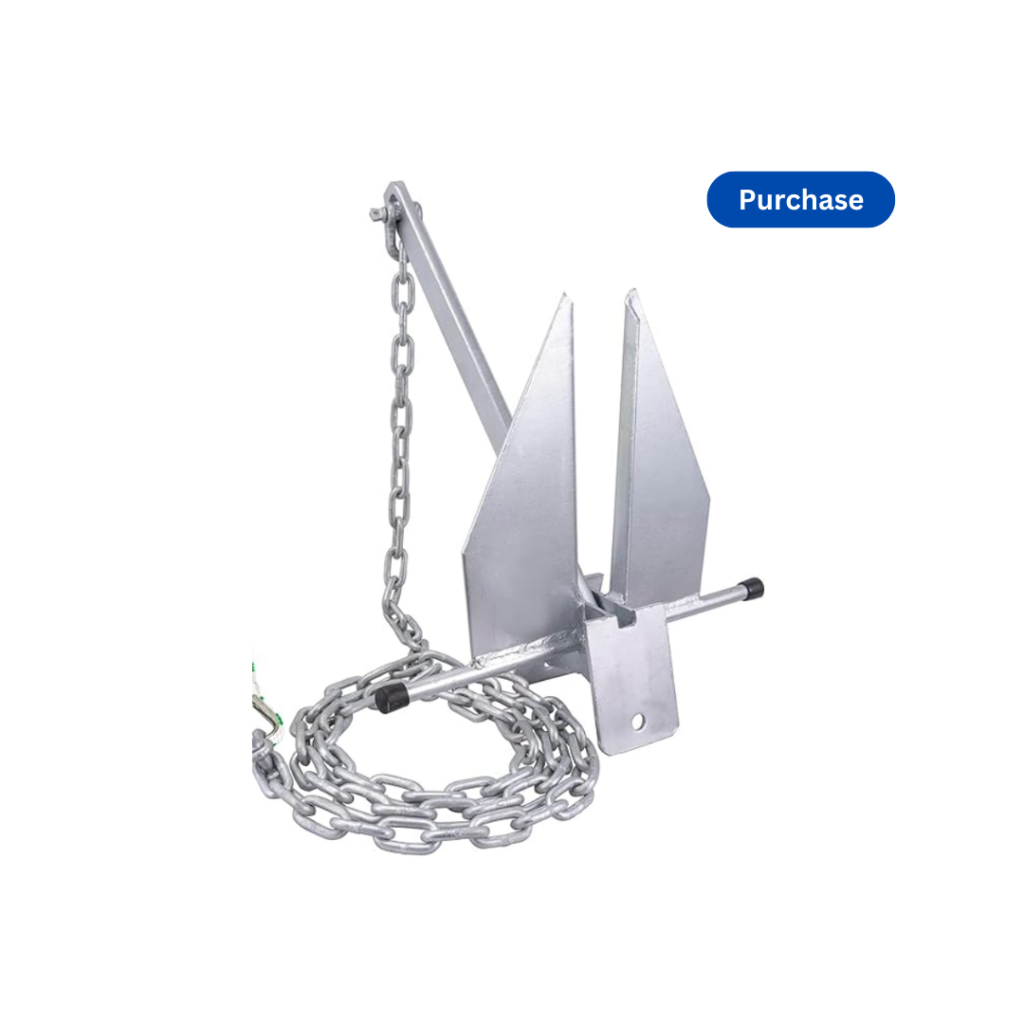
Fluke (Danforth) Anchors
- Ideal for small to medium-sized boats.
- Best suited for soft sea beds like mud or sand.
- Offers high holding power relative to its weight.
- Easy to store due to its flat design.
- Less effective in rocky or very hard seabed conditions.
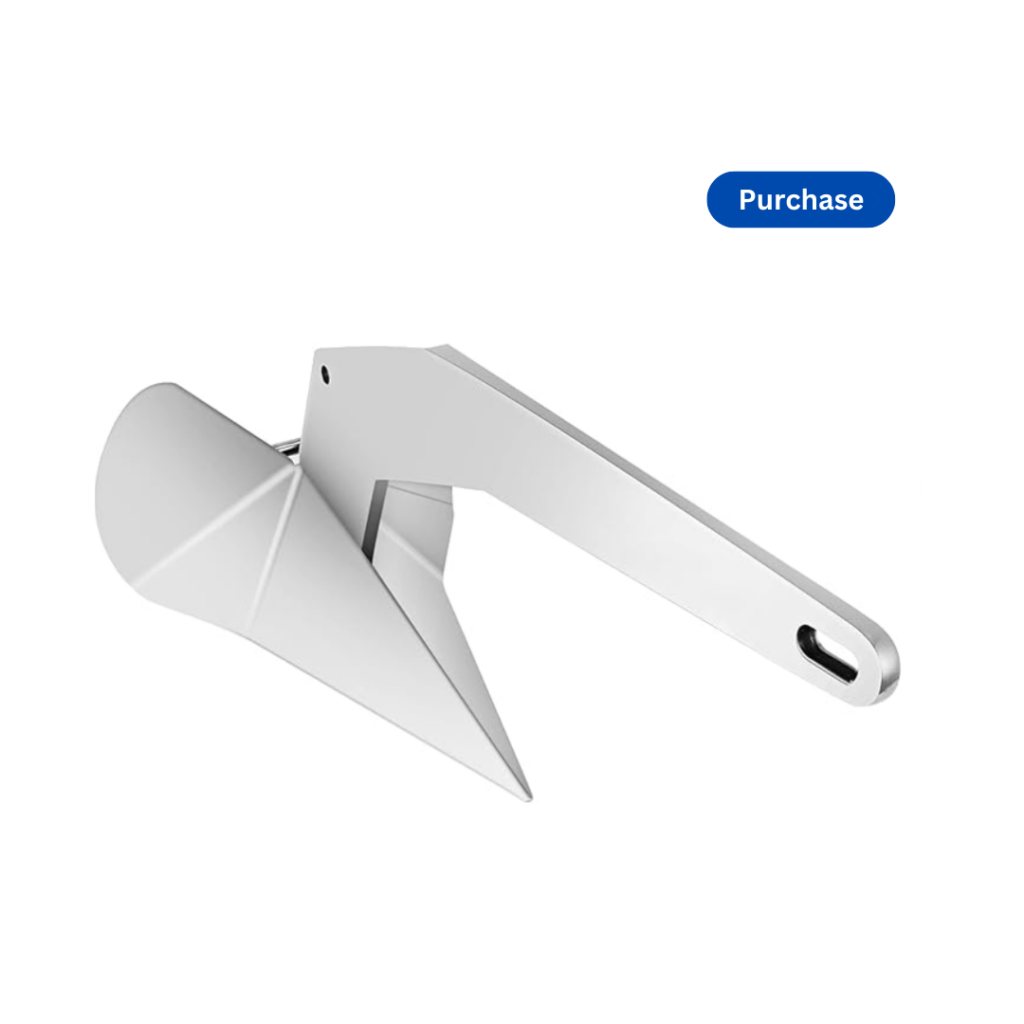
Plow Anchors
- Versatile and suitable for larger vessels.
- Performs well in various seabeds, including mud, sand, and grass.
- The plow shape allows it to dig in and hold securely.
- It can be more challenging to store due to its shape.
- Offers reliable performance in changing conditions.
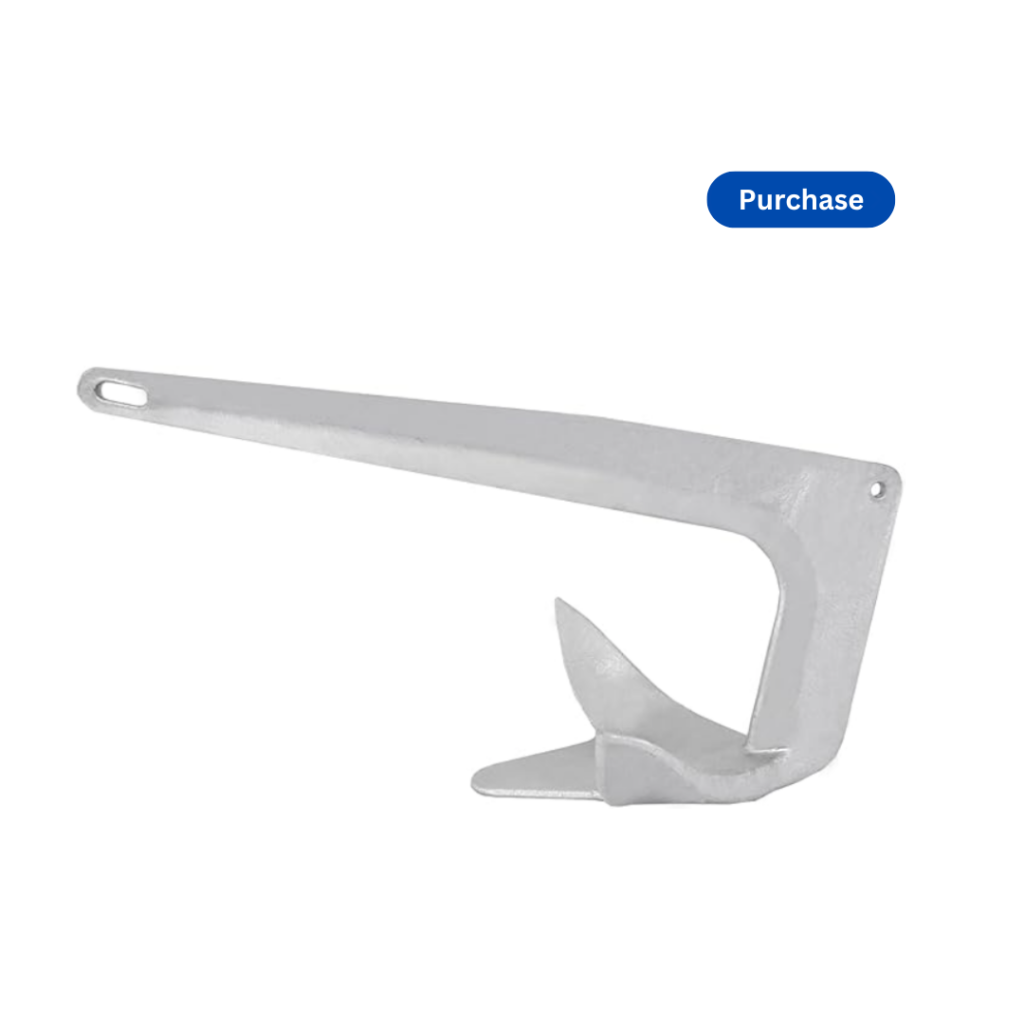
Bruce or Claw Anchors
- Known for their ability to reset quickly if dragged.
- Works well in rocky, sandy, and weedy seabeds.
- Ideal for areas with strong winds or currents due to its resetting capability.
- The design provides consistent performance but with moderate holding power.
- Popular among boaters for its all-around functionality.
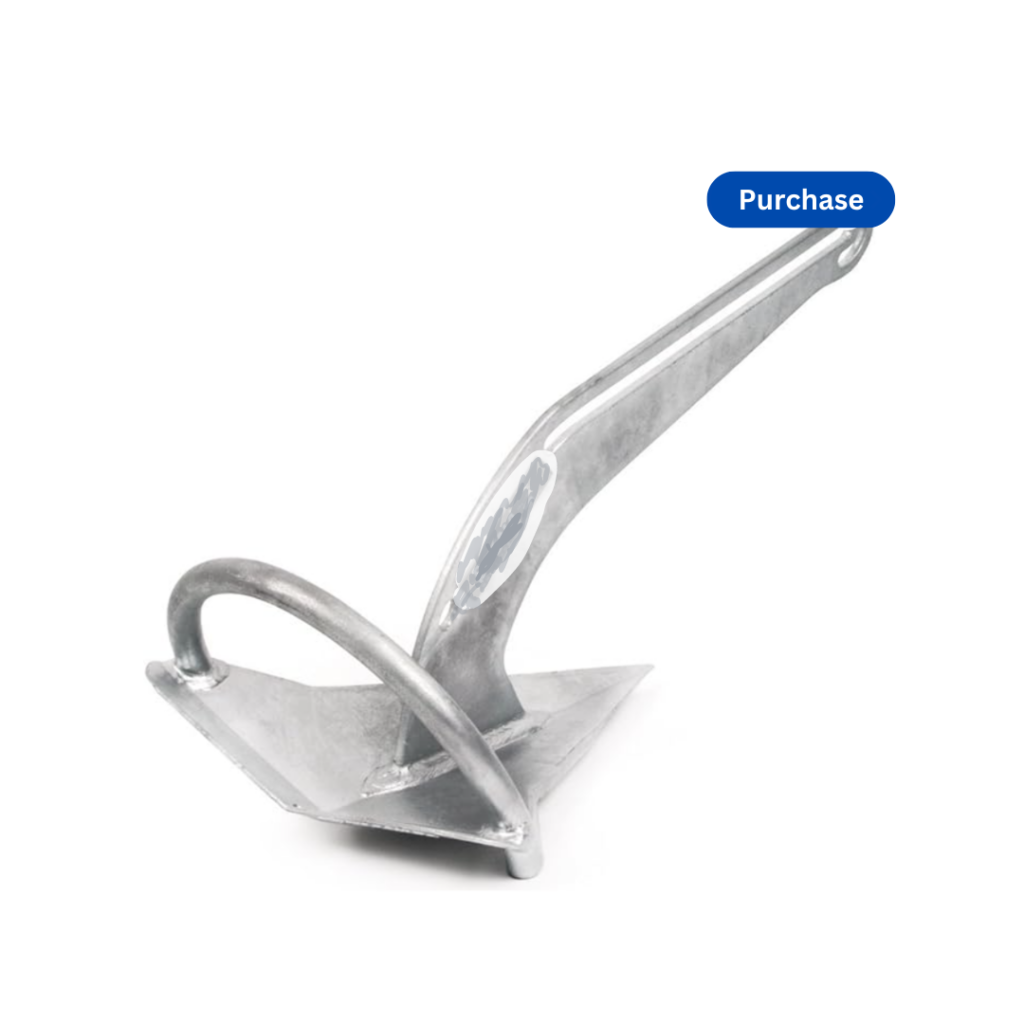
Rocna or Manson Supreme Anchors
- Designed for quick setting and reliable holding in diverse conditions.
- Heavy-duty construction makes them suitable for larger boats.
- Effective in various seabed types, including hard and soft conditions.
- Offers high holding power, reducing the likelihood of dragging.
- They are increasingly popular due to their robust performance across various environments.
Each of these anchor types has unique characteristics that make them suitable for specific conditions and boats. Sailors should consider these factors when selecting the right anchor for their vessel, ensuring safe and effective anchoring.
Anchoring Techniques for Challenging Conditions
Anchoring in challenging conditions demands skill, preparation, and the right equipment. In rough waters, the primary concern is the anchor’s ability to maintain its hold despite strong winds and waves. Using a heavier anchor or a larger size than usual can provide additional security. It’s also crucial to pay out more scope (the ratio of the length of the anchor line to the depth of the water) in such conditions, typically at least 10:1. This ensures that the pull on the anchor is more horizontal, reducing the chances of it being dislodged.
Setting two anchors in a V-configuration in strong currents or winds can offer greater stability. This technique involves deploying two anchors from the bow at 45-degree angles, creating a wider support base. Regularly checking your anchor’s position using landmarks or electronic aids like GPS is vital to ensure it hasn’t dragged.
Finally, it’s important to be mindful of the seabed composition. In challenging conditions, anchors designed for specific bottom types (mud, sand, rock) can provide better hold. If the anchor does start to drag, being prepared to quickly reset it or deploy a secondary anchor can prevent dangerous situations.
Deep Water Anchoring – Techniques and Considerations
Anchoring in deep water presents unique challenges. The increased water depth requires more anchor rode to achieve an adequate scope. In deep waters, a scope ratio of at least 5:1 is often necessary, though conditions may dictate even more. The increased length of rode, however, increases the swing radius of the boat, which needs to be considered, especially in crowded anchorages or near underwater hazards.
The type of anchor rode is also a key consideration in deep water. All-chain rodes are preferred due to their added weight, which helps maintain a more horizontal pull on the anchor, which is crucial for good holding power. However, the weight of the chain can be a concern for smaller boats or those with limited storage capacity. In these cases, a combination of chain and rope can be used.
Lastly, when anchoring in deep water, it’s essential to use an anchor with a proven track record of setting and holding in various seabed types. The increased depth means retrieving and resetting a dragged anchor can be more laborious and time-consuming, making a reliable initial set even more critical.
How Do Different Bottoms Affect Anchoring? Multiple Types
The composition of the seabed is a crucial factor in anchoring. Different anchors are designed to perform optimally in specific bottom types, such as mud, sand, gravel, or rock. In muddy bottoms, anchors that can dig deep, like the plow or scoop anchors, are effective. These anchors bury themselves into the soft substrate, offering a stronghold.
In sandy conditions, fluke anchors are often the best choice. Their design allows them to penetrate the sand easily and provide a secure hold. However, these types of anchors might struggle in rocky or coral bottoms. Claw anchors, with their ability to reset themselves and grip onto uneven surfaces, can be more suitable in these conditions.
Seagrass beds present another challenge. Anchors can have difficulty penetrating the grass and reaching the underlying sand or mud. In such cases, a heavier anchor that can cut through the vegetation or a design that allows for a more direct downward force, like a Bruce anchor, may be more effective. It’s also essential to be environmentally conscious when anchoring in seagrass to avoid damaging these vital ecosystems.
5 Tips and Tricks for Anchoring Your Sailboat
Experienced sailors know that effective anchoring is as much about technique as it is about the right equipment. Advanced techniques can make a significant difference in challenging situations.
- Setting a Stern Anchor : This can stabilize the boat in strong tides or winds, preventing it from swinging too much.
- Tandem Anchoring : Placing two anchors in line increases holding power in strong winds or currents.
- Using a Trip Line : In rocky or coral bottoms, a trip line attached to the crown of the anchor can help in retrieving it if it becomes snagged.
- Anchor Bridle on Multihulls : Using a bridle system can distribute the load evenly and reduce strain on a single hull for catamarans and trimarans.
- Anchor Watch: Regularly monitoring the boat’s position manually or through electronic systems like GPS ensures the anchor hasn’t dragged.
Implementing these techniques requires practice and understanding of the specific conditions and the type of anchor being used. Each approach has its place, and knowing when and how to use them is the mark of a skilled sailor.
In Conclusion
When it comes to anchoring your sailboat or any other type of boat there are a lot of things to think about. This article talked about many different types of anchors and their pros and cons. I also mentioned how the bottom of the ocean or lake needs to be considered when you are trying to anchor somewhere. You need to take time and insect the sea floor if possible and consider the best technique for anchoring. I hope this article helps you on your next adventure! Cheers!
Boatlifehq owner and author/editor of this article.
Recent Posts
Sailboat Racing - Rules & Regulations Explained
Sailboat racing, a blend of skill, strategy, and adherence to intricate rules and regulations, offers a thrilling and intellectually stimulating experience on the water. Navigating through the...
What is the best sailboat to live on? Complete Guide
Embarking on the journey of living aboard a sailboat requires careful consideration of your budget, desired amenities, and storage options. This guide offers a concise, step-by-step approach to...
- 2024 BOAT BUYERS GUIDE
- Email Newsletters
- Boat of the Year
- 2024 Freshwater Boat and Gear Buyers Guide
- 2024 Boat Buyers Guide
- 2024 Water Sports Boat Buyers Guide
- 2023 Pontoon Boat Buyers Guide
- Cruising Boats
- Pontoon Boats
- Fishing Boats
- Personal Watercraft
- Water Sports
- Boat Walkthroughs
- What To Look For
- Best Marine Electronics & Technology
- Watersports Favorites Spring 2022
- Boating Lab
- Boating Safety

Boat Anchoring Tips and Techniques
- By Joe Friedman
- Updated: February 20, 2020
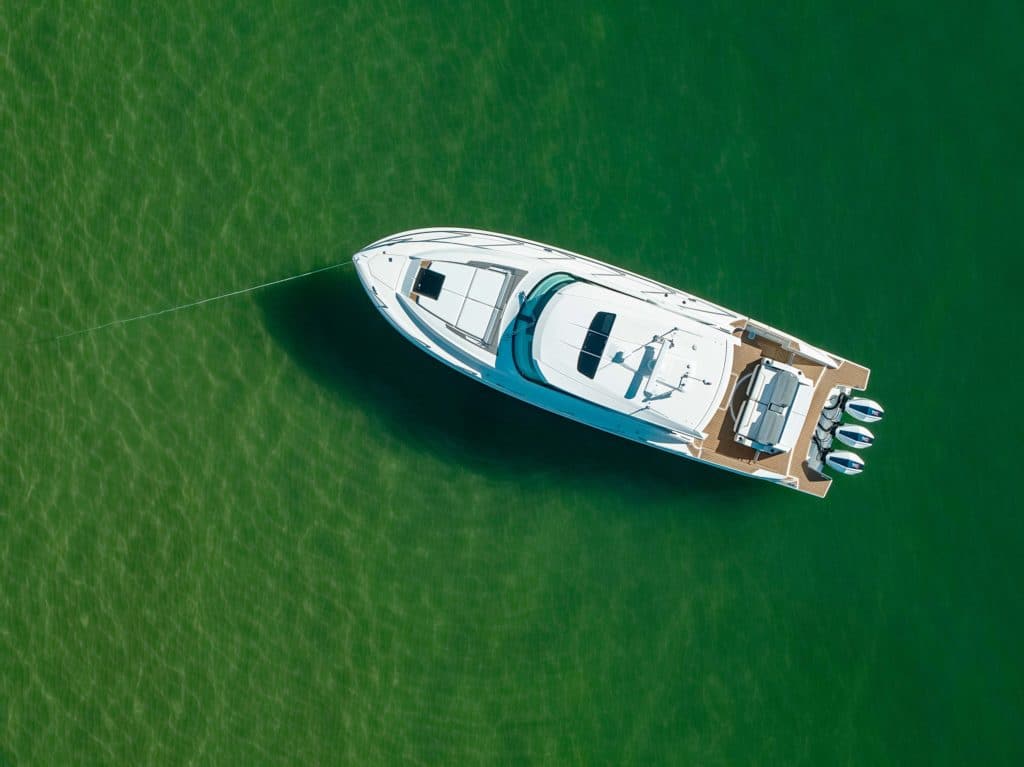
There’s a big difference between tossing a “lunch hook” over the side for a quick dip and securing a boat anchor for an overnight stay. What is the proper technique for anchoring? Whole books have been written about proper boat anchoring, and it gets a complete chapter in Chapman Piloting & Seamanship, the venerable guide to small-boat handling. Figuring out boat anchoring is one of the first things you learn in seamanship . Here’s a quick rundown on some solid, basic boat anchoring tips and techniques.
10 Tips Explaining How to Set an Anchor
1. Use Your Engine to Help When Anchoring
The proper technique for anchoring starts with easing the throttle so that the boat is basically standing still at the point where you want the anchor to drop. Let it go, sneak back under power, and slowly pay out the line.
2. Scope Out When Anchoring
You’ll need to know about how much scope to use, since this will affect where the boat will lie once the hook is stuck. Experience and local knowledge of the bottom are the best teachers, but plan on about an 8-to-1 ratio of scope to water depth. Meaning, in 10 feet of water with a 4-foot height to bow from the water, you stream out 122 feet of rode. With more chain and an oversize boat anchor, you may be able to ride reliably to a 4-to-1 scope, whereas poorly holding bottom and/or strong wind and/or strong current may require a 10-to-1 scope. In some cases, tech gadgets can help you set the boat anchor.
3. Head into Current When Anchoring
At dead-slow speed, head the boat up into the wind or current, beyond the spot where you want the boat to lie, at a distance equal to your estimated scope. Come to a stop. In rough conditions , it can pay to drift back without dropping the boat anchor first, so that you can see where the boat will end up when you do deploy the hook.
4. Use Enough Rode When Anchoring
When enough rode is out to equal the desired scope, snub up on the cleat. Allow the stretch to come out of the line and see if you are holding. A shot of reverse gear can often help set the anchor hook but, if done prematurely, can cause the boat anchor to skate across the bottom without catching.
5. Make Sure Your Anchor Holds After Anchoring
With the hook set, cleat it off securely and run the rode through chocks to ensure that navigation lights and other deck equipment don’t get “swept” by the rode as the boat swings on the line. Line up with two landmarks, or use your radar, GPS or depth sounder to monitor your position and ensure that you are not dragging the anchor.
6. Know the Bottom Structure When Anchoring
Your chart or plotter will generally show what to expect, but pockets of the unexpected do occasionally show up in an otherwise defined bottom to make life exciting. The most common bottoms are sand, mud, clay and grass (or weed). Most of the popular anchor styles (Danforth, CQR, Delta, Spade, Bruce, Rocna) are considered to be workable for all of these conditions. That said, plow anchors — like a CQR or Delta — hold best on a rocky bottom, a Danforth holds best in mud, and heavier anchors hold best in grass.
7. What is the Best Anchor Size When Anchoring
The boat anchor should be correctly sized for your boat. For instance, a typical 32-foot medium displacement boat could put out a 25-pound CQR or a 22-pound Delta and be comfortable in 30 knots of wind. A 12-pound Hi-Tensile Danforth is another option. One size up would be nice, especially if you have a power windlass to do all the work. Check the anchor manufacturer’s guide for your boat’s length, displacement and hull type .
8. Rope or Chain When Anchoring
A properly sized all-nylon rode, either twisted or braided, is fine for light-duty anchoring. More common would be to add 6 to 8 feet of chain between the anchor shank and the rode. But for overnighting or extended anchoring, a one-half boat length’s worth of chain is a good rule of thumb to help an anchor’s holding power. The chain will aid in setting the anchor and keeping it set by lowering the angle of pull, thus helping to absorb the shock of a tossing boat due to wind or sea conditions and reducing chafe due to rocky or shelly bottom.
9. Be Courteous of Other Boaters When Anchoring
If you’re the first or only boat in the anchorage, you’ve got priority. Otherwise, choose your spot carefully so as to allow enough swinging room to stay clear of the others and show your anchoring etiquette . Remember that big boats swing slower and tend to have a bigger arc than smaller ones. Boats with a lot of windage (big canvas enclosures, large cabins, high freeboard and almost all sailboats) will swing faster in high winds.
10. Check reference Points When Anchoring
Be sure to continue to check reference points, and watch to see that your position doesn’t change. Set the boat anchor alarm on your GPS, if yours has one, to alert you if something changes while you’re asleep or occupied. Then break out the sandwiches and enjoy the view.
11. The Windlass is Not a Cleat
The techniques in boat anchoring are the same, with or without a windlass. Keep in mind that a windlass is not a cleat and shouldn’t take the load of your boat under anchor. Neither is it the raw muscle to pull the anchor. Instead, take up the slack as you slowly motor forward to break the anchor free. Secure anchors hauled with windlasses with a trace of line or a chain stop.
- More: anchoring , How-To , Seamanship
More How To

Eight Tips for Waxing Your Boat
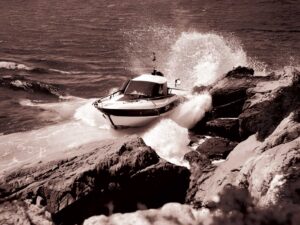
What to Do if Your Boat’s Engine Dies

I Learned About Boating From This: Capsize, Rescue and Lessons Learned
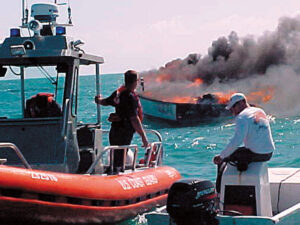
Should You Abandon Ship During a Boat Fire?
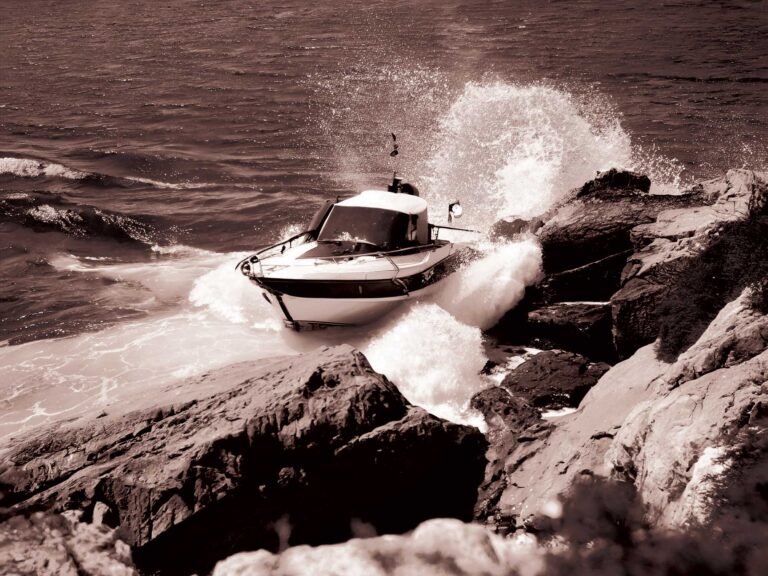
Boat Test: 2024 Nuova Jolly Prince 33 CC

ProTournament Elite Gen 3 Chargers
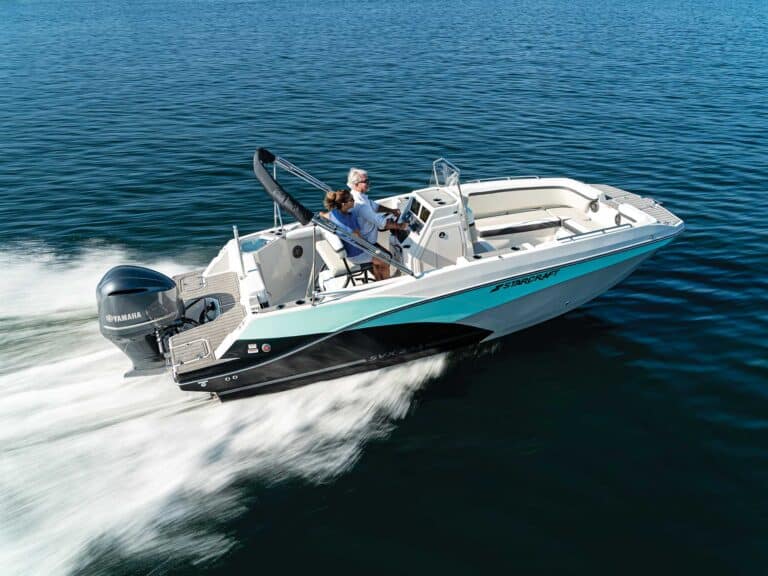
Boat Test: 2024 Starcraft SVX 231 OB CC

- Digital Edition
- Customer Service
- Privacy Policy
- Cruising World
- Sailing World
- Salt Water Sportsman
- Sport Fishing
- Wakeboarding
Many products featured on this site were editorially chosen. Boating may receive financial compensation for products purchased through this site.
Copyright © 2024 Boating Firecrown . All rights reserved. Reproduction in whole or in part without permission is prohibited.

5 Tips For Anchoring Your Sailboat

If you are anything like me, anchoring your sailboat in a quite, snug cove or harbor can be hard to beat. But how do you choose an anchoring spot that will provide you with a worry-free “night on the hook”? Follow these five easy tips to enjoy one of sailing’s most sought-after pleasures.
1. Check Your Ground Tackle for Integrity
Check your anchor ground tackle before you make your approach into an anchorage . This applies to quiet coves or crowded anchorages. Ground tackle consists of each part of your anchor , fastenings, rope, and chain that form an “umbilical cord” from your boat to the sea bottom. If one single part of your ground tackle fails, this could put your boat and sailing crew in danger. You could drag anchor and end up aground.
Take the time now to check for chafe (wear and tear), broken fittings, and bent or distorted anchor parts. Pay close attention to the anchor shank (long arm of the anchor attached to your rope or chain). This vulnerable anchor part needs to be straight without distortion. If bent, do not attempt to straighten the shank. This will weaken it–much like bending a paperclip back and forth. Use another anchor for peace of mind.

2. Choose Protection from Wind and Waves
What direction are the winds from right now? Are those winds expected to shift in a new direction over the next 24-48 hours? Answer these two vital questions before you select an anchorage. Next, look at your nautical chart and find a cove or indentation with protection from wind and waves on at least two sides. Protection on three sides gives you the best security.
For example, let’s say the wind blows from the north. You listen to the predicted forecast and winds are expected to shift to the northeast overnight. Choose an anchorage with protection from the north and east, or protection from the west, north and east. That way, your small sailboat will be protected from the present wind and waves (from the north), and the future, predicted wind and waves (from the northeast).

3. Know Your Seabed Bottom Material
Scan the chart inside the cove you have chosen. You need to have bottom material that your anchor can get a bite into. Sand, hard mud, and clay are ideal to drop your hook. Anchors tend to bury deep into these types of seabed materials. On the other hand, rock, grass, or kelp will be quite difficult for most any anchor to bite into. Your anchor might bounce over a rock-hard bottom or slide over slippery seabeds. Take the time to choose an “anchor friendly” seabed and you will sleep better at night.

4. Select the Best Anchor for the Sea Bottom
Carry at least two anchors aboard your boat. Purchase original anchors–not knock-offs. Copy-cat anchors can be of questionable build quality–unable to take the shear loads experienced when anchored. Choose an anchor that works well in good bottoms and one that you can trust in poorer bottoms. For softer seabeds like soft mud or soft sand pick an anchor like the Fortress. For other bottoms, use a well-proven boat anchor like the Rocna.
Cruising sailboats often carry three or more anchors so that they can use multiple anchors in stormy weather. Remember this–your anchor becomes your #1 primary insurance policy underway–not a piece of paper from a marine insurance company! Spend the money for superior anchor gear and you will be rewarded with confidence, peace-of-mind, and worry-free cruising anywhere in the world.
If you are anything like me, anchoring your sailboat in a quite, snug cove or harbor can be hard to beat.
5. Allow for Swing Room and Scope
Survey the anchorage area once you arrive. Make a few loops around the anchorage spot. Look at how other boats are anchored. Follow suite. If other boats have two anchors out, so should you. Favor that side of the anchorage nearer boats with designs close to your boat. Boats of like-designs swing at anchor in similar fashion.
Remember that your anchor marks the center of the circle and you will swing around the anchor in a circle–called a “swing circle”. Estimate the swing-circle of other boats. When you drop anchor, make sure that your swing circle does not intersect the swing-circle of another boat. Keep well clear of shoals (shallow water) or land downwind of your chosen anchor spot. Calculate the amount of anchor rode you need for safety. Allow 7 feet of rode for each foot of water depth–called “scope”. Add expected height of tidal rise and the distance of your bow above water in your calculations.
For example, let’s say you arrive at your anchorage and you will anchor in 10 feet of water. The tide tables say the tide will rise another 5 feet. Your bow is 3 feet above the water. How much scope do you need? Add everything and multiply by 7. 10 feet + 5 feet + 3 feet = 18 feet x 7 = 126 feet. Put out 126 feet of anchor rode for safe anchoring.
Follow these five tips for anchoring your sailboat safe and sound in any anchorage. This will give you confidence and peace-of-mind–wherever in the world you choose to cruise!
Captain John shows you the sailing skills you need for safe sailing anywhere in the world. Sign up for a FREE issue of the highly popular “Captain John’s Sailing Tips” newsletter and learn how you can get instant access to over 425 sailing articles, sailing videos, newsletters and more at SkipperTips .
Sailing Nandji Ep 348 IT’S ALL ABOUT BALANCE! the CALM before the STORM!
7 bluewater cruising sailboats we love, five best places where to sail at least one time in your life, sailing nandji ep 347 water damaged boat now ocean ready, live your passion, subscribe to our mailing list.

12 Best Sailboat Anchors for Any Sailor
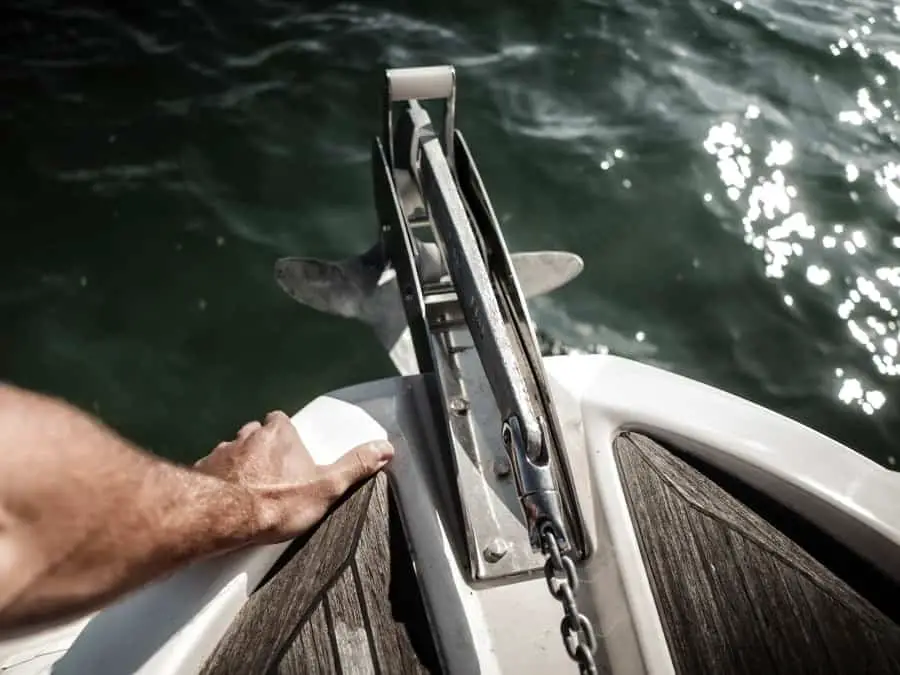
Having the ability to anchor out inside a nice peaceful bay or right outside of a marina avoiding all the hubbub can be an amazing feeling.
It’s an even better feeling knowing that your sailboat is securely fastened using the best sailboat anchor so that you don’t start floating away when the tide or wind starts to shift.
There are a lot of amazing anchors out there that are potentially a great fit for you and your sailboat as a primary anchor.
Having a clear understanding of what makes a good, high-quality sailboat anchor from a trusted brand means you’ll be able to make a more educated choice when deciding which anchor is best for you and your sailboat.
The Best Sailboat Anchors
Depending on your style of sailing and the whereabouts you like to explore, you may need one sailboat anchor over another.
Based on my experience, there are a lot of great options out there to choose from, which is why I put together the following list of the best sailboat anchors.
1. Rocna Vulcan Galvanized Anchor

One of the best sailboat anchors out there today based on being the best-selling anchor for yachts and workboats goes to the Rocna Vulcan Galvanized Anchor .
As one of the pioneering brands for sailboat anchors, the Rocna Vulcan was able to transform from the original Rocna anchor to the most dependable, best anchor out there today.
The Rocna Vulcan is actually a modified version of the original Rocna anchor, which was one of the most groundbreaking anchors to have been engineered and set the stage for the Rocna Vulcan.
The original Rocna anchor was designed in New Zealand back in 2004 and took the industry by storm. By taking the best features from more traditional anchor types, like the Bugel anchor and Spade anchor, it was able to set itself apart.
The Rocna Vulcan has a lot of fantastic features to it apart from being a very strong and powerful anchor. For one, it has the ability to dig into almost any type of seabed, which comes in handy when sailing in diverse locations.
It’s also relatively lightweight and easy to stow due to it not having a roll bar like its older brother, the original Rocna.
Another great feature is that it has no moving parts, so no one’s fingers have the chance of getting pinched.
When it comes to the construction material of the anchor, the Rocna Vulcan is a galvanized steel boat anchor, which means it’s very strong, long-lasting, and relatively inexpensive.
The design of this sailboat anchor allows for it to self-right itself when landing on the seabed and when being pushed around by currents and tides. It also comes with a lifetime warranty, so it’s guaranteed to last the lifetime of your sailboat.
All in all, the Rocna Vulcan is a great choice for any sailboat looking to anchor out.
Regardless of where you are, it’s highly likely you’ll be able to use your Rocna Vulcan to anchor and feel good that you have a popular, well-designed anchor manufactured by a trusted brand.
If you’re serious about getting one of the best boat anchors, definitely check it out.
2. Manson Galvanized Supreme Anchor

As one of the most famous boat anchors that were released when the original Rocna anchor came out is the Manson Galvanized Supreme Anchor .
As a matter of fact, this anchor came out in 2003 and is well known to this day as being extremely effective due to having a very high holding power, an effective roll bar, and an ability to settle to the seabed quickly.
You certainly cannot go wrong with a Manson Supreme anchor if you decide to get one. They have very high holding power, are able to dig into almost any seabed, have no moving parts, and are able to touch the seabed quickly.
While their major advantages are definitely the holding power and fast settling, this comes at the price of being rather heavy which can make stowing this anchor difficult at times.
3. Lewmar Galvanized Delta Anchor

Even though there are a number of modern anchor types that have taken the industry by storm, some of the more traditional designs still hold their weight to this day.
That’s why the Lewmar Galvanized Delta Anchor is still on the anchor scene, especially since it’s been a hallmark anchor for a very long time.
There are a number of good reasons to go with this anchor by Lewmar especially the fact that it has a strong holding power in softer seabeds (like mud and sand).
It’s also relatively lighter than other sailboat anchors allowing for easy stowing and transportation. Another great quality is that it’s all one piece, so there’s no potential issue of pinched fingers.
The only downsides include that it sometimes requires a tripping anchor line to release it from the seabed and that it’s not ideal for hard seabeds or seabeds covered in kelp.
4. Spade Anchor S120 Galvanized Steel

Another well-known, traditional design for anchors is the Spade Anchor S120 Galvanized Steel .
This type of anchor has been around for quite some time and has proven itself as a worthy contender to even the newer, more modern anchor types.
It certainly set the stage for a lot of anchor designs today and it continues to shine even today.
The Spade anchor is a very popular style of anchor that was designed in France back in 1996.
It was based on the delta style anchor design in a way to achieve a similar grip power to the seabed but by providing an even large surface area contact to the seabed.
This sailboat anchor is lightweight and can dig into soft seabeds quite well making it a great fisherman anchor for most fishing boats.
One of the downsides is that it sometimes Spade anchors needs the assistance of a tripping line to remove it from the seabed.
5. Lewmar CQR Anchor

Of all the more traditional anchors out there today, one of the most famous that really shook the anchor industry is the Lewmar CQR Anchor .
Before the more modern sailboat anchors, the CQR anchor (or the plow style anchor generally) was the go-to anchor for many yachts and workboats.
If you’re looking for a classic, time-tested anchor, the CQR might be the anchor for you.
The CQR anchor was designed in the UK way back in 1933 and has been one of the most well-known anchors out there. It was known to be so secure (and it still is), that it was named CQR because it sounded like “secure”.
This anchor’s relatively lightweight, digs into the seabed quite well, and is rather versatile in terms of the texture of the seabed it can grip.
However, it does have some downsides including it being oddly shaped so stowing is more difficult, it has moving parts, and it sometimes requires a tripping anchor line to remove it from the seabed.
6. Lewmar Claw Anchor

Another great anchor that’s been around for a while is the Lewmar Claw Anchor , which has been known as either the Bruce or Claw anchor in the past.
The strong reputation of Claw anchors has been well-known in the anchor industry for a long time and is further proven due to being manufactured by the trusted brand Lewmar.
The Lewmar Claw anchor is a fantastic anchor to own due to it being relatively lightweight, strong, and inexpensive.
As a matter of fact, it’s one of the best sailboat anchors anyone can buy since it has a lot of positive advantages like it has no moving parts and it’s easy to remove from the seabed.
The only downsides include it having an odd shape, making it a bit more difficult to stow, and not being the best when penetrating seaweed or grass-like seabeds.
7. Danforth S-600 Standard Anchor

There’s no doubt that even some of the traditional anchors still have a place in the best anchor category and that goes double for the Danforth S-600 Standard Anchor .
Similar to the CQR anchor, this anchor has been around for quite some time and was developed in the US back in the 1940s.
As a matter of fact, they were originally manufactured to be equipped with certain landing aircraft during WW2.
The Danforth anchor is an industry standard and has been a hallmark for many decades. They’ve been used as anchors for many types of vessels and are especially good for anchoring out in loose seabeds like sand or mud.
It’s also relatively lightweight and can be stowed easily since it’s pretty flat. Unfortunately, it has some moving parts to it, sometimes requires a tripping line to get it out of the seabed, and is certainly not ideal for more rocky seabeds.
8. Norestar Stainless Steel Danforth-Style Anchor

While the original Danforth anchor is a great choice for your next anchor, a step up in terms of quality is the Norestar Stainless Steel Danforth-Style Anchor .
While you’ll certainly spend a bit more money for this Danforth-style anchor, the design improvements ensure a safer anchoring and a longer-lasting product.
This Danforth-style anchor by Norestar provides all of the advantages of owning a traditional Danforth with some extras.
First, it has no movable parts so there’s no chance of pinching fingers while operating the anchor.
Second, it allows for anchoring off in seabeds that are rockier than the original Danforth can handle. It even comes in stainless steel, which means this anchor will last a very long time.
It does, however, still have the downside of at times needing a tripping line to release it from the seabed.
9. Norestar Stainless Steel Bruce Anchor

The Bruce anchor (also known as the Claw anchor) is a popular style of anchor that’s been used for a very long time.
There’s no question the Norestar Stainless Steel Bruce Anchor is a step up in the design of this anchor style, similar to how they improved the Danforth.
This Bruce/Claw anchor is a great choice for your sailboat’s next anchor since it has a good holding power for almost any seabed texture.
It’s also quite lightweight, has no moving parts, and it’s very easy to break it from the seabed.
Even better, it’s made out of stainless steel, so it’s built to last. Honestly, there aren’t too many downsides to this anchor apart from it being relatively expensive.
10. Norestar Stainless Steel Delta Anchor

The Norestar brand is amazing at taking the more traditional style of anchors and improving its designs to make them more attractive.
Well, they’ve done that once again with the Norestar Stainless Steel Delta Anchor .
The Delta anchor was already an improvement to the CQR anchor, but Norestar decided to take it to the next level.
The Delta anchor by Norestar is one of the highest quality stainless steel, delta-style anchors you could put on your sailboat.
Apart from it being stainless steel like the rest of Norestar’s anchors, it’s also lightweight, has no moving parts, and has a powerful holding power in softer seabeds.
However, it might not be the best sailboat anchor on seabeds with hard sand and it might require a tripping line to set it free from the seabed.
11. Mantus Galvanized Anchor

Some of the best sailboat anchors are originally derived from the more traditional sailboat anchors (in particular those with a roll bar), which is definitely the case for the Mantus Galvanized Anchor .
As one of the most well-known anchor types out there, this anchor manufactured by Mantus Marine stands out as a top contender for the best sailboat anchor.
This anchor by Mantus is produced with galvanized steel which makes it quite strong, inexpensive, and dependable.
With its uniquely designed roll bar, this sailboat anchor is able to properly land on the seabed when making its descent resulting in getting a better grip of wherever it ends up.
This anchor is specifically designed to break through dense grassy bottoms, so definitely a consideration when buying your next sailboat anchor.
12. Fortress Anchor

Sometimes it’s important to break free from the most well-known anchor brands and see what else is out there.
After stepping outside and digging into other anchor styles, I fell upon the Fortress Anchor , which is an aluminum fluke anchor that has a lot of common characteristics found in the traditional Danforth-style sailboat anchor.
The Fortress anchor has a very similar design to the Danforth but differs in the sense that it’s even more lightweight since it’s made out of aluminum magnesium alloy.
Some of the clear advantages that make this a candidate for the best sailboat anchor are that it settles quickly to the bottom of the seabed, it can be disassembled for easy storage, and it’s been tested to have double the holding power compared to its competition.
Downsides include movable parts, sometimes requiring a tripping line to remove it from the seabed, and not being ideal for rocky seabeds.
What to Consider Before Buying a Sailboat Anchor
We went over a good amount of high-quality sailboat anchors just now, so you should have a good idea of what anchor you might consider purchasing for your sailboat.
However, there are a few considerations to take into account before making that purchase, which is what we’ll cover now.
Construction Materials
You’ll find a number of different construction materials for anchors, like aluminum and steel, but by far the most common materials you’ll find is a metal anchor made of steel or aluminum alloy.
Galvanized Steel
Anchors made out of galvanized steel are often found to be less expensive and shiny compared to other types of anchor materials.
The great part is that they’re very strong and can last a very long time. Unfortunately, they’re prone to corrosion so it’s not uncommon to have to get them re-galvanized.
Stainless Steel
Anchors made out of stainless steel are very strong and aesthetically pleasing in terms of their appearance since it’s rather shiny.
You can’t go wrong with getting a stainless steel anchor, but you’ll definitely be forking over more money to get one.
Aluminum Alloy
Anchors made out of aluminum alloy are very lightweight compared to steel but often come at a much higher cost when going through the checkout line. However, when set correctly on the seabed, they’re known to have very high holding power.
Lakes vs. Coastal Waterways
Depending on where you’re sailing, you’ll need a certain level of strength to keep your sailboat from moving around while anchored.
Sailing in coastal waterways definitely requires a strong anchor than when sailing around lakes, so it’s generally advised to stick with the stronger anchors just in case.
If you know your sailboat will never leave the lake scene, go with a weaker (and thus cheaper) anchor.
Anchor Weight to Boat Length
You might’ve been wondering how strong your anchor should be based on the size of your sailboat.
Well, there’s no hard and fast rule to the exact strength (or weight) your anchor should have, but it’s definitely possible to determine a minimum weight to cover some worst-case scenarios when using your anchor.
A simple way to determine the minimum anchor weight of your sailboat is to subtract 5-10 lbs from every foot of your sailboat’s length overall (LOA). For example, if your sailboat is 40 feet long, then a 35 lb boat anchor would be a good weight.
This is a good rule of thumb when choosing an anchor weight for your sailboat, but should only be considered as an estimate and for minimum weight.
If the anchor you plan to purchase has a chart helping you decide on the proper weight to get, you should definitely follow that.
Get the very best sailing stuff straight to your inbox
Nomadic sailing.
At Nomadic Sailing, we're all about helping the community learn all there is to know about sailing. From learning how to sail to popular and lesser-known destinations to essential sailing gear and more.
Quick Links
Business address.
1200 Fourth Street #1141 Key West, FL 33040 United States
Copyright © 2024 Nomadic Sailing. All rights reserved. Nomadic Sailing is a participant in the Amazon Services LLC Associates Program, an affiliate advertising program designed to provide a means to earn fees by linking to Amazon.com and affiliated sites.
- New Sailboats
- Sailboats 21-30ft
- Sailboats 31-35ft
- Sailboats 36-40ft
- Sailboats Over 40ft
- Sailboats Under 21feet
- used_sailboats
- Apps and Computer Programs
- Communications
- Fishfinders
- Handheld Electronics
- Plotters MFDS Rradar
- Wind, Speed & Depth Instruments
- Anchoring Mooring
- Running Rigging
- Sails Canvas
- Standing Rigging
- Diesel Engines
- Off Grid Energy
- Cleaning Waxing
- DIY Projects
- Repair, Tools & Materials
- Spare Parts
- Tools & Gadgets
- Cabin Comfort
- Ventilation
- Footwear Apparel
- Foul Weather Gear
- Mailport & PS Advisor
- Inside Practical Sailor Blog
- Activate My Web Access
- Reset Password
- Pay My Bill
- Customer Service

- Free Newsletter
- Give a Gift

How to Sell Your Boat

Cal 2-46: A Venerable Lapworth Design Brought Up to Date

Rhumb Lines: Show Highlights from Annapolis

Open Transom Pros and Cons

Leaping Into Lithium

The Importance of Sea State in Weather Planning

Do-it-yourself Electrical System Survey and Inspection

Install a Standalone Sounder Without Drilling

When Should We Retire Dyneema Stays and Running Rigging?

Rethinking MOB Prevention

Top-notch Wind Indicators

The Everlasting Multihull Trampoline

How Dangerous is Your Shore Power?

DIY survey of boat solar and wind turbine systems

What’s Involved in Setting Up a Lithium Battery System?

The Scraper-only Approach to Bottom Paint Removal

Can You Recoat Dyneema?

Gonytia Hot Knife Proves its Mettle

Where Winches Dare to Go

The Day Sailor’s First-Aid Kit

Choosing and Securing Seat Cushions

Cockpit Drains on Race Boats

Rhumb Lines: Livin’ the Wharf Rat Life

Re-sealing the Seams on Waterproof Fabrics

Safer Sailing: Add Leg Loops to Your Harness

Waxing and Polishing Your Boat

Reducing Engine Room Noise

Tricks and Tips to Forming Do-it-yourself Rigging Terminals

Marine Toilet Maintenance Tips

Learning to Live with Plastic Boat Bits
- Sails, Rigging & Deck Gear
Selecting the Right Anchor Size
Holding power increases with weight, but how much is hard to calculate..
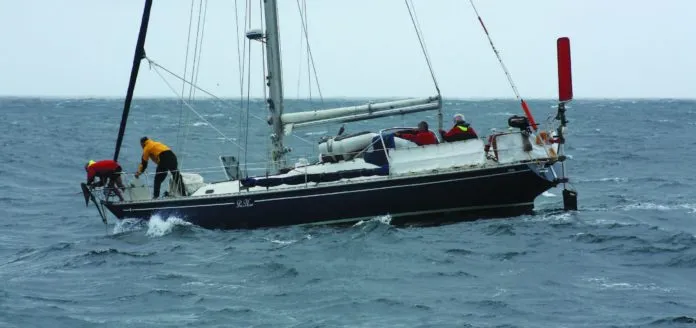
Over the years Practical Sailor has conducted dozens of anchor tests, and like many publications, we’ve repeated the common guidance that cruising sailors should buy an anchor that is at least one size larger than what the maker recommends for your size vessel.
During the last two decades, however, the tremendous holding power of some newer generation anchors have caused us to re-think this guidance. Are we paying more for an anchor, rode, and the requisite anchor handling equipment than we need? How accurate are the makers size recommendations? How much insurance are we really getting for the price of a bigger anchor?
For this report we took a range of modern, sometimes called new generation anchors, and their predecessors and averaged their weight vs. vessel size recommendations (see accompanying table). Much to our surprise, the weight recommendations for the new designs, Rocna, Excel, Supreme, etc. are very similar to the weight recommendation for the older, traditional models, CQR, Delta, Bruce etc. In both cases, the recommendation for a 35-foot yacht is approximately a 30-pound anchor. The exceptions are aluminum anchors from Fortress and Spade.
Most of the new generation anchors have been tested to international standards established by the RINA (Registro Italian Naval) or some other internationally recognized society. Rocna, Fortress, Supreme, Excel, Spade have been found to meet standards of Super High Holding Power, SHHP. The older anchors, CQR, Bruce, Delta are rated as High Holding Power. The difference between the two categories is that the SHHP have been tested and found to have a hold, comparing anchors of the same weight, that is two times that of the HHP anchors.
So if we’re getting double the holding power, does that mean we can use an anchor that is half the weight? Not necessarily. Nor can you expect another doubling of holding power by doubling the weight of an SHHP anchor.
Despite the sales pitch that the new anchors have greater holding capacity pound-for-pound, the anchor makers are suggesting that you replace your old CQR with the same weight new anchor. It appears that manufacturers are, in effect, doubling the historic safety factor. And for a cautious sailor, there is nothing wrong with this.
However, consider the advice that is often repeated on internet forums, or the local scuttlebutt, that cruising sailors should increase one size over the makers recommendation. So instead of a 33-pound Rocna for your Tartan 37, you buy a 44-pound Rocna-now with potentially three times the safety factor of an old school anchor. Apart from the added significant expense, this obsession with upsizing – more anchor, more chain, bigger windlass-can also add potentially unnecessary weight and concentrate it in the bow.
So what do we really get with that bigger anchor? There is an idea that if you double weight of an anchor you will double holding power. Except with extra-large commercial anchors and some specific tests, we’ve found no data to support this.
No independent test, as far as we know, has taken a series of different sized anchors of the same design and tested them in the same seabed for ultimate holding capacity. Tests have been conducted on commercial oil rig anchors like the Bruce, and the best scaling is about 90 percent-double weight and you increase hold by 1.8 times.
The only recreational anchor that we are aware of that has undergone some testing to determine the relationship between weight and holding is Fortress (in mud only, see Anchoring in Squishy Bottoms, PS February 2015 ). An analysis of all their tests on a complete range of their anchor sizes suggest that if you triple weight you increase hold by slightly more than two times, approximately an 80 percent efficiency as size is scaled up.
Ultimately, this means that when someone tells you they can calculate the increase in holding power as you move up in size, be careful not to read too much into this conclusion. For one, the ratio used deserves close scrutiny. Surely, the bigger anchor will provide better holding-but how much? This hard to quantify, even with computer modeling. And no matter how accurate your calculation-a ratio based on performance in one type of bottom might not apply in another.
One reason you can’t claim that doubling the weight doubles the holding is that as anchors increase in size, the stress on the construction increases. To compensate for the increase in stress, the steel thicknesses must be increased – and more steel weighs more. So in an anchor whose holding power relies greatly on surface area and how it is distributed, adding more weight doesn’t necessarily result in a commensurate increase in surface area that provides holding power.
And as we’ve shown in our past tests-anchor dimensions (especially the fluke area) and shape can play a significant role in performance. It might be possible to double weight and double the holding power without beefing up the steel, but the resulting anchor would be less strong relative to its designed holding power.
Weaker construction might not matter on an over-engineered anchor. However, we have seen how the use of inferior materials has resulted in anchors that bend more easily at designed loads (see Anchor Tests: Bending More Shanks, PS May 2013 ).
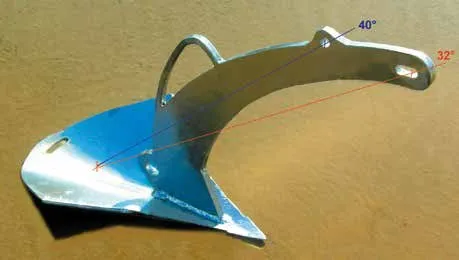
Anchor Angles
In past reports, we’ve discussed in detail how anchor design can impact holding, especially with the new generation anchors ( see An Inquiry into Anchor Angles, PS February 2017 ). As you consider which design best suits your needs, here are some things to consider.
Fluke/shank angle. The fluke/shank angle is the angle between fluke and shank. It is one of the determining factors in how quickly and deeply an anchor sets. For a simple design with flat plate fluke and a straight shank (like a Guardian) the angle is a line down the center of the shank to the hinge and then along the fluke. In shanks with curves or angles, the first line is usually drawn from the shackle pin to the point there the shank meets the fluke.
For three-dimensional flukes (as found in most new generation anchors), you have to estimate where the top of the fluke plate lies. The ballast chamber or shank support that might protrude from the sole, such as with Spade, or Vulcan anchor should not be used to determine shank/fluke angle.
It is the fluke top surface that is important. In previous tests we reported that in thin mud an anchor with a fluke angle of around 45 degrees will outperform an identical anchor with its fluke angle set at 30 degrees. But a firmer sand seabed is entirely different, and research demonstrates the ideal fluke angle for a typical sand bottom is around 30 degrees (see Small Anchor Reset Tests, PS February 2013 ).
Fluke-seabed angle. This is the angle of the fluke to the seabed during the phases of anchoring-most importantly, during the initial penetration into the bottom, and when the anchor is set.
Penetration angle. When an anchor is aligned ready to set, or engage with the seabed (it might need tension on the rode to achieve this) then the fluke will usually be at an angle of 60-70 degrees to the seabed. Commonly the anchor is on its side.
Setting angle. Once the anchor starts to penetrate it will self align and the fluke plate tend quickly toward its setting angle, usually of about 30 degrees. It is coincidence that the fluke/shank angle and setting angle are similar though most anchors tend to show the similarity of the two angles. Center of gravity can have a great effect on penetration angle. This is why many new generation anchors, like the Ultra, have weighted flukes. Having a 30-degree fluke/shank angle is irrelevant if the center of gravity is in the wrong place.
Shank length
If you imagine a Fortress with a shank/fluke angle of 30 degrees but a shank three times longer than its original design, then you can visualize how the anchor will probably simply slide along the seabed when tensioned. The throat opening will be too small. Similarly if you chop the shank in half, the toe of the anchor will simply scrape along the seabed. In both case the anchor will find difficulty in engaging because the penetration angle will be wrong.
Are the makers of new generation anchors over-stating the need for bigger anchors, thus requiring boat owners to pay much more than they might need in order to be secure at anchor? Possibly. Would going with a larger-than-required anchor actually hurt your anchors performance? Unlikely. As is often the case with our anchor reports, it is hard to come with some firm answers regarding both of these questions. Anchor studies are fraught with variables.
In our view, it is no crime to go up one size over the manufacturers recommended size, if your boat and crew can handle it. The anchor may require more reverse throttle to set, but ultimately, it should provide the holding you require. Likewise, it is reasonable to assume that the anchor makers guidance for sizing is reasonable. However, if an online advocate starts telling you that youll get x times more holding power by going up one size, ask him for the data.
Extra weight in an anchor is your insurance policy. Yes, you can almost always get more security with the heavier anchor, but whether or not you will every need that extra holding power is not conclusive. In our view, conservative sizing is added insurance-but until the data is in, we remain skeptical of any absolute claims that attempt to quantify the advantages of more weight when choosing an anchor.
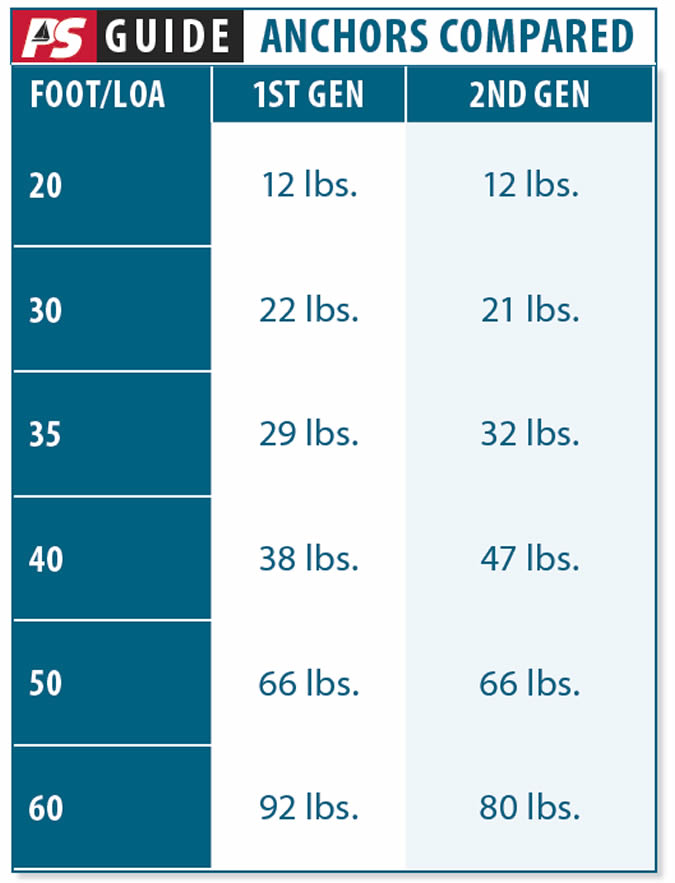
Based on average recommendations from leading anchor makers, the weight savings of upgrading to a second generation anchor doesn’t really pay off until you get into the larger size vessels.
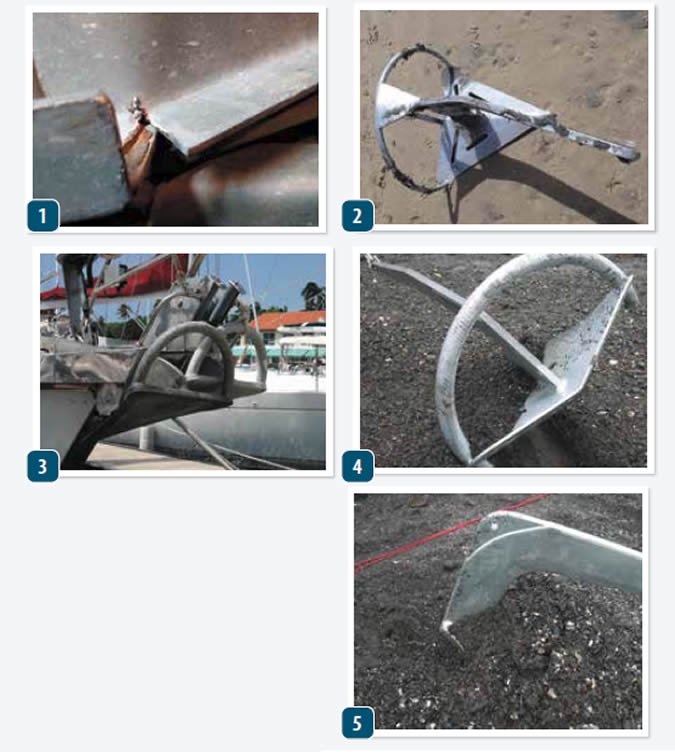
In an anchor whose holding power relies greatly on surface area and how it is distributed, adding more weight doesn’t necessarily result in a commensurate increase in surface area that provides holding power. To compensate for the higher loads, the steel must be thicker, resulting in different surface area/weight ratios.
- As fluke size increases, so do the loads. But if the construction isn’t beefed up to handle the loads, the result is failure. Flat plate steel in this Danforth fluke sheered.
- The shaft of an Excel anchor bent during veer testing.
- The flat flukes of the Bugel anchor makes it easy to calculate the shank-fluke angle.
- Here a Rocna anchor is in the initial setting angle, still capsized on one side, with not enough of its toe is dug into the soil to dig in. Bottom shape and center of gravity (some designs are weighted to control CG), helps to determine this angle.
- This Manson Ray anchor has rolled upright and assumed the angle of penetration that will help the anchor to bury into the bottom.
RELATED ARTICLES MORE FROM AUTHOR
Leave a reply cancel reply.
Log in to leave a comment
Latest Videos

Bahamas Travel Advisory: Cause for Concern?

Island Packet 370: What You Should Know | Boat Review

How To Make Starlink Better On Your Boat | Interview

Catalina 380: What You Should Know | Boat Review
- Privacy Policy
- Do Not Sell My Personal Information
- Online Account Activation
- Privacy Manager
Boat Anchor Selection Guide: Choose the Perfect Type & Size
When you buy a used boat, odds are it will come with an anchor, and with a new boat you'll usually get to choose an anchor for it. What if that old anchor you have on your new-to-you boat doesn't hold so well, or needs replacing? In any of those scenarios, you'll need to pick out a new anchor for your boat. There are more types of anchors that you dreamed of, and they're all different in how they perform in different anchoring conditions. And your anchor will need to be sized for your boat.
The type of anchor you choose depends on the predominant bottom types where you plan to sail, and what fits on your boat. Once you know the type, you get the perfect type and size of anchor from the length and weight of your boat using the manufacturers' recommendations.
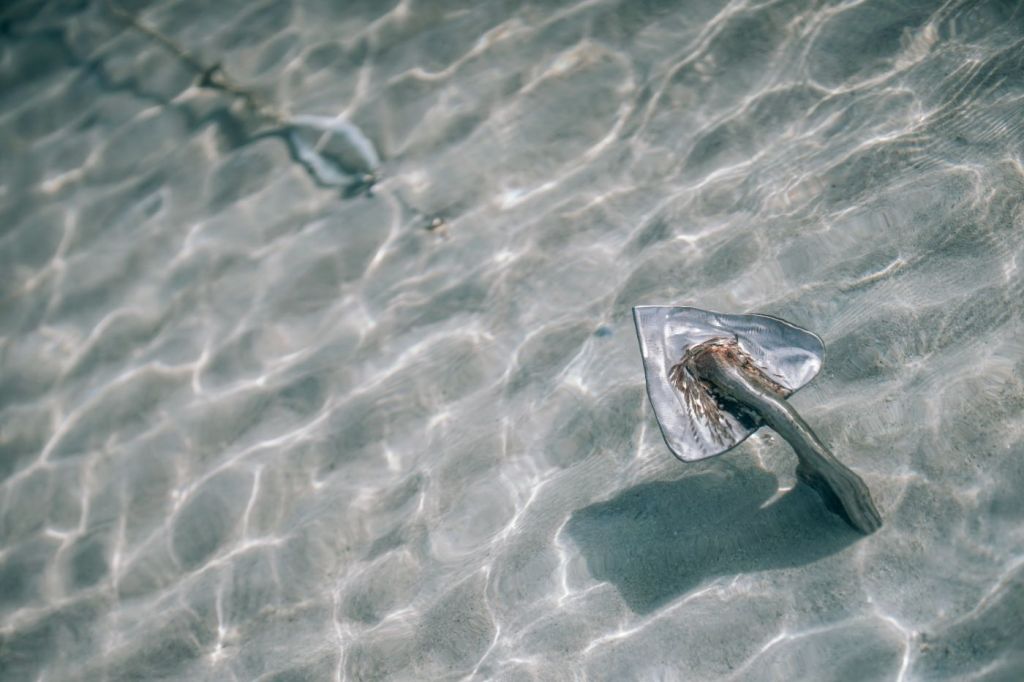
On this page:
How does an anchor work, loads and forces on an anchor, anchor construction materials, most common anchor styles, how do i choose an anchor, what's in your anchor locker, picking the right anchor ground tackle.
Instead of getting overwhelmed, if you do a little research upfront on what you might need you can narrow down your choices and get the best anchor for your boat and where you use it.
While it may seem obvious at first glance, there are many mistaken assumptions about just how your anchor holds your boat to the bottom. It's important to understand just what your anchor does when it's holding your boat, so you know why you may choose one anchor or another.
All anchors dig into the bottom. Some have aggressive, plow-like forms or scoops which burrow in quickly, others have various hooks, spikes or protrusions designed to catch and hook as soon as the anchor is pulled.
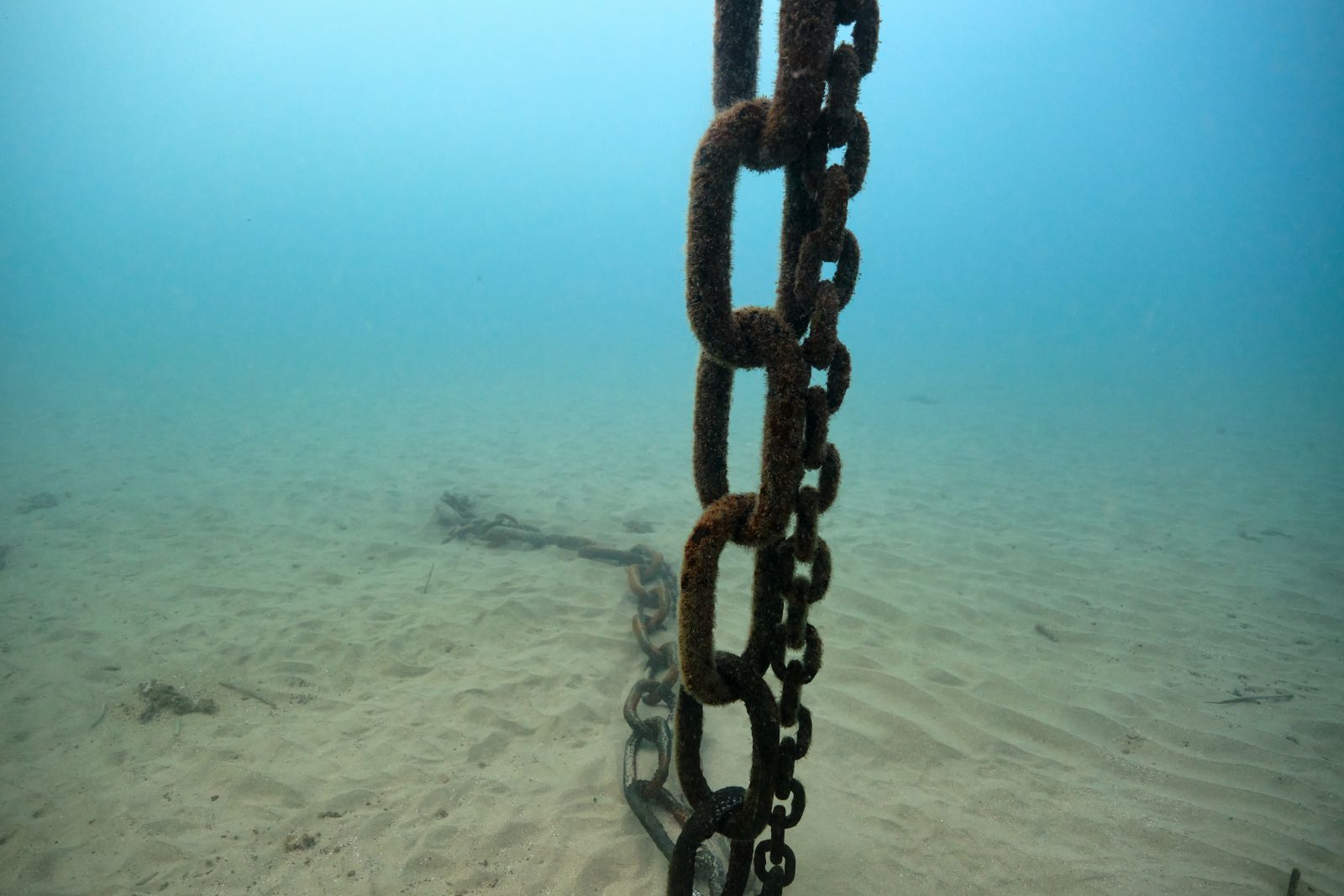
Angle of attack provides holding power
The pulling force on an anchor is along the shank, and for an anchor to offer maximum holding power, it's crucial that the bulk of the load from the boat's pull is applied in this direction. If the pull is from the side, the anchor may break out. If the pull is from above the anchor, it definitely will.
Part of the role of the chain in your rode is to keep the rode flat on the bottom to make sure the loads from the boat are horizontal and along the direction of the shank.
Scope & chain provide angle and drag
Your anchor rode and how much scope you let out is as important to your choice of anchor to how well you hold. Chain has its own resistance to being dragged and adds extra holding, and as noted above, it also keeps the forces on the anchor from pulling it out.
The longer the scope, the better the angle of pull on the anchor. With a length of chain, the extra weight adds more holding the bottom, and a rope/chain rode gives extra shock absorption in the catenary of the rode.
You can learn more about how to select and install the right anchor rode by reading our detailed article here.

Orientation of anchors
Most modern anchors have a definite top and bottom, and will not set lying on their backs. These anchors flip and orient their blades down if they land the wrong way or break out. Many anchor designs dig in quickly with the anchor lying on its side, and may have roll bars or weights to keep them in a suitable setting orientation.
Some anchors, like grapnel anchors or the Bulwagga, had a radial symmetry and no true up or down. These don't need to reorient or right themselves. They will catch the bottom no matter how they lie, though not all the blades and hooks will help hold the anchor.
Good anchors will reset unnoticably
All anchors can break out and may get rolled as a boat swings at anchor and wind strength increases. An anchor's ability to reset is important. You don't want to drag long before your anchor sets again. With a good anchor, you won't even be aware it has broken out and reset, as it will happen quickly without your boat seeming to drag at all.
An anchor doesn't care at all about what kind of boat is on the other end of the rode, what it cares about is how much drag force is on the rode. A heavy boat in a light breeze may pull as hard on an anchor as a lighter boat in more wind. It's the force that counts, and you size your anchor by how much force you can expect to land on that anchor and rode.
Boat weight partially determines drag force
Your boat's weight is one of the two sources of drag force on your anchor. Heavier boats will pull more than light boats in the same condition. Many anchor vendors give tables of boat weight ranges which match to the best anchor size.
In wind, boat length is more important
Picture two boats with the same weight - a low-slung classic yacht with little freeboard , but a heavy full keel, and a more modern design with higher freeboard, less ballast, and about ten more feet of length. In windless conditions, they'll pull about the same against the anchor.
But in twenty knots of breeze, the longer boat with more freeboard will have a lot more pull. Here, the boat's length overrides the weight. A doubling of wind speed quadruples the load on the anchor, so this effect becomes more pronounced the higher the wind.
Anchors are made from three primary materials - galvanized steel , stainless steel , and aluminum .
Galvanized steel anchors are cheap
Galvanized anchors are the most common, as they are the least expensive, offer excellent weight, and are very durable and rugged. They can rust over time as the galvanization wears off, but provide the best cost to holding of all anchor construction material. You can re-galvanize an anchor at considerably less cost than replacing the anchor, if the original protection wears off.
Stainless steel anchors are expensive
Stainless steel anchors have similar strength to galvanized steel anchors combined with corrosion resistance. They look beautiful on the bow, but they are quite expensive at 3-5 times the cost of a similar galvanized anchor, and you'll want to pair them with a more expensive stainless chain. While they won't rust, they can get scratched and lose their shiny finish if you use them often. And there is a risk of crevice corrosion if stainless steel sits underwater too long.
Aluminum anchors don't rely on weight
Aluminum anchors are lightweight and strong, but may not have the holding power of heavier anchors of a similar size, and aluminum is not as strong as steel. They are popular with racers, and also for secondary anchors, because they are lighter and easier to handle. Aluminum anchors rely on bottom penetration to set, not weight.
The dozens of anchors available break down into a few general classes. Trying to organize all the choices by function helps you narrow the field to what may work best for you.

Claw anchor
Claw anchors, like the Bruce, have claw style blades to dig in and hold well for most conditions. They may struggle to dig in with a hard mud or clay bottom, but will reset well on other bottoms.

Plow anchor
Plow anchors are generally fixed, like the Delta, or have a hinge like the CQR. The fixed plows do well in everything but rocks, while the hinged CQR doesn't hold quite as well but responds better to the movement of the rode since there is a swivel.
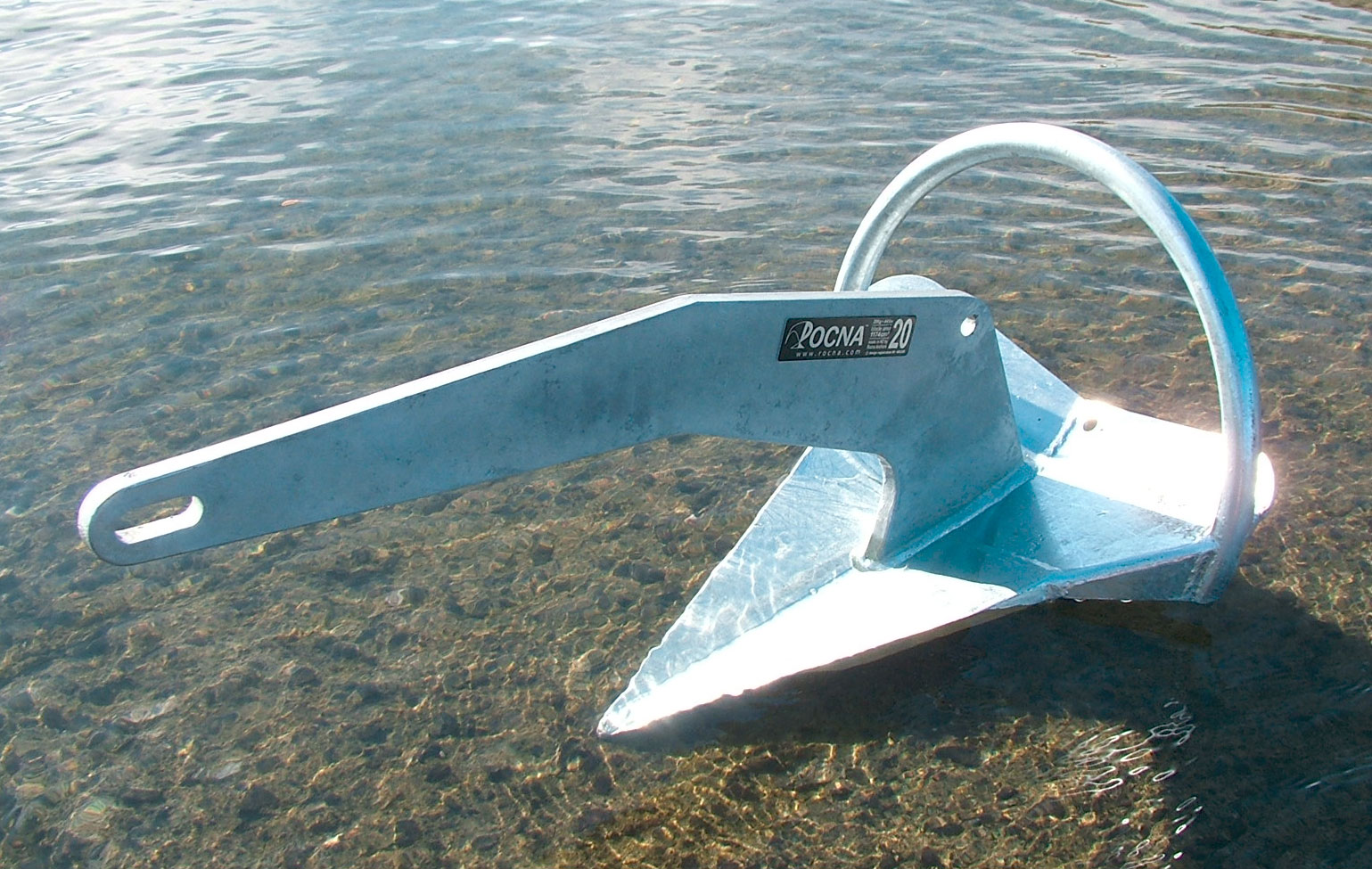
Plow with Roll Bars
Modern designs like the Rocna and Spade incorporate a plow form on the blades, coupled with a roll bar. These have fantastic holding power and set easily. They don't fit as well on some older boats, and are more expensive.
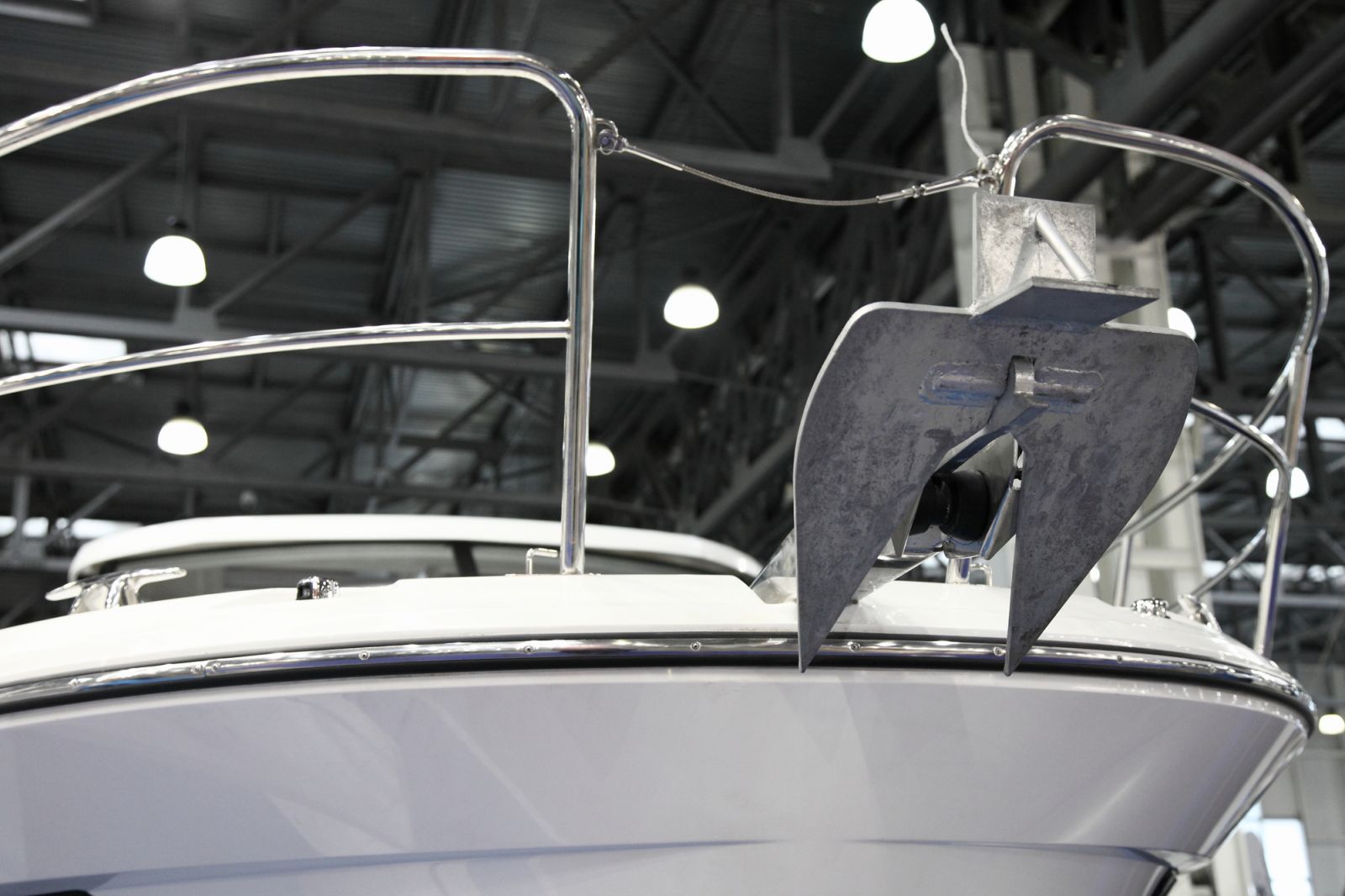
Fluke anchor
The fluke anchors are great in mud and sand, but don't do as well with bottoms they can't penetrate or grass. The Danforth (and its clones) are popular with smaller boats, and the lightweight aluminum Fortress is a favorite with weight conscious ravers.
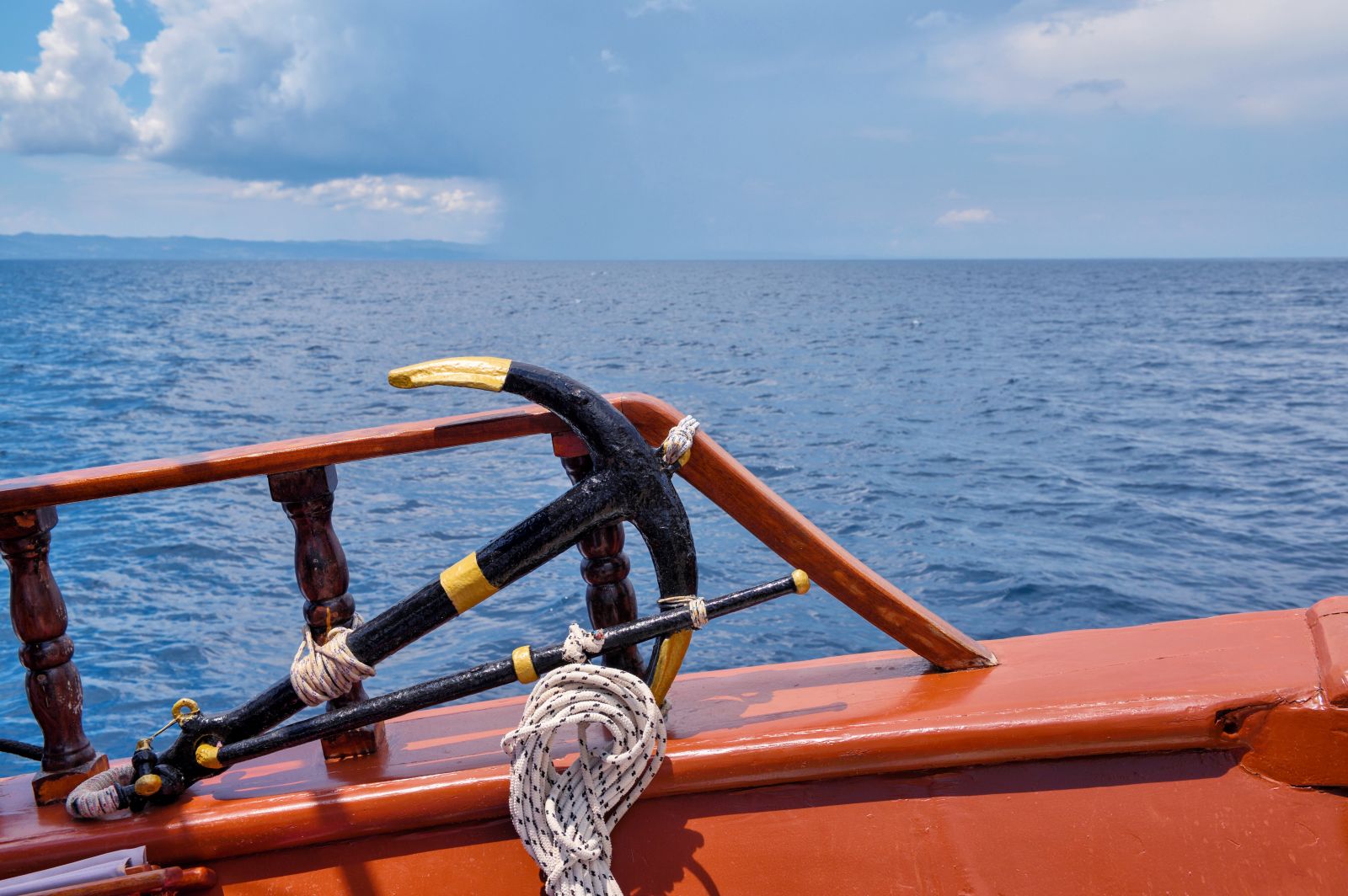
Fisherman's anchor
The traditional crossbar and hooks anchor is good for rocks. Some break down for storage, which makes them a popular choice for a storm anchor.
Grapnel anchor
Grapnels are fine anchors for dinghies, kayaks, PWCs and other small, light craft but don't do well with higher loads and larger boats.
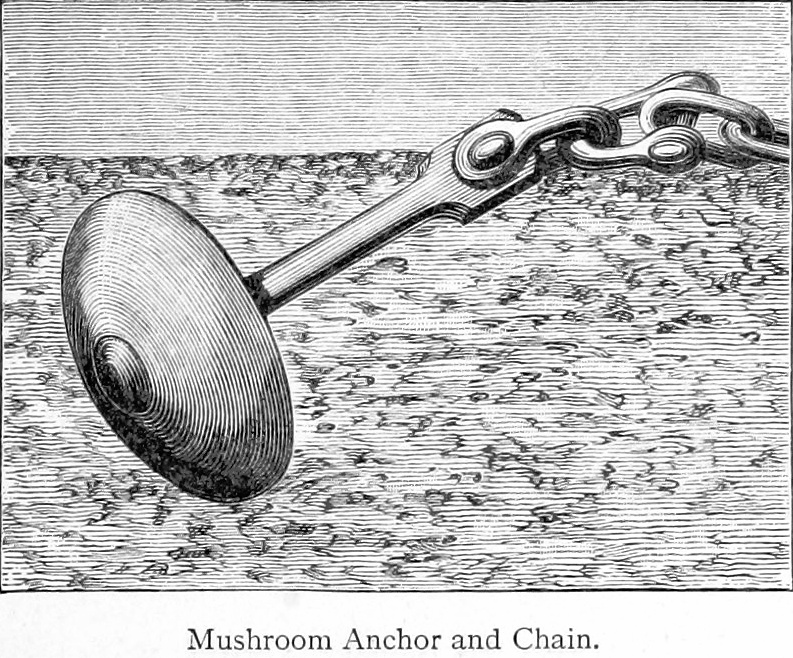
Mushroom anchor
Small mushroom anchors can hold a small craft like a dinghy or kayak. Many permanent moorings are large mushroom anchors, where they can dig deep into the bottom. But they are not suitable for big boat use.
Other alternatives
This list isn't exhaustive. There is constant innovation in anchor technology, from the Bulwagga to various box anchors, which don't even look much like anchors as we think of them. All have their strengths and weaknesses, so research carefully and try to find someone with real-world experiences with them.
Remember, there is no "right" or perfect anchor, so look at a lot of options to see what fits your boating style.
The basic decisions you have to make about your anchor are the style, size, and material of your anchor. While we can't get into every type of anchor on the market and how it works for every boat, we can give you an overview of the decisions you must make.
What fits on your boat?
If you're adding a new anchor to an existing boat, you may have some natural limitations on what anchors you may choose.
With a bow roller sized for a plow or a nice Danforth bracket installed already, maybe those features limit your choices. You may switch between a CQR and a Delta with that anchor roller, but there's a good chance you can't fit a Rocna's roll bar up there without bending something. You could probably switch a Fortress out for a Danforth in that bracket, but you can not hang a plow from it.
Most anchor manufacturers give dimensional drawings of their products on their websites, so measure and even mock up something to see if it will go. On my boat, I shoved a Manson Supreme where a CQR went, but not without permanently bending a retaining pin. And I mocked the whole thing up in cardboard ahead of time to be sure.
Where will you anchor?
The range of where boat affects what to have in your bow locker. If you're a Chesapeake Bay sailor and you don't leave the bay, something that holds well in mud is a must and may be all you need. But a world cruiser needs something more effective across a range of bottom types.
Give careful thought to the places you’ll want to spend the night on your boat, especially the bottom types you'll find. In the end, you'll likely have more than one anchor, and you want to cover most of the holding types you'll encounter.
Choose your materials based on budget and style
This is a matter of budget and style, mostly. As a cruiser who spends almost every night at anchor, I can't see the sense of spending a fortune on a pretty anchor that spends most of its life hidden. But for some, adding that high gloss show to the bow of a Bristol condition yacht everyone can see most of the time, the aesthetic choice may make more sense.
When I raced, I had a Fortress because it met the requirements to have an anchor, but I ended up spending a couple of nights on it. It was easy to move around, but for vacations I still dragged the 35 lb. CQR out of the shed and put it in the bow locker.
Size your anchor based on boat length and weight
Sizing your anchor is most people's biggest worry. Remember, it's better to have too much anchor instead of not enough. You want to sleep soundly and leave your boat without worrying. If you're hauling your anchor up without a windlass, the extra pounds matter a lot more, but it's better to have extra.
It's not as hard as you think to size your anchor, because every single manufacturer publishes a guide to how to select the right product for your boat. Most of them have tables for boat length and boat weight, and we talked up above about how a boat's weight and windage affect anchor loads.
To size your anchor, follow these steps.
- Search the "by length" table for the length of your boat, and note the recommended size.
- Search for the weight of your boat, and note the recommended size.
- The correct anchor size for your boat is the larger of those two recommendations.
If they give a single number in the table, choose the next number above yours. If they use ranges and your boat is on the edge of a weight or length range, there's no harm in moving to the next size band. Don't move down bands; you don't want to undersize.
For an example, look at this sizing table for Spade Anchors. We've going to pick an anchor for a boat which is 53' long and weighs about 54,000 lbs.
Source: Anchor sizing chart on Spade Anchor USA
You'll see a boat length of 53' puts us at 59ft. and a 55 pound galvanized anchor. But by vessel weight, for 54,000 lbs., the recommended weight is 99 pounds.
So the larger of the two is 99 lbs., so that is the proper weight for this boat.
Most boats should have more than one anchor, so you will go through this process several times. You may need multiple anchors for the different bottom conditions you may come across. If you foul an anchor or lose one, a spare anchor and rode can literally be a lifesaver.
Other reasons for multiple anchors include a lighter anchor for a "lunch hook," though with an electric windlass this isn't much of a concern on bigger boats. You may want a smaller stern anchor in case you need to anchor where you don't want to swing, or it's important to keep your bow facing a direction other than into the wind. And finally, if you plan to cruise far from your home port, you may want a storm anchor.
Any of the anchor types we've discussed will fill many of the above roles, and you can use these tools to evaluate your boat and your plans to make the best choice for each job.
The next step is to select the right ground tackle. Ground tackle consists of everything that connects the anchor to your boat and is used to control the angle of attack, scope, and drag by adding or removing weight to the anchor.
I've written a detailed guide to help you to understand ground tackle in depth , which will help you select the perfect parts yourself.
Leave a comment
You may also like, how to measure your anchor chain size (two ways).
Buying new anchor your chain for your boat can be more complex than it sounds. You can't just walk into a marine store and order "A hundred meters of your best." …
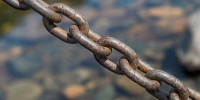
How to Select and Install the Right Anchor Rode
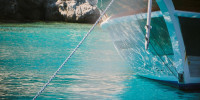
How To Mark & Measure Anchor Chain & Rode (3 Ways)
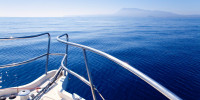
Guide to Anchoring Ground Tackle - parts, checks, deployment
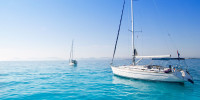
How Much Anchor Chain Should You Let Out When Anchoring?
Own your first boat within a year on any budget.
A sailboat doesn't have to be expensive if you know what you're doing. If you want to learn how to make your sailing dream reality within a year, leave your email and I'll send you free updates . I don't like spam - I will only send helpful content.
Ready to Own Your First Boat?
Just tell us the best email address to send your tips to:
Welcome to Worry-free Anchoring
When looking for an anchor you want to make sure it digs in the first time, buries deep, has high holding power and holds when winds or currents shift.
For sailboats we have taken every bit of windage, shape and weight distribution into consideration. This all affects how the anchor launches, sets and re-sets.
We have a good range of sailboat anchors to suit all boating adventures, keeping your family safe and ensuring your anchoring experience is stress free.
The right sailboat anchor will depend on the type and size of your sailboat, where you plan to go sailing, and the weather conditions that you expect to encounter. If you are not sure which anchor is right for you, use our simple anchor calculator – link below.
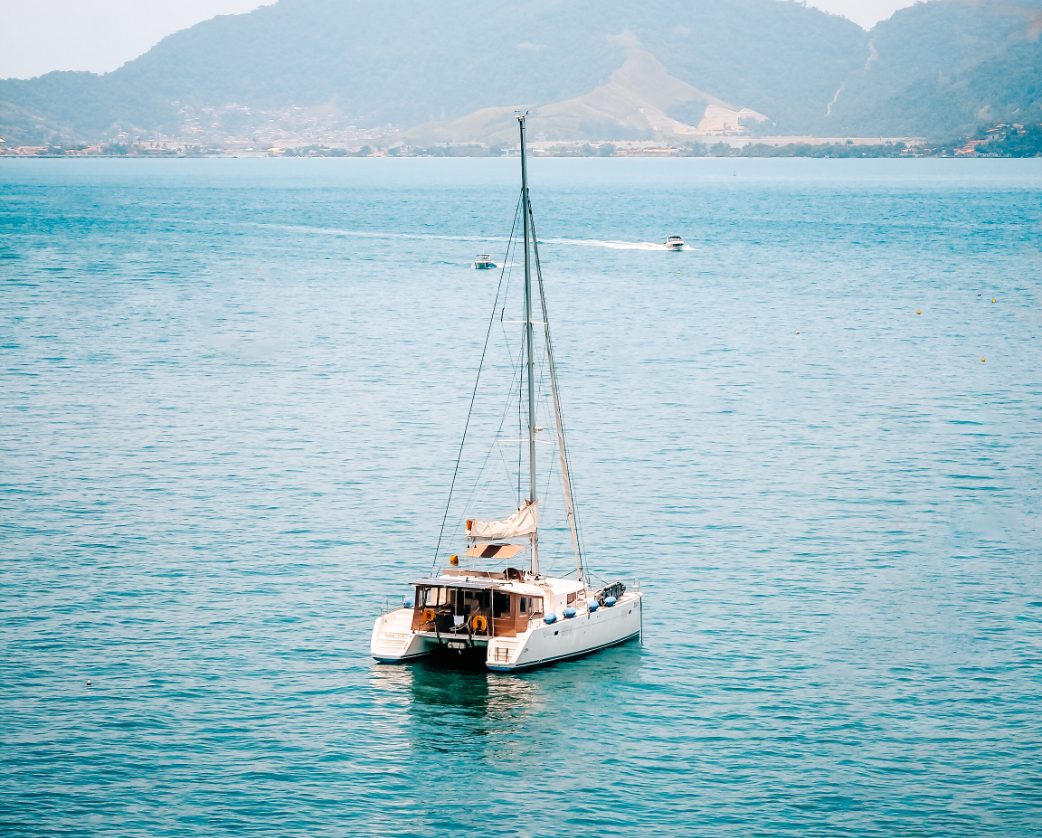
Sailboat Anchor Range
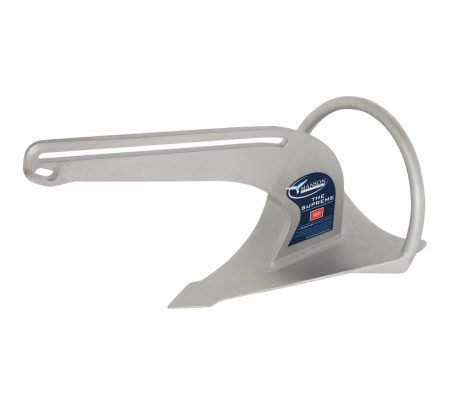
Supreme Anchor (SHHP)

12 Sizes: 5 - 150lbs
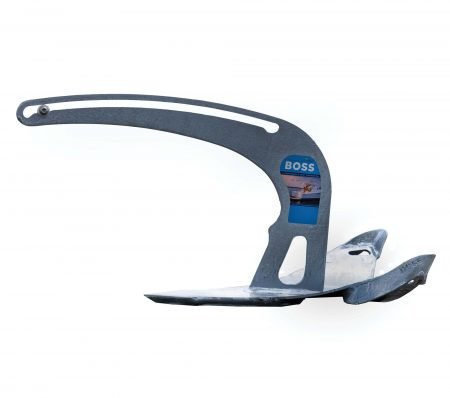
Boss Anchor
11 Sizes: 5 - 150lbs
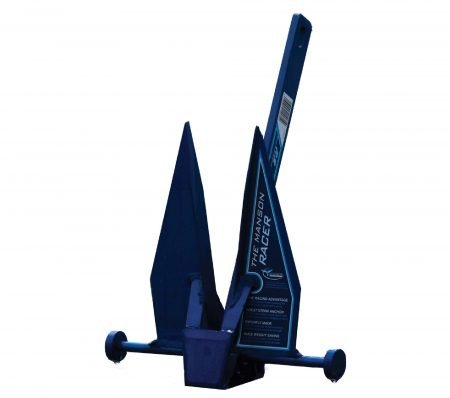
Racer Anchor
10 Sizes: 2.2 - 35lbs
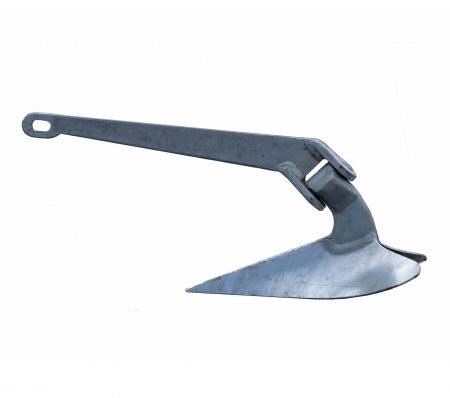
Plough Anchor (HHP)
17 Sizes: 10 - 300lbs

Ray Anchor (HHP)
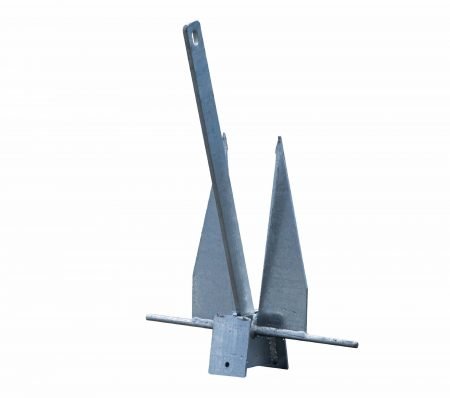
Sand Anchor
What size anchor do i need, the manson anchor difference, why buy a manson anchor.

Global Leader
We are the experts in anchoring. We’ve been doing this since 1972, that’s almost 50 years’ experience making anchors. We are the desired anchor brand, chosen by serious boaters all over the world; from the rugged coastlines of Western Australia, to Florida and the Mediterranean. You are in safe hands.

Largest Range in the World
We understand the unique challenges of anchoring and we know all boats are not equal, so we design and build anchors to suit every situation – from small craft through to superyachts. Don’t settle for a standard anchor. Get the anchor that will be perfect for your boating needs and keep you and your family safe.

Made in New Zealand
Our anchors are proudly crafted in New Zealand by Lloyd’s Register approved welders using certified Lloyd’s Register approved materials in a specialist facility. They are not made cheaply in developing countries who have little respect for quality, the environment or what it means to anchor safely. This means you are buying a quality anchor that you can rely on.

We are trusted to make anchors for some of the best shipyards in the world who build exquisite superyachts and sophisticated defense vessels. This means that you’re buying the same brand selected by superyacht owners and their captains. Simply put, you are choosing an anchor from the world’s leading anchor brand. Anchor with the world’s best.
What our customers say about us

David Forester
Mississippi, usa.
I would like to tell you that 25LB Manson Supreme held my 23’ Pro Line Walk around like it was nothing. Where I anchored is a lot of sand, the anchor caught right away and the wind and waves that buffeted the boat around did not budge it. The fluke anchor I have would always slip, and I would have to reset the anchorage. I can safely say this is the best anchor I have ever had. I am so impressed I am looking into a smaller one for my stern (second) anchor.
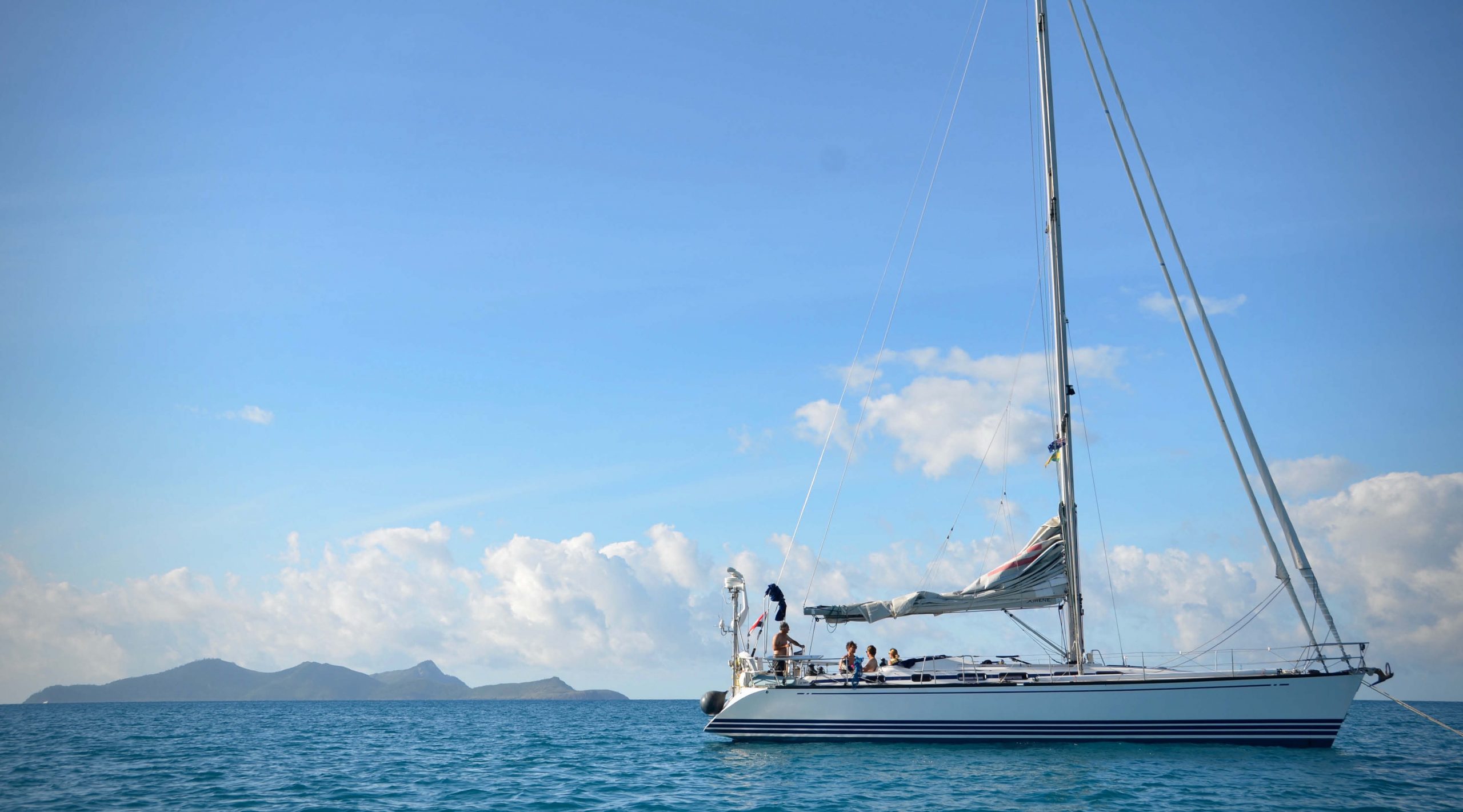
Graham McKenzie
Wellington, new zealand.
In the 6 & 1/2 years we have travelled more than 45,000 miles, visited 26 countries, and have anchored at least 1000 times. We have yet to use any other anchor than our Manson Plough. It has been totally reliable in thin coral sands, in mud and in the treacherous grasses of the Mediterranean. Most of our cruising friends changed their anchoring tackle after disastrous anchoring experiences in the Med. Many were using locally made anchors. We never needed to consider a new option. The Manson also coped well in areas with strong tidal flow, such as the amazon with it’s 7 knot current. We have had the chain re-galvanized twice in the course of our travels, but the anchor is only just requiring attention. Thanks to you folks at Manson for an anchor that has truly passed the test of time… and distance.
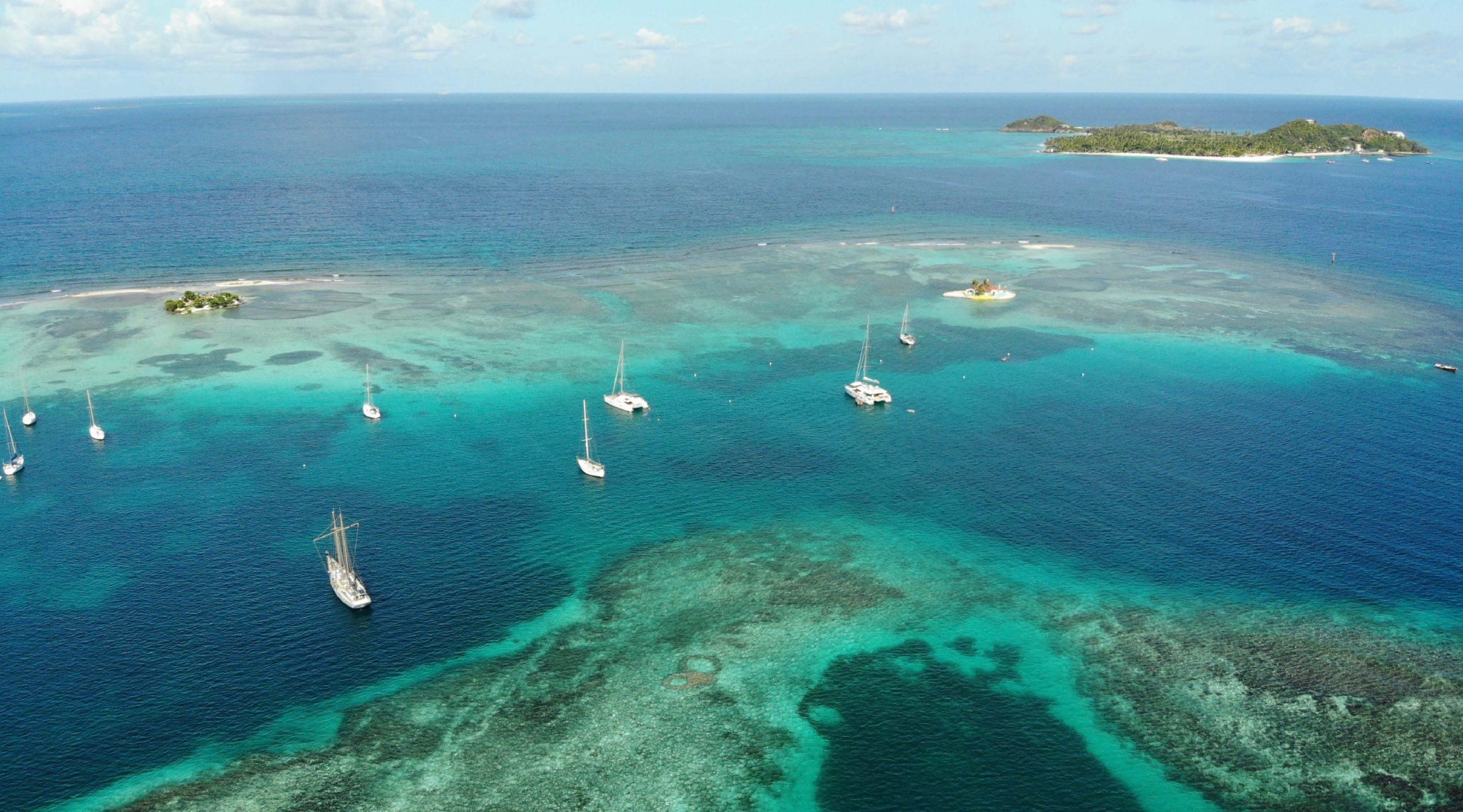
Brian Holloway
New zealand.
We were just starting on our adventure, which turned into the most exciting six month trip I have ever undertaken. We travelled over 4000 nautical miles, completely circumnavigating New Zealand in the wake of Captain Cook. What was interesting in that in the whole of the six months we only spent 15 nights at sea. My aim was to see New Zealand, and we rock hopped visiting everywhere possible, and consequently anchoring most nights. I have a 35lb Manson Supreme holding a 35 foot catamaran, weighing 5 tons. We make a reasonable amount of windage. I felt that a 35lb looked a bit small, but in six months, on very varied types of bottoms there was not one night when we dragged. A marvellous anchor, that I would recommend to anyone.
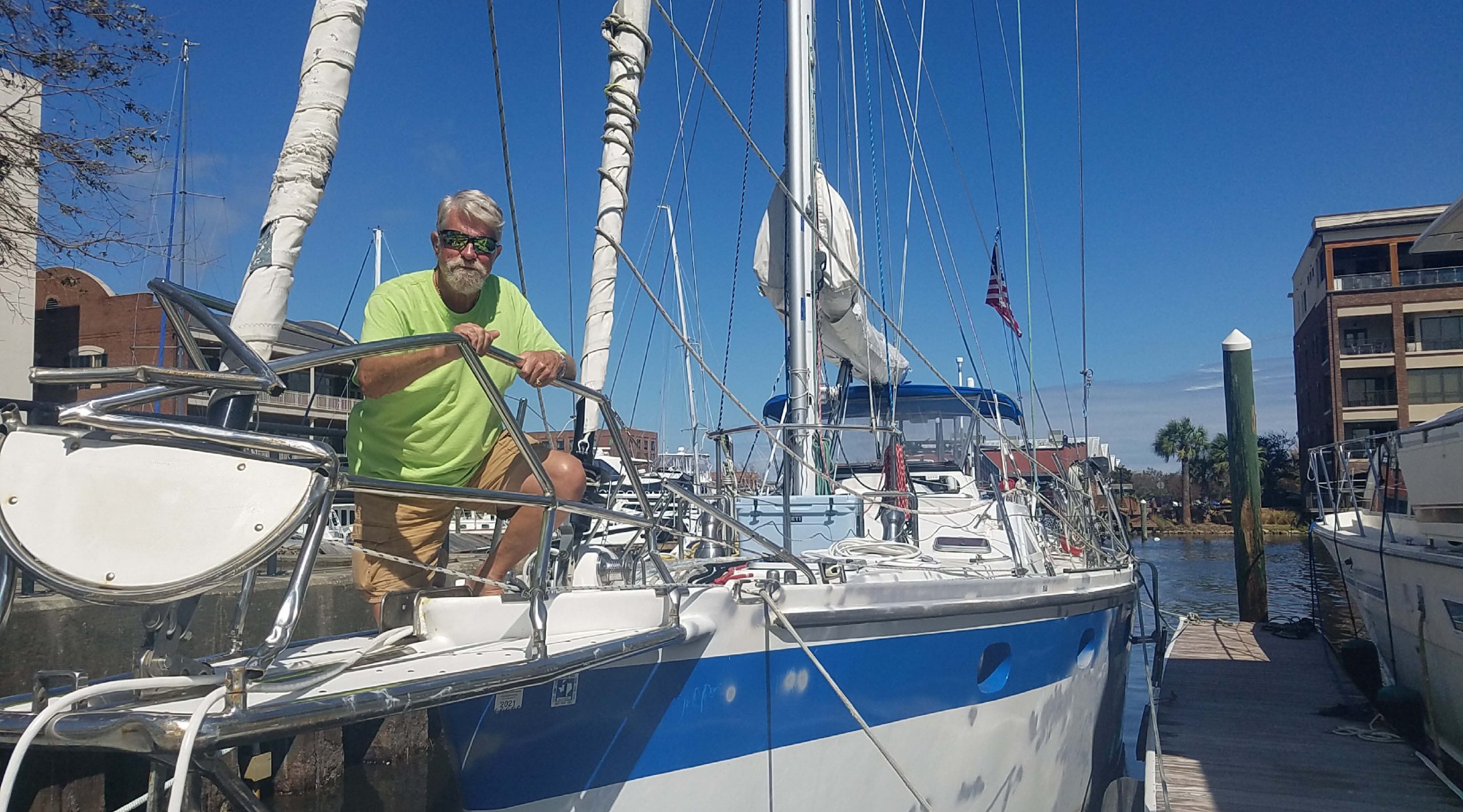
FLORIDA, USA
Thanks to my Manson Supreme I survived Hurricane Sally in Florida. As winds reached 110mph there was an incredible amount of force at work, but my 80lb Manson Supreme held my Roberts DS440 steel sailboat, while I watched boats around me sink. I was very impressed and grateful. When the winds subsided, we found we had bent shackles and bent rollers, but the anchor was in perfect condition.
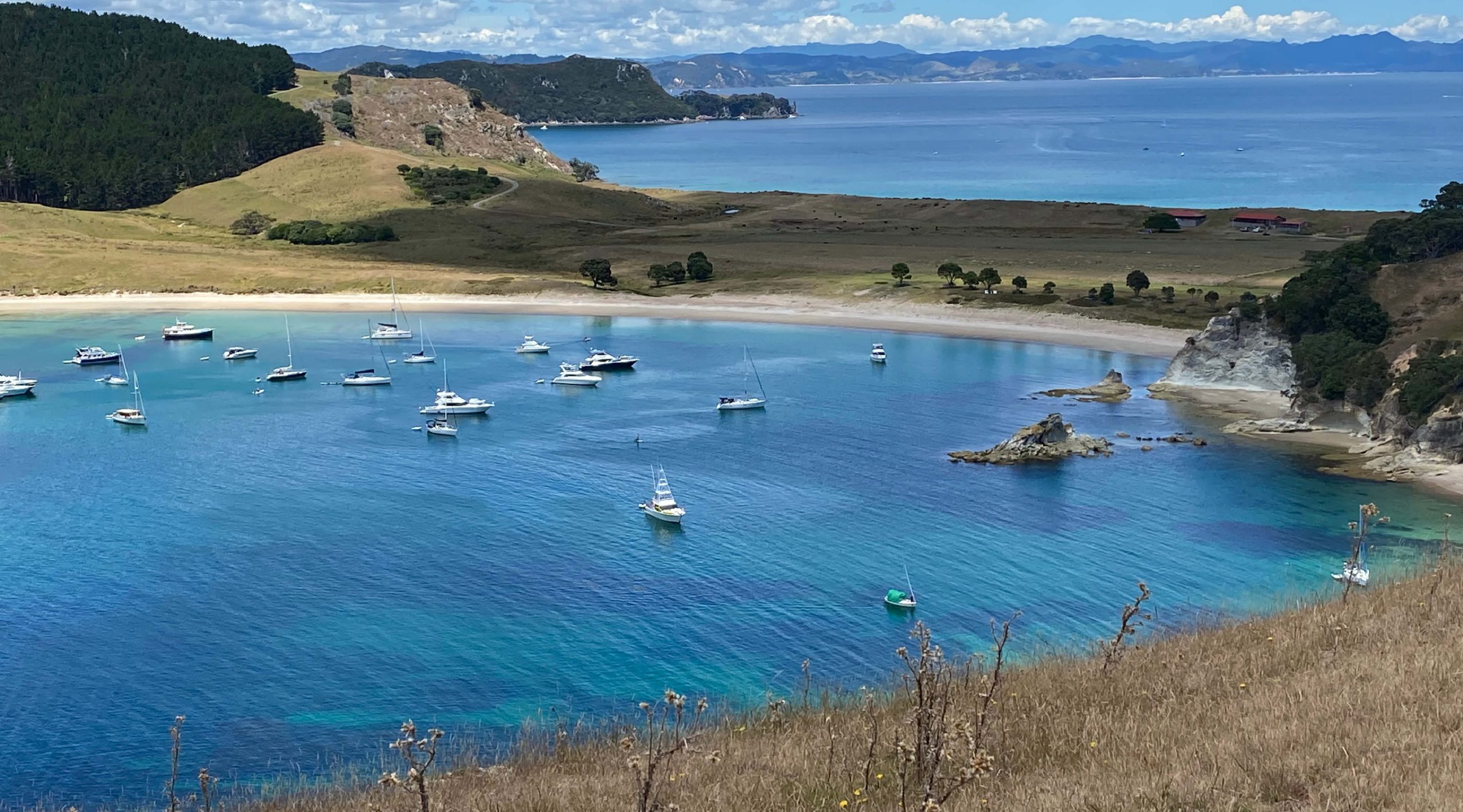
Tom McCallum
Auckland, new zealand.
My 15lb Manson Supreme provided a heroic task in holding my 6 ton yacht all night in hurricane conditions in a bay with bad press on its seabed. Needless to say my faith in these anchors is profound and their design and tenacity legendary. I would use no other.
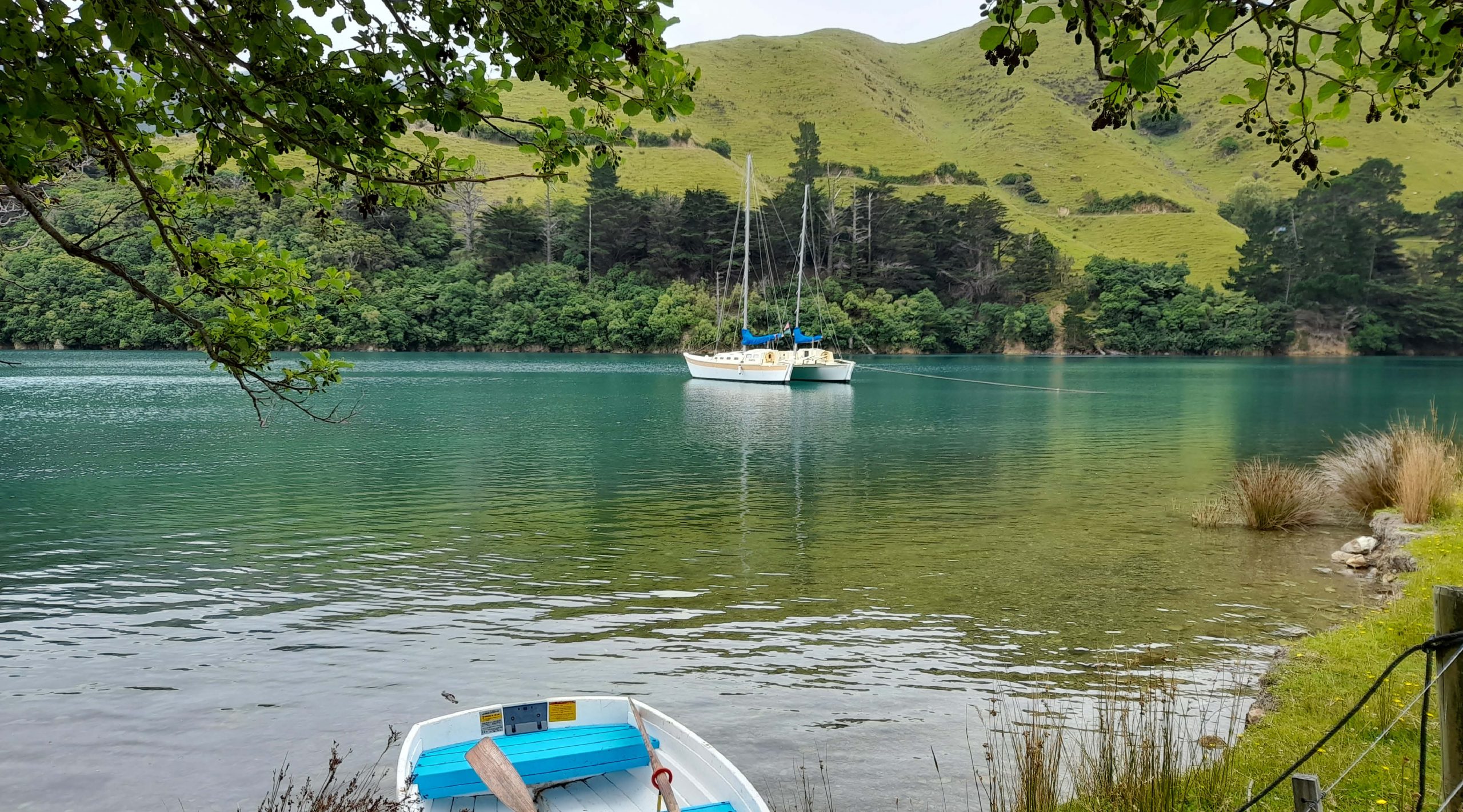
Colin Goldsworthy
We were caught out at Wangaparpara in what I would call a cyclone. It caught us off guard. We had a lee shore, a short scope, in poor holding with only 2 meters under the keel. We had no time to put down a second anchor.
During the next two days we experienced extreme gusts coming off the hills with swell entering the Harbour. That evening there was 95 knots gusts recorded at Channel Island. Our boat is 48 foot, and has plenty of windage. She sails on her anchor. We would sail up, go broadside and then get laid over with the gusts and swell beam on. Your anchor did not budge. The first night I sat and anchor watched, but the second night I was more confident and I slept.
That night many boats dragged their moorings and ended up on the beach. Your Supreme Anchor is great insurance.
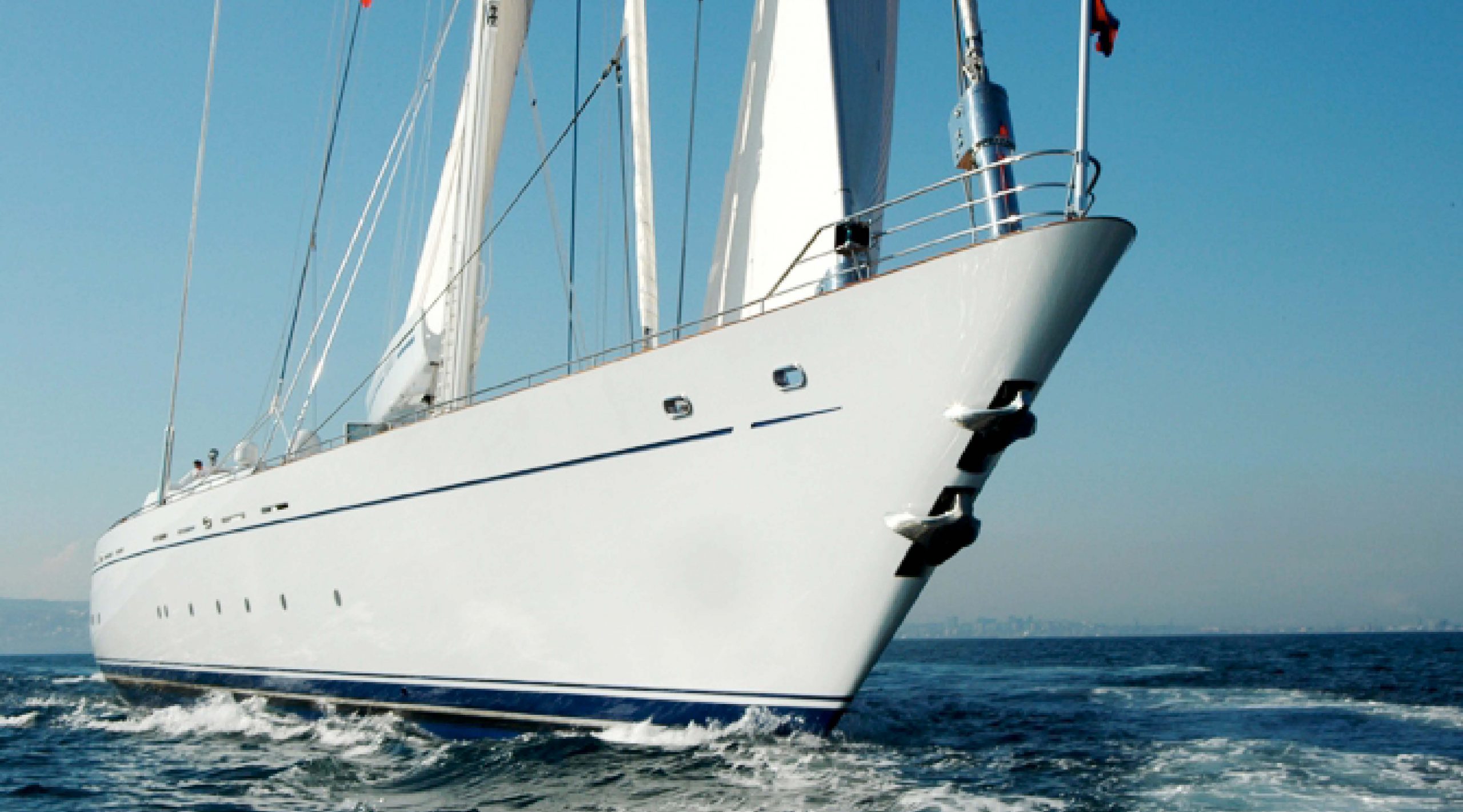
NZ Trade and Enterprise
Manson Anchors took a basic component of every boat, and considerably redesigned it to be not only aesthetically pleasing but a real feature on one of the best yachts in the world. This is a real skill and shows again New Zealanders’ ability to create a design that not only solves a problem but does so very eloquently indeed
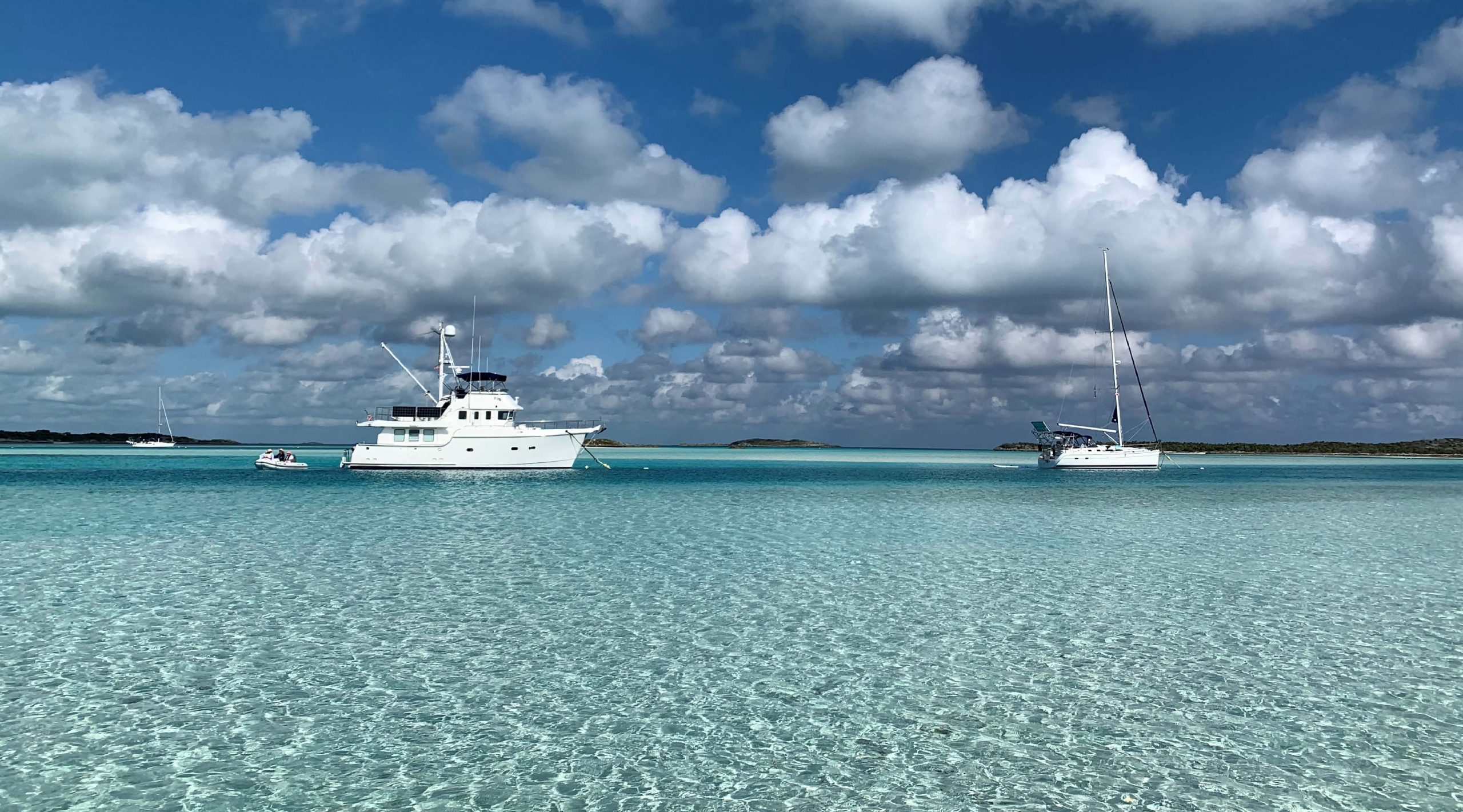
Brian Bearden
New providence, bahamas.
The Manson Supreme is reliable. Sets quickly, resets quickly, usually no more than the anchors length. Happy in mud, sand, grass. Best anchor we have ever had. Rode out hurricane Joaquin (25 miles west of the eye) anchor didn’t budge in sustained winds of 85 knots. We used this anchor as our main and storm anchor.

Aaron Dixon
I have toured the Manson factory on many occasions and have witnesses first-hand the quality of workmanship in full swing. The attention to detail they take in the selection of the metals, fabrication processes, welding and casting is amazing. Any vessel I own will always be fitted with a Manson Anchor.
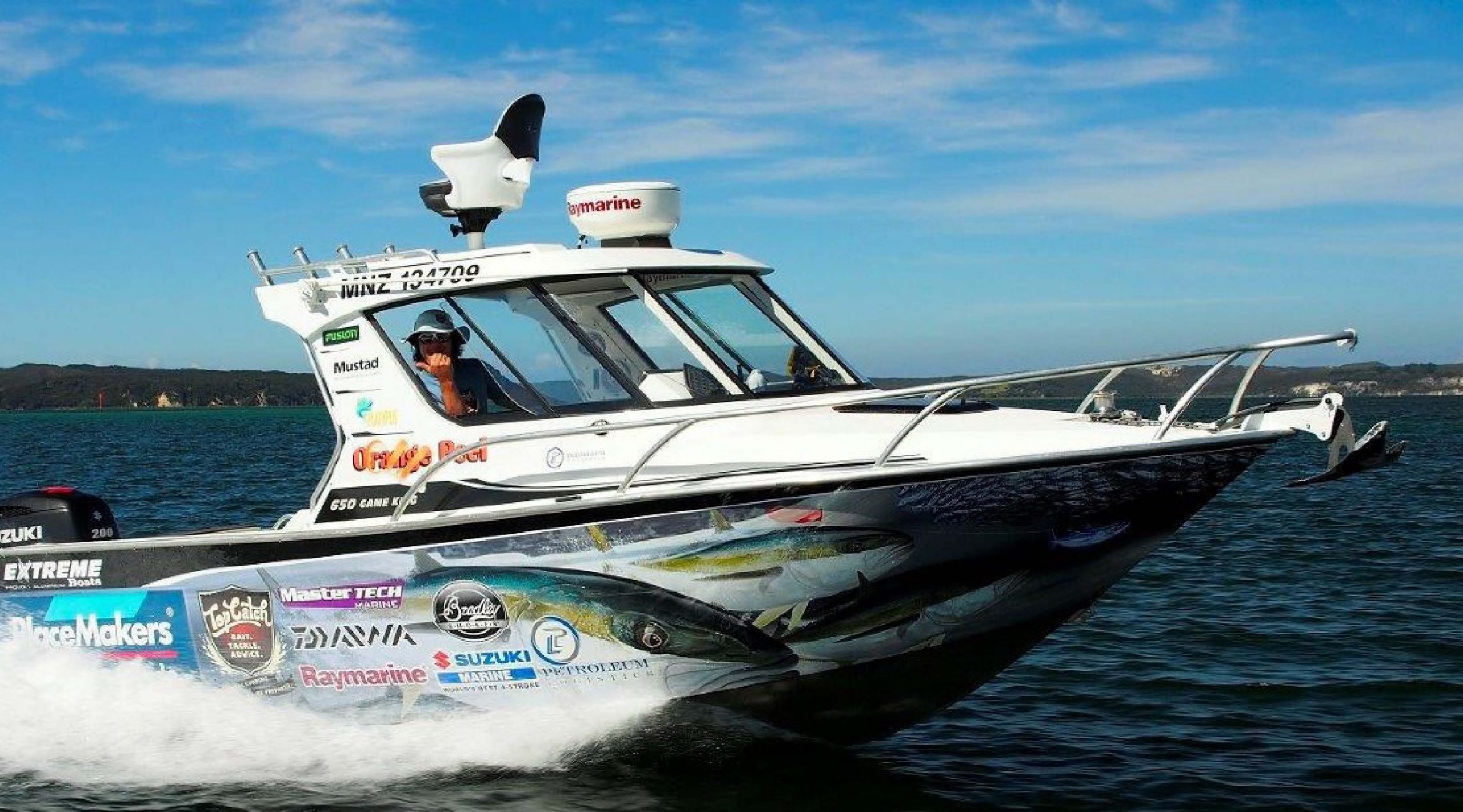
Big Angry Fish
The holding power of the Manson Boss will help you stay on that perfect fishing spot regardless of the conditions.
The Manson Anchor will dig in first time so you can get lines over the side straight away.
The sliding shaft is a great feature that makes it so much easier to retrieve the anchor from foul ground.
It is so important for every fisherman to have a good anchor onboard, we recommended the Manson Boss to everyone!
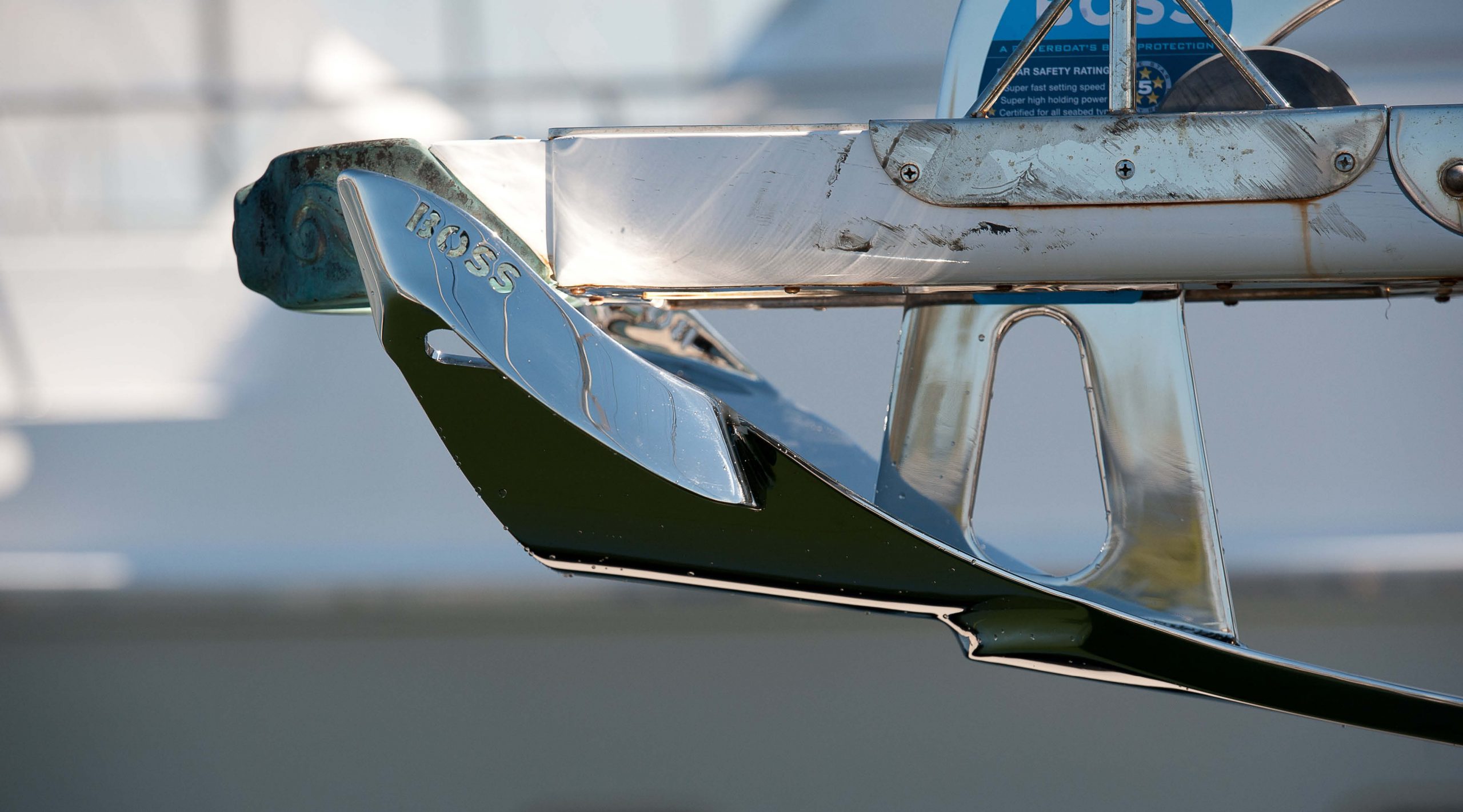
West Marine
The Boss takes the performance of the Supreme and makes it conform to any bow-roller. The Boss works well on power and fishing boats that don’t work with the bow.
The winglets work as a bow-roller to ensure a reliable and quick setting anchor much like the Supreme.
This is an incredibly fast setting, high holding power anchor.
Joe Biden’s new ‘boat anchor’ shoes meant for maximum ‘stability’ as president’s falls spark concern
- View Author Archive
- Get author RSS feed
Thanks for contacting us. We've received your submission.
It’s gotta be the shoes.
President Biden’s new footwear has fed rumors that the 81-year-old incumbent needs extra stability following a series of falls and stumbles .
Biden has recently been photographed sporting a black pair of Hoka Transport sneakers with his formal suits rather than more traditional dress shoes.
The Hokas are meant for “hiking,” “walking” and “lifestyle” and feature a “quick-toggle lace … designed for easy on and off,” according to the product website — which offers the shoes for between $150 and $200 per pair and also advertises “neutral” stability for wearers who want “a symmetrical bed of cushion.”
The sneakers also boast a seal of approval from the American Podiatric Association as being good for foot health, a benefit which could come in handy for Biden after his recent physical revealed he suffers from a “stiffened gait.”
Eagle-eyed observers first noticed the new shoes in late February, about the same time the president received his annual exam.
Social media users have been quick to wonder if the sneakers were prescribed to mitigate the president’s several falls .

Biden has especially struggled going up and down the steps of Air Force One, repeatedly slipping and stumbling while ascending to and descending from his official plane .
After a series of near-pratfalls, the president has opted to use retractable stairs at the back of the plane for boarding — rather than the regular longer steps at the front of the aircraft.
Start your day with all you need to know
Morning Report delivers the latest news, videos, photos and more.
Thanks for signing up!
Please provide a valid email address.
By clicking above you agree to the Terms of Use and Privacy Policy .
Never miss a story.
Biden’s slips culminated in an ugly tumble at the Air Force Academy commencement exercises in June last year, in which he tripped on a sandbag and fell heavily to the stage.

Politico first reported on Biden’s increasing use of tennis shoes back in January, citing a source close to the president who said Biden used to “resist” wearing the casual shoes because he was concerned about not looking presidential enough — but eventually conceded for reasons of comfort.
White House deputy press secretary Andrew Bates claimed Wednesday that Biden uses the active footwear to help him stay fit.
“I know y’all aren’t partial to presidents who exercise, but don’t worry — you’ll get used to it,” Bates told The Post, apparently alluding to former President Donald Trump.
Biden participates in physical therapy to increase his “core stability” at least “four to five times a week,” according to the report from his annual physical.
Share this article:

Advertisement

IMAGES
VIDEO
COMMENTS
The goal is to get the anchor to pull at 15° to 20°. Once sufficient chain has been let out, secure the anchor chain on deck. Now we have to wait for the anchor to dig in and take its initial set. Once you have the initial set, begin slowly moving astern until the anchor chain straightens out.
The basics of anchoring in calm conditions in an anchorage with good holding aren't difficult to master, and you should start with basic anchoring techniques if you haven't read it already and practiced setting your hook.. This article is for when anchoring isn't so easy, but you still have to stop your boat and stay secure.
Total depth for scope calculation: 24 feet. So setting your scope at 7:1, you will need to let out 154 feet (24 x 7). For all chain, you can use 5:1 which is 120 feet (24 x 5). Anchoring in Lakes and Rivers: if you are anchoring some place without tides, you can skip the tide swing estimation.
When you have about 3 times as much anchor rode out as the water depth (a scope of 3 to 1), temporarily cleat or cinch the anchor rode at the bow and let it pull tight. Keep a hand on the rode to feel the tension. The boat should stop and the rode feel very tight, indicating the anchor has set.
The rule of thumb to determine rope diameter for an anchor rode is to allow 1/8" for every 9 foot of boat length. Using this equation, a 28-foot boat would use a ½" line. However, if your boat is full keel or tends to drift in the wind when on anchor then it is recommended to go up at least one rope size.
The Step-by-Step Guide to Anchoring Your Sailboat. Follow these instructions, and you'll be able to safely and effectively anchor your boat in no time. 1. Choose your anchor location. Before you start the process, select a suitable location to drop your anchor. Consider factors such as water depth, bottom conditions, and nearby hazards.
SIX STEPS TO SUCCESSFUL ANCHORING. How to anchor? What anchor should I choose? Is there a best anchor? In "How to anchor a sailboat" we take you through the ...
Kevin Wensley, Director of Operations of the Offshore Sailing School,demonstrates how to properly anchor a sailboat.To view over 15,000 other how-to,DIY, and...
To arrive at the right length of rode to let out, you add the height of the boat's bow above the water to the depth. For example, if the depth is 10 feet and the freeboard at the bow is 4 feet, the length of rode needed for 7:1 scope will be (10 + 4) x 7 = 98 feet. TIP: "When in doubt let in out" works well in anchoring.
Locate the spot you want to anchor, preferably a sandy patch. Navigate to your place and set the boat up against the wind. Aim at your spot and drop the anchor at the bullseye. Pay out your scope of chain and rig up your snubber or bridle. Tension up the chain and set the anchor. Test your ground tackle's holding.
Bow Anchoring: This is the most common form of anchoring where the anchor is deployed from the bow of the boat. This technique is typically used because the bow is designed to cut through waves and is generally the most seaworthy end of the boat. Stern Anchoring: This technique is used when you want the stern of the boat facing the shore. This ...
Anchoring a sailboat is a crucial skill that every sailor should master. Proper anchoring ensures the safety and stability of the boat, allowing you to relax and enjoy your time on the water. In this article, we will explore the importance of anchoring a sailboat and provide you with a step-by-step guide on how to do it effectively.
For example, anchoring a 24-feet sailing boat on a muddy bottom will not be the same when using the same anchor when anchoring a 49-feet sailboat on a rocky bottom. More importantly, choosing the best sailboat is all about finding the right balance in terms of the size of your boat, the type of the bottom where you're sailing at, the climate ...
Different Types of Sailboats and Anchoring Needs. The anchoring requirements of a sailboat vary widely depending on its type and size. Smaller boats like dinghies require lightweight, easy-to-handle anchors, while larger vessels like cruising yachts necessitate robust anchoring systems due to their higher windage and weight.
The boat anchor should be correctly sized for your boat. For instance, a typical 32-foot medium displacement boat could put out a 25-pound CQR or a 22-pound Delta and be comfortable in 30 knots of wind. A 12-pound Hi-Tensile Danforth is another option. One size up would be nice, especially if you have a power windlass to do all the work.
When you drop anchor, make sure that your swing circle does not intersect the swing-circle of another boat. Keep well clear of shoals (shallow water) or land downwind of your chosen anchor spot. Calculate the amount of anchor rode you need for safety. Allow 7 feet of rode for each foot of water depth-called "scope".
Get it wrong, and your boat could wind up on the beach in a bad blow. Ground tackle is a complete system, including the anchor itself, the rode (chain, rope, or some combination thereof, which connects the anchor to the boat), and the windlass (or other means of retrieval). Remember this: Good ground tackle can overcome poor anchoring technique ...
Continuing our anchoring series, check out this video on lowering, setting, and raising your anchor. You'll learn important tips and techniques on how to mak...
Importance of proper anchoring. Anchoring your boat overnight is a vital skill that every boater should know. Proper anchoring ensures your boat's safety and prevents drifting caused by changing wind and tide conditions. When anchored correctly, your boat stays securely in place throughout the night, giving you peace of mind while you rest.
1. Rocna Vulcan Galvanized Anchor. One of the best sailboat anchors out there today based on being the best-selling anchor for yachts and workboats goes to the Rocna Vulcan Galvanized Anchor. As one of the pioneering brands for sailboat anchors, the Rocna Vulcan was able to transform from the original Rocna anchor to the most dependable, best ...
Much to our surprise, the weight recommendations for the new designs, Rocna, Excel, Supreme, etc. are very similar to the weight recommendation for the older, traditional models, CQR, Delta, Bruce etc. In both cases, the recommendation for a 35-foot yacht is approximately a 30-pound anchor. The exceptions are aluminum anchors from Fortress and ...
165 lbs. N/A. Source: Anchor sizing chart on Spade Anchor USA. You'll see a boat length of 53' puts us at 59ft. and a 55 pound galvanized anchor. But by vessel weight, for 54,000 lbs., the recommended weight is 99 pounds. So the larger of the two is 99 lbs., so that is the proper weight for this boat.
When looking for an anchor you want to make sure it digs in the first time, buries deep, has high holding power and holds when winds or currents shift. For sailboats we have taken every bit of windage, shape and weight distribution into consideration. This all affects how the anchor launches, sets and re-sets.
It's gotta be the shoes. President Biden's new footwear has fed rumors that the 81-year-old incumbent needs extra stability following a series of falls and stumbles.. Biden has recently been ...